Tim Notier's Blog, page 13
June 13, 2018
Costa Rica - Costly or Incredible?
By Marisa If you can't see the video, find it here. Before visiting Costa Rica, I had high very hopes for it. This was due to the fact that a number of my college friends went there and came back raving about it, several of whom had life-changing experiences. Their stories of colorful reefs and thick rainforests, their pictures of sloths and parrots, and those smiles that lit up their faces every time they thought back on it, it all made me think that Costa Rica was a safe, clean paradise of ecological wonders in the Central American region.
But that was a while ago, and I also heard more recently from fellow travelers that Costa Rica has become insanely touristy, extrmely expensive, and so overrun with wealthy Americans, that some people I'd talked to actually left the country early.
So when Tim and I rode our motorcycle zig-zagging across Costa Rica, I wasn’t quite sure if I was going to fall in love with it, or hate it.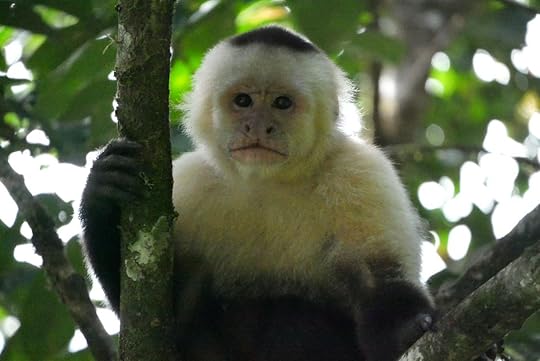 A capuchin monkey (also known as white-faced monkey) at Místico Hanging Gardens, Costa Rica. First Impressions The first thing that struck me about Costa Rica while coming across the border from Nicaragua, was the glass-fronted customs office with air-conditioning inside. Freshly-mopped floors, people were standing in lines, and there were signs on where to go. It was a real difference from the outdoor, grimy border crossings we were used to with begging children and computers from the 90's.
A capuchin monkey (also known as white-faced monkey) at Místico Hanging Gardens, Costa Rica. First Impressions The first thing that struck me about Costa Rica while coming across the border from Nicaragua, was the glass-fronted customs office with air-conditioning inside. Freshly-mopped floors, people were standing in lines, and there were signs on where to go. It was a real difference from the outdoor, grimy border crossings we were used to with begging children and computers from the 90's.
And then once our passports were stamped, the roads into the country were perfectly paved with clear painted lines, guard rails, good signage, even reflective strips! And the best part, no trash along the sides of the roads! After traveling through Central America for so long, this was all very welcome for us.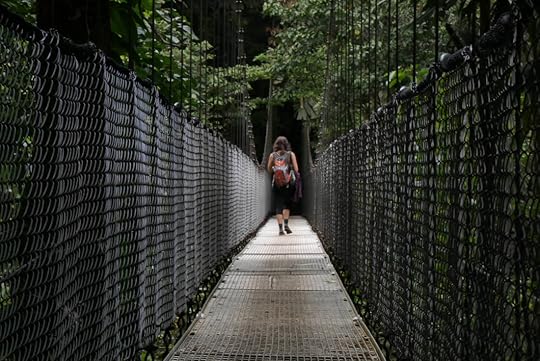 Me walking along one of the bridges at Místico Hanging Bridges Park in Costa Rica. Our first stop in Costa Rica was the famous Místico Hanging Gardens near Arenal Lake and Volcán Arenal. This well-maintained park has trails through an incredible section of rainforest, complete with hanging bridges that give you a unique perspective of the canopy. It is expensive for sure (we spent more than $50 to enter), and even though guides are highly recommended in order to point out the wildlife that you would otherwise miss, we simply could not afford a guide (would have been $80 for the two of us).
Me walking along one of the bridges at Místico Hanging Bridges Park in Costa Rica. Our first stop in Costa Rica was the famous Místico Hanging Gardens near Arenal Lake and Volcán Arenal. This well-maintained park has trails through an incredible section of rainforest, complete with hanging bridges that give you a unique perspective of the canopy. It is expensive for sure (we spent more than $50 to enter), and even though guides are highly recommended in order to point out the wildlife that you would otherwise miss, we simply could not afford a guide (would have been $80 for the two of us).
Luckily, we were still able to see white-faced monkeys, an owl, a python, but did not see the sloth of our dreams that we had been hoping for, but it's not a zoo, only the wild, so we just weren't lucky. Overall, I felt the experience was worth the money as a truly atmospheric introduction to the rainforest and all its majesty, but we left feeling a little unsatisfied, not just because we didn’t see a sloth and our pockets were now much emptier, but because this initial glimpse at Costa Rica proved to be the touristy, expensive, Disney World-like version that I had feared Costa Rica had become. Noemy's Farm If you can't see the gallery, you can check it out here. Thankfully, luck was again on our side, as our next stop was an Airbnb/Workaway organic farm run by a local woman named Noemy. This turned into the perfect antidote to our dissatisfaction of the Místico Hanging Gardens, because this farm had its own patch of rainforest full of sloths, huge iguanas, poisonous frogs, and incredibly-colored toucans. And because we were staying in a cabin tucked into the thick foliage, and were helping out with the garden, feeding the chickens, and shucking beans, we really felt that this was the authentic Costa Rican experience that we were looking for. The mornings were perfectly misty, the midday was steamy hot, and the evenings were glittering with the biggest fireflies I have ever seen. It felt magical, and we will forever cherish our time at Noemy’s farm. Cahuita and the Caribbean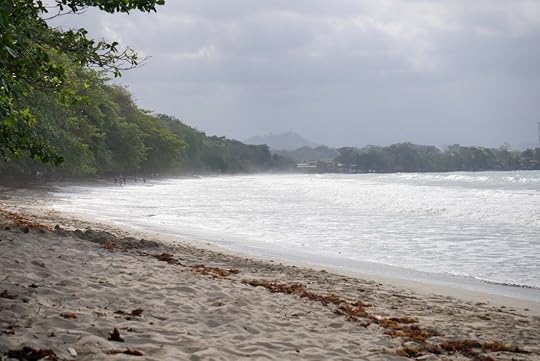
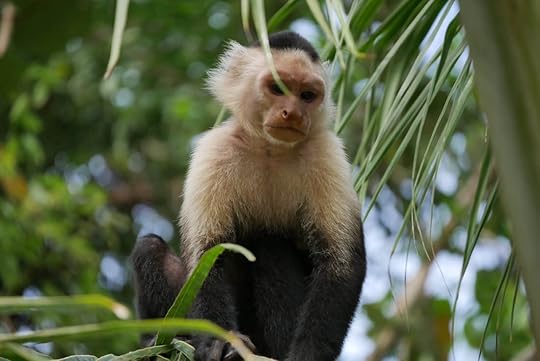 Since we had been hanging out in the jungle now for quite some time, we decided the perfect place to cool off would be the calm waters of the Caribbean coast. There are two major places that tourists mainly visit along Costa Rica’s Atlantic coastline: Limón, the larger resort-like port, and Cahuita, the laid-back Jamaican-style town next to a National Park by the same name. So of course, being more our pace, we set our tires straight for Cahuita.
Since we had been hanging out in the jungle now for quite some time, we decided the perfect place to cool off would be the calm waters of the Caribbean coast. There are two major places that tourists mainly visit along Costa Rica’s Atlantic coastline: Limón, the larger resort-like port, and Cahuita, the laid-back Jamaican-style town next to a National Park by the same name. So of course, being more our pace, we set our tires straight for Cahuita.
The town itself reminded me a bit of Playa Del Carmen in Mexico: an expensive beachside place completely built around the American tourists that come to spend their money, walk around in bathing suits, and get drunk. But Cahuita NP was a dream come true: a long stretch of coastal forest where capuchin monkeys are everywhere (and got quite up-close and personal to us), raccoons march around looking for food, and the swimming in the waves is truly heavenly. Cahuita National Park charges no fees (but takes donations), and was easily walkable from our hotel room. San Jose and its Surrounding Hills After all that farm work and swimming, we decided to take a week or more to get caught-up on our computer work and get the bike serviced. So after a very rainy ride to Costa Rica’s capital city, San José, we got a new front tire on the bike, Tim bought a new helmet that actually fit him, and then we spent a week in the hills at an Airbnb with a view out of this world.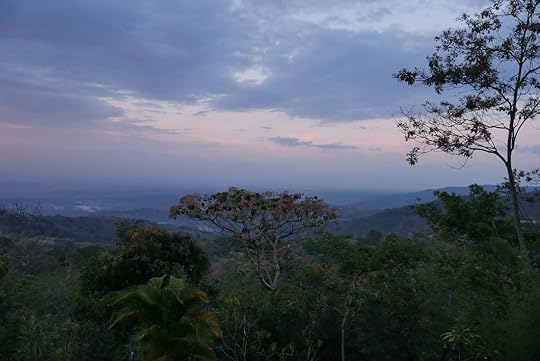 View near Puriscal, Costa Rica. At this point, I had made up my mind about whether I loved or hated Costa Rica, and I was definitely in the “I love it” camp. I was thoroughly convinced that although Costa Rica can be quite expensive, if you know where to look, it can be on-par with other Central American countries as far as cost. And again, once off the tourist track a bit, Costa Rica's national parks, forests, and coastlines are some of the best-maintained, cleanest, and most beautiful we have come across.
View near Puriscal, Costa Rica. At this point, I had made up my mind about whether I loved or hated Costa Rica, and I was definitely in the “I love it” camp. I was thoroughly convinced that although Costa Rica can be quite expensive, if you know where to look, it can be on-par with other Central American countries as far as cost. And again, once off the tourist track a bit, Costa Rica's national parks, forests, and coastlines are some of the best-maintained, cleanest, and most beautiful we have come across.
Our time in Costa Rica was coming to a close, so in order to complete our Costa Rica experience before heading into Panama, we wanted to go to a place that everyone recommended: Marino Ballena National Park on the Pacific Coast
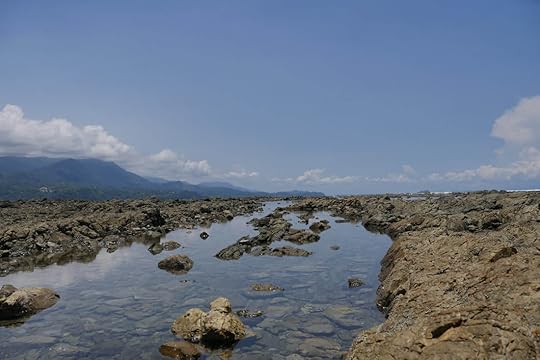 On the "whale tail" at low tide, Marino Ballena NP, Costa Rica. Ballena means whale in Spanish, and it’s named after a whale because the beach itself actually looks like a whale tail sticking into the ocean. We had to check the tide chart to make sure we got there at low tide in order to walk across to the whale tail, but even at high tide the beach would be picture perfect and the waves are fun to swim in. Once the tide was low enough to cross onto the “tail”, we found it to be a rocky and barren stretch of tidal pools that were beautiful in an austere way. Sunscreen is a must since the tail portion of the beach has no shelter or trees. In Conclusion So was Costa Rica as amazing as I had hoped it would be? Yes! And although it can be very easy to slip into the tourist traps and spend all your money, with a bit of effort, Costa Rica can be as rewarding and authentic as you want it to be. We were immersed in rainforest, swimming in crystal waters, and got to see monkeys, iguanas, countless birds and butterflies, and our absolute favorite: sloths in all their laziness. It was an unforgettable experience, and I recommend it to anyone who loves the tropics, beaches, interesting wildlife, and nature.
On the "whale tail" at low tide, Marino Ballena NP, Costa Rica. Ballena means whale in Spanish, and it’s named after a whale because the beach itself actually looks like a whale tail sticking into the ocean. We had to check the tide chart to make sure we got there at low tide in order to walk across to the whale tail, but even at high tide the beach would be picture perfect and the waves are fun to swim in. Once the tide was low enough to cross onto the “tail”, we found it to be a rocky and barren stretch of tidal pools that were beautiful in an austere way. Sunscreen is a must since the tail portion of the beach has no shelter or trees. In Conclusion So was Costa Rica as amazing as I had hoped it would be? Yes! And although it can be very easy to slip into the tourist traps and spend all your money, with a bit of effort, Costa Rica can be as rewarding and authentic as you want it to be. We were immersed in rainforest, swimming in crystal waters, and got to see monkeys, iguanas, countless birds and butterflies, and our absolute favorite: sloths in all their laziness. It was an unforgettable experience, and I recommend it to anyone who loves the tropics, beaches, interesting wildlife, and nature. 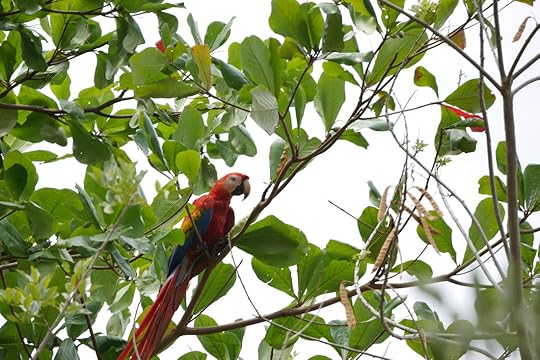 A scarlet macaw on Playa Pógeres, Cost Rica. A bit of background on Costa Rica As I’ve come to learn, Costa Rica’s government has been under the U.S.’s wing for quite some time (since the 60's), receiving lots of foreign aid every year until it graduated from the program in 1996. But because of this close friendship, Costa Rica has earned some resentment from its northern neighbors, especially Nicaragua, which feels they have been unfairly shunned by the U.S., at least from what I gathered from Nicaraguan locals.
A scarlet macaw on Playa Pógeres, Cost Rica. A bit of background on Costa Rica As I’ve come to learn, Costa Rica’s government has been under the U.S.’s wing for quite some time (since the 60's), receiving lots of foreign aid every year until it graduated from the program in 1996. But because of this close friendship, Costa Rica has earned some resentment from its northern neighbors, especially Nicaragua, which feels they have been unfairly shunned by the U.S., at least from what I gathered from Nicaraguan locals.
Costa Rica has also not joined the CA4 agreement (Guatemala, El Salvador, Honduras, and Nicaragua) which allows for easy and free movement of its citizens throughout the region. Though Costa Rica does take in a fair amount of refugees and asylum seekers from Latin America, compared to the CA4 countries, Costa Rica is seen as having closed their doors on Central Americans. And when you travel through Central America, you do feel the difference once crossing into Costa Rica, like you’ve entered a whole new land: a privileged place that has to work constantly at keeping its squeaky-clean reputation for the tourists, even if that means isolating itself off from its neighbors.
But Costa Rica’s greatness is not all due to U.S. and foreign money coming in. Since its civil war in 1948, the government has adopted a strong stance for peace and demilitarization. Since then, Costa Rica has completely demilitarized, meaning they spend 0% of their GDP on the military, a shocking move in a region wracked by military coups and armed violence. But even without an army (or perhaps because of it), Costa Rica remains one of the safest countries in Latin America, and has inspired Panama to follow suit in demilitarization. Costa Rica has made other great social improvements, and is known for its highly educated workforce, its progressive environmental policies (they have plans to become carbon-neutral by 2021), and has a healthcare system ranked higher than the U.S.’s.
For me, I was excited to visit a country that had no military, and a stable democracy that is surrounded by developing nations that are often overcome with violence and government instability. And Costa Rica did not disappoint. I believe that Costa Rica can be an inspiration not just to its neighbors, but to the world, at how even a tiny country in a volatile region can become safe, healthy, environmentally friendly, and prosperous.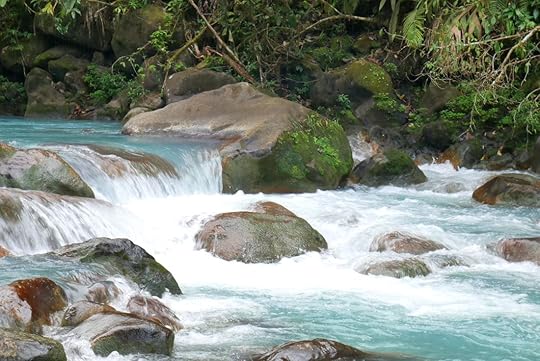 The stunningly blue Rio Celeste (color caused by minerals), Arenal, Costa Rica.
The stunningly blue Rio Celeste (color caused by minerals), Arenal, Costa Rica.
But that was a while ago, and I also heard more recently from fellow travelers that Costa Rica has become insanely touristy, extrmely expensive, and so overrun with wealthy Americans, that some people I'd talked to actually left the country early.
So when Tim and I rode our motorcycle zig-zagging across Costa Rica, I wasn’t quite sure if I was going to fall in love with it, or hate it.
 A capuchin monkey (also known as white-faced monkey) at Místico Hanging Gardens, Costa Rica. First Impressions The first thing that struck me about Costa Rica while coming across the border from Nicaragua, was the glass-fronted customs office with air-conditioning inside. Freshly-mopped floors, people were standing in lines, and there were signs on where to go. It was a real difference from the outdoor, grimy border crossings we were used to with begging children and computers from the 90's.
A capuchin monkey (also known as white-faced monkey) at Místico Hanging Gardens, Costa Rica. First Impressions The first thing that struck me about Costa Rica while coming across the border from Nicaragua, was the glass-fronted customs office with air-conditioning inside. Freshly-mopped floors, people were standing in lines, and there were signs on where to go. It was a real difference from the outdoor, grimy border crossings we were used to with begging children and computers from the 90's.And then once our passports were stamped, the roads into the country were perfectly paved with clear painted lines, guard rails, good signage, even reflective strips! And the best part, no trash along the sides of the roads! After traveling through Central America for so long, this was all very welcome for us.
 Me walking along one of the bridges at Místico Hanging Bridges Park in Costa Rica. Our first stop in Costa Rica was the famous Místico Hanging Gardens near Arenal Lake and Volcán Arenal. This well-maintained park has trails through an incredible section of rainforest, complete with hanging bridges that give you a unique perspective of the canopy. It is expensive for sure (we spent more than $50 to enter), and even though guides are highly recommended in order to point out the wildlife that you would otherwise miss, we simply could not afford a guide (would have been $80 for the two of us).
Me walking along one of the bridges at Místico Hanging Bridges Park in Costa Rica. Our first stop in Costa Rica was the famous Místico Hanging Gardens near Arenal Lake and Volcán Arenal. This well-maintained park has trails through an incredible section of rainforest, complete with hanging bridges that give you a unique perspective of the canopy. It is expensive for sure (we spent more than $50 to enter), and even though guides are highly recommended in order to point out the wildlife that you would otherwise miss, we simply could not afford a guide (would have been $80 for the two of us).Luckily, we were still able to see white-faced monkeys, an owl, a python, but did not see the sloth of our dreams that we had been hoping for, but it's not a zoo, only the wild, so we just weren't lucky. Overall, I felt the experience was worth the money as a truly atmospheric introduction to the rainforest and all its majesty, but we left feeling a little unsatisfied, not just because we didn’t see a sloth and our pockets were now much emptier, but because this initial glimpse at Costa Rica proved to be the touristy, expensive, Disney World-like version that I had feared Costa Rica had become. Noemy's Farm If you can't see the gallery, you can check it out here. Thankfully, luck was again on our side, as our next stop was an Airbnb/Workaway organic farm run by a local woman named Noemy. This turned into the perfect antidote to our dissatisfaction of the Místico Hanging Gardens, because this farm had its own patch of rainforest full of sloths, huge iguanas, poisonous frogs, and incredibly-colored toucans. And because we were staying in a cabin tucked into the thick foliage, and were helping out with the garden, feeding the chickens, and shucking beans, we really felt that this was the authentic Costa Rican experience that we were looking for. The mornings were perfectly misty, the midday was steamy hot, and the evenings were glittering with the biggest fireflies I have ever seen. It felt magical, and we will forever cherish our time at Noemy’s farm. Cahuita and the Caribbean

 Since we had been hanging out in the jungle now for quite some time, we decided the perfect place to cool off would be the calm waters of the Caribbean coast. There are two major places that tourists mainly visit along Costa Rica’s Atlantic coastline: Limón, the larger resort-like port, and Cahuita, the laid-back Jamaican-style town next to a National Park by the same name. So of course, being more our pace, we set our tires straight for Cahuita.
Since we had been hanging out in the jungle now for quite some time, we decided the perfect place to cool off would be the calm waters of the Caribbean coast. There are two major places that tourists mainly visit along Costa Rica’s Atlantic coastline: Limón, the larger resort-like port, and Cahuita, the laid-back Jamaican-style town next to a National Park by the same name. So of course, being more our pace, we set our tires straight for Cahuita.The town itself reminded me a bit of Playa Del Carmen in Mexico: an expensive beachside place completely built around the American tourists that come to spend their money, walk around in bathing suits, and get drunk. But Cahuita NP was a dream come true: a long stretch of coastal forest where capuchin monkeys are everywhere (and got quite up-close and personal to us), raccoons march around looking for food, and the swimming in the waves is truly heavenly. Cahuita National Park charges no fees (but takes donations), and was easily walkable from our hotel room. San Jose and its Surrounding Hills After all that farm work and swimming, we decided to take a week or more to get caught-up on our computer work and get the bike serviced. So after a very rainy ride to Costa Rica’s capital city, San José, we got a new front tire on the bike, Tim bought a new helmet that actually fit him, and then we spent a week in the hills at an Airbnb with a view out of this world.
 View near Puriscal, Costa Rica. At this point, I had made up my mind about whether I loved or hated Costa Rica, and I was definitely in the “I love it” camp. I was thoroughly convinced that although Costa Rica can be quite expensive, if you know where to look, it can be on-par with other Central American countries as far as cost. And again, once off the tourist track a bit, Costa Rica's national parks, forests, and coastlines are some of the best-maintained, cleanest, and most beautiful we have come across.
View near Puriscal, Costa Rica. At this point, I had made up my mind about whether I loved or hated Costa Rica, and I was definitely in the “I love it” camp. I was thoroughly convinced that although Costa Rica can be quite expensive, if you know where to look, it can be on-par with other Central American countries as far as cost. And again, once off the tourist track a bit, Costa Rica's national parks, forests, and coastlines are some of the best-maintained, cleanest, and most beautiful we have come across.Our time in Costa Rica was coming to a close, so in order to complete our Costa Rica experience before heading into Panama, we wanted to go to a place that everyone recommended: Marino Ballena National Park on the Pacific Coast
 On the "whale tail" at low tide, Marino Ballena NP, Costa Rica. Ballena means whale in Spanish, and it’s named after a whale because the beach itself actually looks like a whale tail sticking into the ocean. We had to check the tide chart to make sure we got there at low tide in order to walk across to the whale tail, but even at high tide the beach would be picture perfect and the waves are fun to swim in. Once the tide was low enough to cross onto the “tail”, we found it to be a rocky and barren stretch of tidal pools that were beautiful in an austere way. Sunscreen is a must since the tail portion of the beach has no shelter or trees. In Conclusion So was Costa Rica as amazing as I had hoped it would be? Yes! And although it can be very easy to slip into the tourist traps and spend all your money, with a bit of effort, Costa Rica can be as rewarding and authentic as you want it to be. We were immersed in rainforest, swimming in crystal waters, and got to see monkeys, iguanas, countless birds and butterflies, and our absolute favorite: sloths in all their laziness. It was an unforgettable experience, and I recommend it to anyone who loves the tropics, beaches, interesting wildlife, and nature.
On the "whale tail" at low tide, Marino Ballena NP, Costa Rica. Ballena means whale in Spanish, and it’s named after a whale because the beach itself actually looks like a whale tail sticking into the ocean. We had to check the tide chart to make sure we got there at low tide in order to walk across to the whale tail, but even at high tide the beach would be picture perfect and the waves are fun to swim in. Once the tide was low enough to cross onto the “tail”, we found it to be a rocky and barren stretch of tidal pools that were beautiful in an austere way. Sunscreen is a must since the tail portion of the beach has no shelter or trees. In Conclusion So was Costa Rica as amazing as I had hoped it would be? Yes! And although it can be very easy to slip into the tourist traps and spend all your money, with a bit of effort, Costa Rica can be as rewarding and authentic as you want it to be. We were immersed in rainforest, swimming in crystal waters, and got to see monkeys, iguanas, countless birds and butterflies, and our absolute favorite: sloths in all their laziness. It was an unforgettable experience, and I recommend it to anyone who loves the tropics, beaches, interesting wildlife, and nature.  A scarlet macaw on Playa Pógeres, Cost Rica. A bit of background on Costa Rica As I’ve come to learn, Costa Rica’s government has been under the U.S.’s wing for quite some time (since the 60's), receiving lots of foreign aid every year until it graduated from the program in 1996. But because of this close friendship, Costa Rica has earned some resentment from its northern neighbors, especially Nicaragua, which feels they have been unfairly shunned by the U.S., at least from what I gathered from Nicaraguan locals.
A scarlet macaw on Playa Pógeres, Cost Rica. A bit of background on Costa Rica As I’ve come to learn, Costa Rica’s government has been under the U.S.’s wing for quite some time (since the 60's), receiving lots of foreign aid every year until it graduated from the program in 1996. But because of this close friendship, Costa Rica has earned some resentment from its northern neighbors, especially Nicaragua, which feels they have been unfairly shunned by the U.S., at least from what I gathered from Nicaraguan locals. Costa Rica has also not joined the CA4 agreement (Guatemala, El Salvador, Honduras, and Nicaragua) which allows for easy and free movement of its citizens throughout the region. Though Costa Rica does take in a fair amount of refugees and asylum seekers from Latin America, compared to the CA4 countries, Costa Rica is seen as having closed their doors on Central Americans. And when you travel through Central America, you do feel the difference once crossing into Costa Rica, like you’ve entered a whole new land: a privileged place that has to work constantly at keeping its squeaky-clean reputation for the tourists, even if that means isolating itself off from its neighbors.
But Costa Rica’s greatness is not all due to U.S. and foreign money coming in. Since its civil war in 1948, the government has adopted a strong stance for peace and demilitarization. Since then, Costa Rica has completely demilitarized, meaning they spend 0% of their GDP on the military, a shocking move in a region wracked by military coups and armed violence. But even without an army (or perhaps because of it), Costa Rica remains one of the safest countries in Latin America, and has inspired Panama to follow suit in demilitarization. Costa Rica has made other great social improvements, and is known for its highly educated workforce, its progressive environmental policies (they have plans to become carbon-neutral by 2021), and has a healthcare system ranked higher than the U.S.’s.
For me, I was excited to visit a country that had no military, and a stable democracy that is surrounded by developing nations that are often overcome with violence and government instability. And Costa Rica did not disappoint. I believe that Costa Rica can be an inspiration not just to its neighbors, but to the world, at how even a tiny country in a volatile region can become safe, healthy, environmentally friendly, and prosperous.
 The stunningly blue Rio Celeste (color caused by minerals), Arenal, Costa Rica.
The stunningly blue Rio Celeste (color caused by minerals), Arenal, Costa Rica.
Published on June 13, 2018 07:57
May 29, 2018
Tim's Top Ten Travel Tips
By Tim Notier There are many things we have learned along the way and I would like to share what are my top ten travel tips.
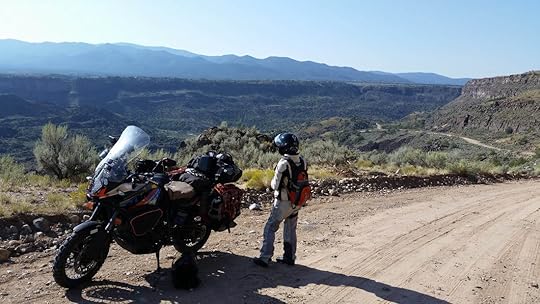 1) Learn the Language So, even though I am the one suggesting it, I have yet to accomplish this task. But I see my own handicap for my lack of communication. From directions, police checkpoints, to just friendly conversations with strangers, I am left in the dark while Marisa chats away and laughs. I have Duolingo on my phone (a language learning app), and have taken a whopping one week class of Spanish in Guatemala, but if you do not practice, you will not learn (I write “you" but really mean “I"). So much more can be absorbed and learned of the culture and the place if you know how to read and speak the language.
1) Learn the Language So, even though I am the one suggesting it, I have yet to accomplish this task. But I see my own handicap for my lack of communication. From directions, police checkpoints, to just friendly conversations with strangers, I am left in the dark while Marisa chats away and laughs. I have Duolingo on my phone (a language learning app), and have taken a whopping one week class of Spanish in Guatemala, but if you do not practice, you will not learn (I write “you" but really mean “I"). So much more can be absorbed and learned of the culture and the place if you know how to read and speak the language.
Marisa is on the other side of the coin. Every day she practices French and Turkish, and is already fluent in Arabic and Spanish. I will just wander behind her like an ignorant tourist as she gets to know the people and culture in a finer detail because I lack the drive or effort to comprehend what is being said. But I understand that learning the language, at least a bit, is a real asset to traveling, and even the little Spanish I have learned has given me greater insight into the Latin American culture.
By knowing the local language, we have been able to stay with families and really get to know what life is like in the country we are visiting. It has also helped us avoid some visa and permit problems that may have turned out disastrously if we could not have conversed, and it has allowed us to have a greater appreciation for the people and culture of the place we are guests in. 2) Network
You are not the only ones out there on the road on an amazing adventure. Others are immediately around you, just hours or days ahead of you. With Facebook being such an easy tool with multiple pages on any specific place or interest, it is easy to find like-minded people on the same path as you.
Communication with others has multiple benefits, conversations about each party’s experience so far, to “must see" hidden treasures, as well as where to avoid. We have met countless people who have shared advice, friendship, and knowledge. We are currently semi-traveling with a couple, Phil and Sapna, who do a little more research than Marisa and me, and we bleed them for information constantly. Another couple, James and Imogen, are about two months ahead of us, and make perfect recon missions into what is to be our future. And yet another couple, Brendon and Kira, who are currently one country behind us, have provided us with info on how they travel on a budget: wild camping and proper networking online to let communities know when and where they will be in the area. They also strongly suggested using iOverlander, an app I had downloaded on my phone, but had never used properly. And they were right, it is very useful.
Building a network can give you immediate access to what is currently happening at different places from the advice of fellow travelers, and you might just find a group that will feel like your family on the road.
Everyone reading this is part of our network, and we thank each and every one of you for your support! 3) Stay with locals / families on AirBnb
We love camping, but sometimes the weather or “vibe" of the area will not allow us to do so. Since we plan as little as possible, we usually just pull into a city with a small list of accommodation options we marked on Google Maps. But, whenever we plan on staying somewhere for three days or more, we try to use AirBnb to scout out houses occupied by local families who are simply renting rooms. This feels more like a home stay, and is a great way to meet wonderful people and learn about their lives. They also have great tips on where to visit, and the non-touristic spots and the backroads to get there.
We have met so many wonderful people along the way, and love to see the family's daily functions while immersed in their lives (even if sometimes Marisa and I have to share a single bed). This is also where learning their language is a great benefit. Marisa gets to know people on a very personal level, and I do a lot of nodding my head and smiling. 4) Be prepared to be delayed
Borders, traffic, finding accommodations (and even just staying upright on the bike) do not always work out as expected. When frustration is added to the scenario, it usually just goes from bad to worse. So plan on being delayed. The timing of the routes we type into Google Maps are almost always incorrect, because sight-seeing, gas stops, bathroom breaks, lunch, detours, and just time to stretch your muscles, all add up to unpredicted hours on the road. So we keep our daily plans short, because they could end up being much longer than anticipated.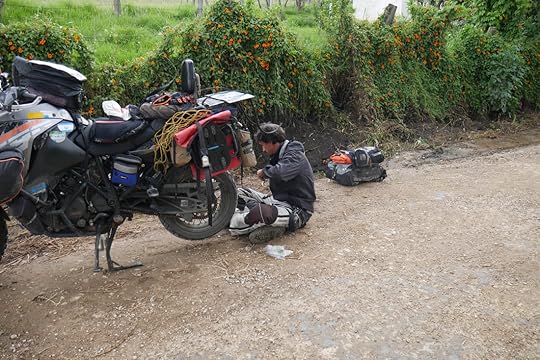 5) Don't plan every mile
5) Don't plan every mile
Marisa and I sometimes have no idea where we will be the following day, and we never plan for anything more than a week in advance (unless there are scheduled maintenances or key appointments). We sometimes add multiple stopping locations spread down the main roads, giving us options depending on how the weather conditions or waypoints are.
Half of the gems we have “discovered" were suggestions from local people, or travelers riding ahead of us. We try to (and often fail) to avoid the “must see" attractions that 90% of tourists go to, and instead we search out local treasures that are more secluded.
Without having a concrete plan, we are more flexible and can detour without regret of missing out on what each individual country has to offer. Of course, we cannot see it all, but we try!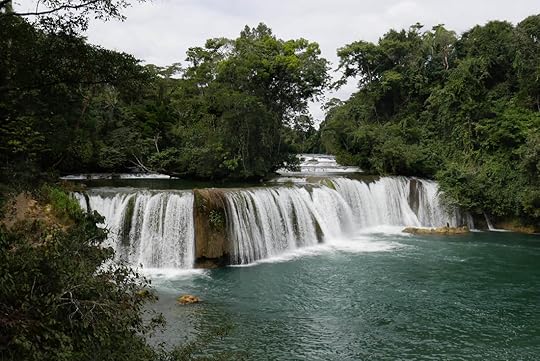 6) Accept hospitality / kindness of others
6) Accept hospitality / kindness of others
This was hard for us at first. We thought we were self-sufficient travelers who did not want to inconvenience anyone for the likes of two dirty travelers. At first, when people offered to buy us lunch, a beer, and even pay for a hotel room, we would refuse. To me it felt wrong because we had quit our jobs and decided to be vagabonds living on a tight budget. So I did not feel comfortable having other people pay for us because there was nothing for us to give in return, except a smile, conversation, and maybe a sticker or two.
What I did not realize is that the people we have met are excited and happy to offer meals and hospitalities. The same feeling that we get when staying with locals is mutual with our new friends. Hospitality and free meals should never be expected, nor should they be asked for, but when offered, it comes from their heart, not out of pity. Many of the people we have met are excited to hear of our tales, and want to be part of the story.
We hosted a German world traveler when he made his way through Chicago. I think I was more excited to have him at our house than he was for being able to stay for free. So much information was learned, and a friendship for life was created.
After some time on the road, we realized that this was one of the great pleasures of traveling. It is amazing the feeling you get (we try to do it often) when you are able to assist someone with a small gesture, and it is wonderful to meet people when our paths cross. A small token of kindness doesn’t cost much, but it will forever be burned into our memory, always proving to us how wonderful people truly are.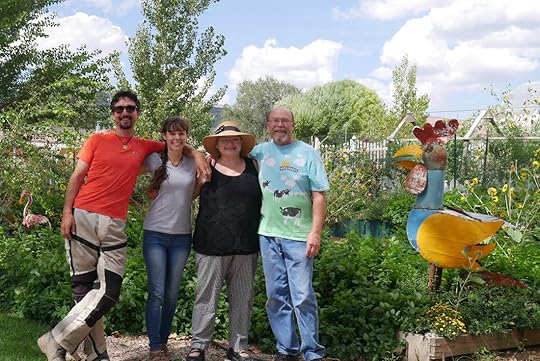 7) Invest in the right gear I am not suggesting that you have to spend 5 thousand dollars on clothes, cooking gear, or camping equipment. But, this is also an area not to skim on either. We learned really quick on our 3-week test run around the western states that a miserable day's ride followed by a miserable night’s sleep snowballed into a torturous journey. We spent the time and money needed to be sure we would be comfortable on the road. You can check out our full list of gear on the “Our Gear" section.
7) Invest in the right gear I am not suggesting that you have to spend 5 thousand dollars on clothes, cooking gear, or camping equipment. But, this is also an area not to skim on either. We learned really quick on our 3-week test run around the western states that a miserable day's ride followed by a miserable night’s sleep snowballed into a torturous journey. We spent the time and money needed to be sure we would be comfortable on the road. You can check out our full list of gear on the “Our Gear" section.
We are still adjusting our gear, and we may one day perfect it, but for now we have comfortable, budget-friendly (sorta), warm and durable gear. There is not a single correct answer, and there are a lot of variables about weather that are hard to cover in a single coat, shirt, or pants. You may have to adapt along the way, but good gear from the beginning is a real benefit.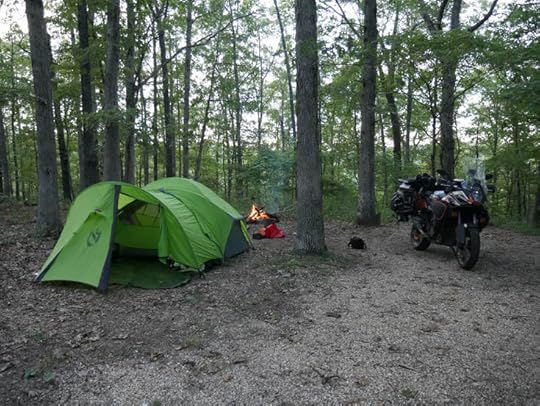 8) Start the day early I stole this from a presentation that Sam Manicom gave at an Overland Expo. He is well traveled, so I listened closely. If you have a 5-hour day ride ahead of you, and something were to go wrong (a tire puncture, dead battery, or the countless other things that could go wrong), you could potentially run out of sunlight depending on what hour you left.
8) Start the day early I stole this from a presentation that Sam Manicom gave at an Overland Expo. He is well traveled, so I listened closely. If you have a 5-hour day ride ahead of you, and something were to go wrong (a tire puncture, dead battery, or the countless other things that could go wrong), you could potentially run out of sunlight depending on what hour you left.
We like to be sure we have time to stop, take pictures, have breaks, and eat without feeling the pressure of the sun's light disappearing. Sometimes we roam around looking for the cheapest place to stay (or any place to stay!) and we like to be fully unloaded and settled down long before the sun has set.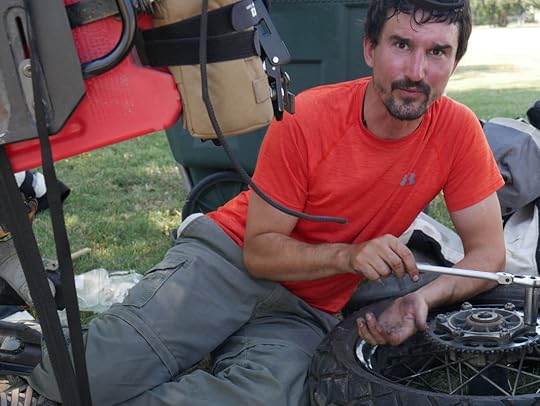 9) Know everything will turn out just fine You most likely will get a flat tire, pay a bribe, or have a reservation cancel on you. Many things have not gone exactly as planned, but that does not mean it didn't go right. Some of our “misfortunes" have led us to experience other attractions, people, or sights that would not have happened if everything went as planned.
9) Know everything will turn out just fine You most likely will get a flat tire, pay a bribe, or have a reservation cancel on you. Many things have not gone exactly as planned, but that does not mean it didn't go right. Some of our “misfortunes" have led us to experience other attractions, people, or sights that would not have happened if everything went as planned.
I get frustrated in the moment, and I have to stop and tell myself everything will turn out just fine. Minor inconveniences seem like huge barriers in the present, but through teamwork, your network of friends, knowing a little bit of the language, being prepared to be delayed, along with the other tips presented here, I guarantee that you will pull through. Some of the toughest times create the best memories, and I wouldn't change any misleading signs or forks in the road that has led Marisa and I to the very spot we are now.
Life is good!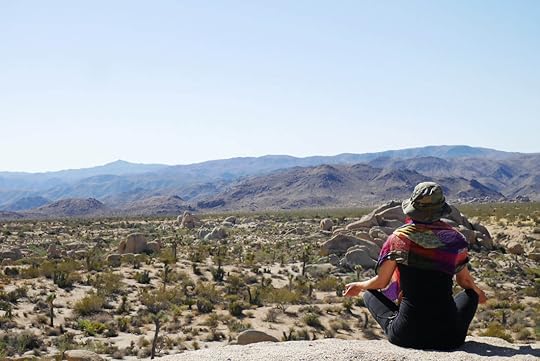 10) Have fun This seems like an obvious “tip", but you have to be sure you are able to take the time to stop everything and reflect on the positives. We are all very lucky we have the opportunity to travel and to see all of the wonders this world has to offer.
10) Have fun This seems like an obvious “tip", but you have to be sure you are able to take the time to stop everything and reflect on the positives. We are all very lucky we have the opportunity to travel and to see all of the wonders this world has to offer.
Be sure to smile, and to make others smile while you travel along the journey and throughout life. Bonus tips:
* Get to know a pilot: They can fly anywhere in the world for free, and will bring you supplies if they like you enough.
* Promote your book :) Maiden Voyage on Amazon
 1) Learn the Language So, even though I am the one suggesting it, I have yet to accomplish this task. But I see my own handicap for my lack of communication. From directions, police checkpoints, to just friendly conversations with strangers, I am left in the dark while Marisa chats away and laughs. I have Duolingo on my phone (a language learning app), and have taken a whopping one week class of Spanish in Guatemala, but if you do not practice, you will not learn (I write “you" but really mean “I"). So much more can be absorbed and learned of the culture and the place if you know how to read and speak the language.
1) Learn the Language So, even though I am the one suggesting it, I have yet to accomplish this task. But I see my own handicap for my lack of communication. From directions, police checkpoints, to just friendly conversations with strangers, I am left in the dark while Marisa chats away and laughs. I have Duolingo on my phone (a language learning app), and have taken a whopping one week class of Spanish in Guatemala, but if you do not practice, you will not learn (I write “you" but really mean “I"). So much more can be absorbed and learned of the culture and the place if you know how to read and speak the language.Marisa is on the other side of the coin. Every day she practices French and Turkish, and is already fluent in Arabic and Spanish. I will just wander behind her like an ignorant tourist as she gets to know the people and culture in a finer detail because I lack the drive or effort to comprehend what is being said. But I understand that learning the language, at least a bit, is a real asset to traveling, and even the little Spanish I have learned has given me greater insight into the Latin American culture.
By knowing the local language, we have been able to stay with families and really get to know what life is like in the country we are visiting. It has also helped us avoid some visa and permit problems that may have turned out disastrously if we could not have conversed, and it has allowed us to have a greater appreciation for the people and culture of the place we are guests in. 2) Network
You are not the only ones out there on the road on an amazing adventure. Others are immediately around you, just hours or days ahead of you. With Facebook being such an easy tool with multiple pages on any specific place or interest, it is easy to find like-minded people on the same path as you.
Communication with others has multiple benefits, conversations about each party’s experience so far, to “must see" hidden treasures, as well as where to avoid. We have met countless people who have shared advice, friendship, and knowledge. We are currently semi-traveling with a couple, Phil and Sapna, who do a little more research than Marisa and me, and we bleed them for information constantly. Another couple, James and Imogen, are about two months ahead of us, and make perfect recon missions into what is to be our future. And yet another couple, Brendon and Kira, who are currently one country behind us, have provided us with info on how they travel on a budget: wild camping and proper networking online to let communities know when and where they will be in the area. They also strongly suggested using iOverlander, an app I had downloaded on my phone, but had never used properly. And they were right, it is very useful.
Building a network can give you immediate access to what is currently happening at different places from the advice of fellow travelers, and you might just find a group that will feel like your family on the road.
Everyone reading this is part of our network, and we thank each and every one of you for your support! 3) Stay with locals / families on AirBnb
We love camping, but sometimes the weather or “vibe" of the area will not allow us to do so. Since we plan as little as possible, we usually just pull into a city with a small list of accommodation options we marked on Google Maps. But, whenever we plan on staying somewhere for three days or more, we try to use AirBnb to scout out houses occupied by local families who are simply renting rooms. This feels more like a home stay, and is a great way to meet wonderful people and learn about their lives. They also have great tips on where to visit, and the non-touristic spots and the backroads to get there.
We have met so many wonderful people along the way, and love to see the family's daily functions while immersed in their lives (even if sometimes Marisa and I have to share a single bed). This is also where learning their language is a great benefit. Marisa gets to know people on a very personal level, and I do a lot of nodding my head and smiling. 4) Be prepared to be delayed
Borders, traffic, finding accommodations (and even just staying upright on the bike) do not always work out as expected. When frustration is added to the scenario, it usually just goes from bad to worse. So plan on being delayed. The timing of the routes we type into Google Maps are almost always incorrect, because sight-seeing, gas stops, bathroom breaks, lunch, detours, and just time to stretch your muscles, all add up to unpredicted hours on the road. So we keep our daily plans short, because they could end up being much longer than anticipated.
 5) Don't plan every mile
5) Don't plan every mileMarisa and I sometimes have no idea where we will be the following day, and we never plan for anything more than a week in advance (unless there are scheduled maintenances or key appointments). We sometimes add multiple stopping locations spread down the main roads, giving us options depending on how the weather conditions or waypoints are.
Half of the gems we have “discovered" were suggestions from local people, or travelers riding ahead of us. We try to (and often fail) to avoid the “must see" attractions that 90% of tourists go to, and instead we search out local treasures that are more secluded.
Without having a concrete plan, we are more flexible and can detour without regret of missing out on what each individual country has to offer. Of course, we cannot see it all, but we try!
 6) Accept hospitality / kindness of others
6) Accept hospitality / kindness of othersThis was hard for us at first. We thought we were self-sufficient travelers who did not want to inconvenience anyone for the likes of two dirty travelers. At first, when people offered to buy us lunch, a beer, and even pay for a hotel room, we would refuse. To me it felt wrong because we had quit our jobs and decided to be vagabonds living on a tight budget. So I did not feel comfortable having other people pay for us because there was nothing for us to give in return, except a smile, conversation, and maybe a sticker or two.
What I did not realize is that the people we have met are excited and happy to offer meals and hospitalities. The same feeling that we get when staying with locals is mutual with our new friends. Hospitality and free meals should never be expected, nor should they be asked for, but when offered, it comes from their heart, not out of pity. Many of the people we have met are excited to hear of our tales, and want to be part of the story.
We hosted a German world traveler when he made his way through Chicago. I think I was more excited to have him at our house than he was for being able to stay for free. So much information was learned, and a friendship for life was created.
After some time on the road, we realized that this was one of the great pleasures of traveling. It is amazing the feeling you get (we try to do it often) when you are able to assist someone with a small gesture, and it is wonderful to meet people when our paths cross. A small token of kindness doesn’t cost much, but it will forever be burned into our memory, always proving to us how wonderful people truly are.
 7) Invest in the right gear I am not suggesting that you have to spend 5 thousand dollars on clothes, cooking gear, or camping equipment. But, this is also an area not to skim on either. We learned really quick on our 3-week test run around the western states that a miserable day's ride followed by a miserable night’s sleep snowballed into a torturous journey. We spent the time and money needed to be sure we would be comfortable on the road. You can check out our full list of gear on the “Our Gear" section.
7) Invest in the right gear I am not suggesting that you have to spend 5 thousand dollars on clothes, cooking gear, or camping equipment. But, this is also an area not to skim on either. We learned really quick on our 3-week test run around the western states that a miserable day's ride followed by a miserable night’s sleep snowballed into a torturous journey. We spent the time and money needed to be sure we would be comfortable on the road. You can check out our full list of gear on the “Our Gear" section.We are still adjusting our gear, and we may one day perfect it, but for now we have comfortable, budget-friendly (sorta), warm and durable gear. There is not a single correct answer, and there are a lot of variables about weather that are hard to cover in a single coat, shirt, or pants. You may have to adapt along the way, but good gear from the beginning is a real benefit.
 8) Start the day early I stole this from a presentation that Sam Manicom gave at an Overland Expo. He is well traveled, so I listened closely. If you have a 5-hour day ride ahead of you, and something were to go wrong (a tire puncture, dead battery, or the countless other things that could go wrong), you could potentially run out of sunlight depending on what hour you left.
8) Start the day early I stole this from a presentation that Sam Manicom gave at an Overland Expo. He is well traveled, so I listened closely. If you have a 5-hour day ride ahead of you, and something were to go wrong (a tire puncture, dead battery, or the countless other things that could go wrong), you could potentially run out of sunlight depending on what hour you left.We like to be sure we have time to stop, take pictures, have breaks, and eat without feeling the pressure of the sun's light disappearing. Sometimes we roam around looking for the cheapest place to stay (or any place to stay!) and we like to be fully unloaded and settled down long before the sun has set.
 9) Know everything will turn out just fine You most likely will get a flat tire, pay a bribe, or have a reservation cancel on you. Many things have not gone exactly as planned, but that does not mean it didn't go right. Some of our “misfortunes" have led us to experience other attractions, people, or sights that would not have happened if everything went as planned.
9) Know everything will turn out just fine You most likely will get a flat tire, pay a bribe, or have a reservation cancel on you. Many things have not gone exactly as planned, but that does not mean it didn't go right. Some of our “misfortunes" have led us to experience other attractions, people, or sights that would not have happened if everything went as planned.I get frustrated in the moment, and I have to stop and tell myself everything will turn out just fine. Minor inconveniences seem like huge barriers in the present, but through teamwork, your network of friends, knowing a little bit of the language, being prepared to be delayed, along with the other tips presented here, I guarantee that you will pull through. Some of the toughest times create the best memories, and I wouldn't change any misleading signs or forks in the road that has led Marisa and I to the very spot we are now.
Life is good!
 10) Have fun This seems like an obvious “tip", but you have to be sure you are able to take the time to stop everything and reflect on the positives. We are all very lucky we have the opportunity to travel and to see all of the wonders this world has to offer.
10) Have fun This seems like an obvious “tip", but you have to be sure you are able to take the time to stop everything and reflect on the positives. We are all very lucky we have the opportunity to travel and to see all of the wonders this world has to offer. Be sure to smile, and to make others smile while you travel along the journey and throughout life. Bonus tips:
* Get to know a pilot: They can fly anywhere in the world for free, and will bring you supplies if they like you enough.
* Promote your book :) Maiden Voyage on Amazon
Published on May 29, 2018 09:16
May 15, 2018
Nicaragua in a Nutshell
By: Tim Notier  The border between Nicaragua and Honduras took a little longer than average, along with a dose of some of the hottest temperatures we had come by so far. All we needed was just a little patience, and I was continuously thankful that Marisa is fluent in Spanish.
The border between Nicaragua and Honduras took a little longer than average, along with a dose of some of the hottest temperatures we had come by so far. All we needed was just a little patience, and I was continuously thankful that Marisa is fluent in Spanish.
When we cross borders throughout the Americas, the form always asks for my nationality. I have to ask myself: “What am I?" We are in the Americas, so American doesn't really specify where I am from. I think it is kind of ignorant to hijack an entire continent and say, “You know, I'm from the America where we play football with our hands."
So, I put down USA... but that's not right either. No one says, “I am England" or “I am South Africa." It is English, South African, Asian, or Irish and so on. I thought about writing down USAish or USAian, because I didn't want to write “A Citizen of the United States of America," but figured that would add to the confusion.
#IamUSAian
Once we proved we were worthy of entry into Nicaragua, we took an eagle’s eye view of the possibilities this new country had to offer. Volcanos, nature, and some off-road exploring were top priorities on our list.
Due to the fact that we never have a plan in advance, we just went with the flow. Everywhere we looked, there were hostels displaying ads for local trips into canyons, hikes up volcanos, and even a sport we had yet to hear of: volcano boarding. This country seemed to have a lot to offer its new burst of tourists.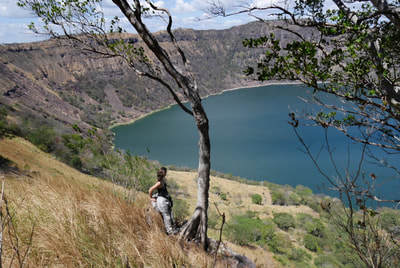
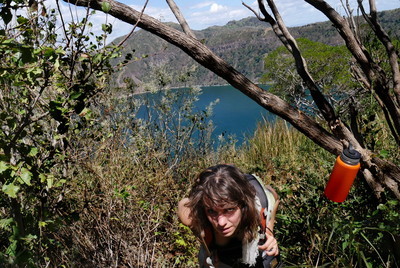
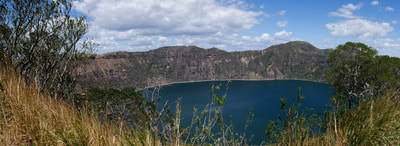 We quickly fell in love with Nicaragua. We climbed the ancient volcano Apoyeque to gaze down into the crater lake. It was a hell of a hike in the heat, but both the road to it, and the hike up the narrow path, was worth all of the sweat.
We quickly fell in love with Nicaragua. We climbed the ancient volcano Apoyeque to gaze down into the crater lake. It was a hell of a hike in the heat, but both the road to it, and the hike up the narrow path, was worth all of the sweat.
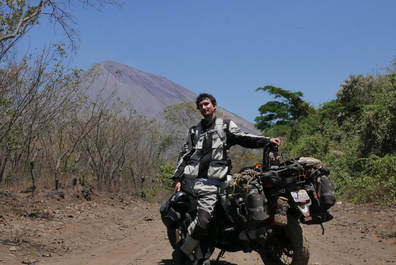 We also found ourselves on a lot of backroads, winding through small villages and through scenery of green pastures with volcanos in every direction. We rode to San Cristóbal down some of these small roads. Wild (or free range) horses galloped on both sides as we made our way down dirt paths in the general direction to San Cristóbal. Photo opportunities were plenty, and we took time to absorb our surroundings, and to quench our thirsts as the heat of the day beat down on us.
We also found ourselves on a lot of backroads, winding through small villages and through scenery of green pastures with volcanos in every direction. We rode to San Cristóbal down some of these small roads. Wild (or free range) horses galloped on both sides as we made our way down dirt paths in the general direction to San Cristóbal. Photo opportunities were plenty, and we took time to absorb our surroundings, and to quench our thirsts as the heat of the day beat down on us. 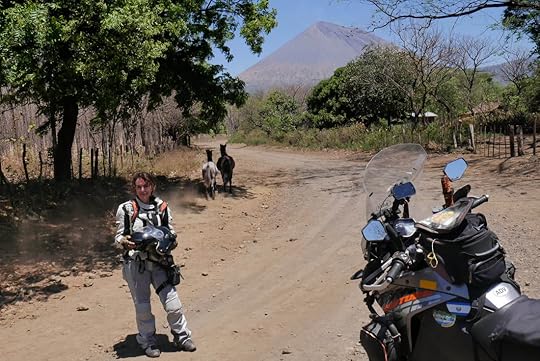
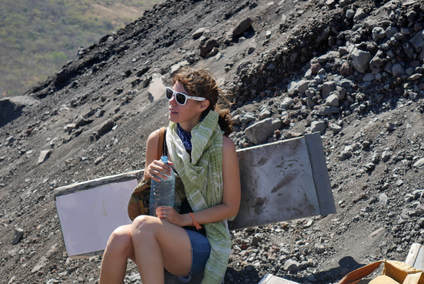 Volcano boarding was all the hype around Leon, and is definitely not something that would ever be offered in the states. We signed up for an outing, and prepared ourselves for both the hike up, and the ride down. It turned out to be amazing. I have learned not to get overly excited about certain places or activities, as most of the time it is overcrowded, or just a checklist item on the bucket list of travelers. “You've got to aim low," I always say. “If you aim low, you will be ecstatic for just about anything from bland to amazing."
Volcano boarding was all the hype around Leon, and is definitely not something that would ever be offered in the states. We signed up for an outing, and prepared ourselves for both the hike up, and the ride down. It turned out to be amazing. I have learned not to get overly excited about certain places or activities, as most of the time it is overcrowded, or just a checklist item on the bucket list of travelers. “You've got to aim low," I always say. “If you aim low, you will be ecstatic for just about anything from bland to amazing."
The hike up Cerro Negro, the volcano that's used for volcano boarding, was relatively easy with many views into the distance of an endless supply of volcanos on the horizon. With the heavy wooden boards strapped to our backs, we made our way up to the summit. Once at the “lanes" that we would use to plunge down the side of the volcano, we suited up in our bright yellow jumpsuits, goggles, bandanas, and strapped our backpacks on our belly before zipping the jumpsuits up tightly. We looked like a group of pregnant minions about to do something mischievous.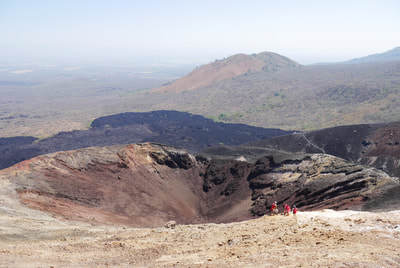

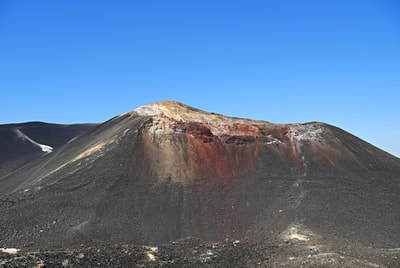 My ride down was both fast and furious. Like a shooting star I plummeted down the side, leaving a tail of debris behind me and crash landing at the bottom. Marisa, who is more graceful than I at just about everything, slowly meandered down the side at a pace that allowed her to enjoy the experience.
My ride down was both fast and furious. Like a shooting star I plummeted down the side, leaving a tail of debris behind me and crash landing at the bottom. Marisa, who is more graceful than I at just about everything, slowly meandered down the side at a pace that allowed her to enjoy the experience.
We spent a few days in Leon trying to survive the heat by day, and fending off mosquitos by night. We then received a message on FB from a couple, Yasenia and Raul, who stated they would love to host us, and confirmed the mosquito population was significantly less in Managua than in Leon. So we gladly accepted and spent four days learning about their paths in life, and exploring the surrounding area. We are forever grateful to those who have offered us temporary homes and embraced us as filthy and smelly as we can be.
Yasenia and Raul were two voices of many urging us to go to Ometepe, and after hearing about it in detail, there was no way we were going to miss it. We set off to Lake Nicaragua, where we loaded our bike onto a ferry, and then headed to Ometepe, an island made from two volcanos protruding out of the lake. There is a road that makes a giant figure eight around both Volcano Concepción and Volcano Maderas, and we explored many of the small towns that popped up along the route.
We found a little family-run farm that also had spaces to set up camp. It was secluded and we were some of the only guests as it was not on the main path of “hot spots" and hostels. It was our kind of place. We camped under a palapa with a view of the lake. It was absolutely wonderful. We explored, rested, wrote in our journals, took pictures, and read books while lying in our hammock. Plus, it was great to be camping again. Marisa was ecstatic as horses played on the beach just below our camp. Everything was just the way we would have wished. We swam in the water holes of Ojo de Agua and snapped pictures of nearly everything around us as we played tourist.
After Ometepe, it was time to enter Costa Rica. Nicaragua had proved to be an amazing place full of beautiful and friendly people as well as wonderful landscapes and wildlife. We enjoyed every second we spent exploring, climbing, relaxing, and absorbing all it has to offer.
 The border between Nicaragua and Honduras took a little longer than average, along with a dose of some of the hottest temperatures we had come by so far. All we needed was just a little patience, and I was continuously thankful that Marisa is fluent in Spanish.
The border between Nicaragua and Honduras took a little longer than average, along with a dose of some of the hottest temperatures we had come by so far. All we needed was just a little patience, and I was continuously thankful that Marisa is fluent in Spanish.When we cross borders throughout the Americas, the form always asks for my nationality. I have to ask myself: “What am I?" We are in the Americas, so American doesn't really specify where I am from. I think it is kind of ignorant to hijack an entire continent and say, “You know, I'm from the America where we play football with our hands."
So, I put down USA... but that's not right either. No one says, “I am England" or “I am South Africa." It is English, South African, Asian, or Irish and so on. I thought about writing down USAish or USAian, because I didn't want to write “A Citizen of the United States of America," but figured that would add to the confusion.
#IamUSAian
Once we proved we were worthy of entry into Nicaragua, we took an eagle’s eye view of the possibilities this new country had to offer. Volcanos, nature, and some off-road exploring were top priorities on our list.
Due to the fact that we never have a plan in advance, we just went with the flow. Everywhere we looked, there were hostels displaying ads for local trips into canyons, hikes up volcanos, and even a sport we had yet to hear of: volcano boarding. This country seemed to have a lot to offer its new burst of tourists.


 We quickly fell in love with Nicaragua. We climbed the ancient volcano Apoyeque to gaze down into the crater lake. It was a hell of a hike in the heat, but both the road to it, and the hike up the narrow path, was worth all of the sweat.
We quickly fell in love with Nicaragua. We climbed the ancient volcano Apoyeque to gaze down into the crater lake. It was a hell of a hike in the heat, but both the road to it, and the hike up the narrow path, was worth all of the sweat.
 We also found ourselves on a lot of backroads, winding through small villages and through scenery of green pastures with volcanos in every direction. We rode to San Cristóbal down some of these small roads. Wild (or free range) horses galloped on both sides as we made our way down dirt paths in the general direction to San Cristóbal. Photo opportunities were plenty, and we took time to absorb our surroundings, and to quench our thirsts as the heat of the day beat down on us.
We also found ourselves on a lot of backroads, winding through small villages and through scenery of green pastures with volcanos in every direction. We rode to San Cristóbal down some of these small roads. Wild (or free range) horses galloped on both sides as we made our way down dirt paths in the general direction to San Cristóbal. Photo opportunities were plenty, and we took time to absorb our surroundings, and to quench our thirsts as the heat of the day beat down on us. 
 Volcano boarding was all the hype around Leon, and is definitely not something that would ever be offered in the states. We signed up for an outing, and prepared ourselves for both the hike up, and the ride down. It turned out to be amazing. I have learned not to get overly excited about certain places or activities, as most of the time it is overcrowded, or just a checklist item on the bucket list of travelers. “You've got to aim low," I always say. “If you aim low, you will be ecstatic for just about anything from bland to amazing."
Volcano boarding was all the hype around Leon, and is definitely not something that would ever be offered in the states. We signed up for an outing, and prepared ourselves for both the hike up, and the ride down. It turned out to be amazing. I have learned not to get overly excited about certain places or activities, as most of the time it is overcrowded, or just a checklist item on the bucket list of travelers. “You've got to aim low," I always say. “If you aim low, you will be ecstatic for just about anything from bland to amazing."The hike up Cerro Negro, the volcano that's used for volcano boarding, was relatively easy with many views into the distance of an endless supply of volcanos on the horizon. With the heavy wooden boards strapped to our backs, we made our way up to the summit. Once at the “lanes" that we would use to plunge down the side of the volcano, we suited up in our bright yellow jumpsuits, goggles, bandanas, and strapped our backpacks on our belly before zipping the jumpsuits up tightly. We looked like a group of pregnant minions about to do something mischievous.


 My ride down was both fast and furious. Like a shooting star I plummeted down the side, leaving a tail of debris behind me and crash landing at the bottom. Marisa, who is more graceful than I at just about everything, slowly meandered down the side at a pace that allowed her to enjoy the experience.
My ride down was both fast and furious. Like a shooting star I plummeted down the side, leaving a tail of debris behind me and crash landing at the bottom. Marisa, who is more graceful than I at just about everything, slowly meandered down the side at a pace that allowed her to enjoy the experience.We spent a few days in Leon trying to survive the heat by day, and fending off mosquitos by night. We then received a message on FB from a couple, Yasenia and Raul, who stated they would love to host us, and confirmed the mosquito population was significantly less in Managua than in Leon. So we gladly accepted and spent four days learning about their paths in life, and exploring the surrounding area. We are forever grateful to those who have offered us temporary homes and embraced us as filthy and smelly as we can be.
Yasenia and Raul were two voices of many urging us to go to Ometepe, and after hearing about it in detail, there was no way we were going to miss it. We set off to Lake Nicaragua, where we loaded our bike onto a ferry, and then headed to Ometepe, an island made from two volcanos protruding out of the lake. There is a road that makes a giant figure eight around both Volcano Concepción and Volcano Maderas, and we explored many of the small towns that popped up along the route.
We found a little family-run farm that also had spaces to set up camp. It was secluded and we were some of the only guests as it was not on the main path of “hot spots" and hostels. It was our kind of place. We camped under a palapa with a view of the lake. It was absolutely wonderful. We explored, rested, wrote in our journals, took pictures, and read books while lying in our hammock. Plus, it was great to be camping again. Marisa was ecstatic as horses played on the beach just below our camp. Everything was just the way we would have wished. We swam in the water holes of Ojo de Agua and snapped pictures of nearly everything around us as we played tourist.
After Ometepe, it was time to enter Costa Rica. Nicaragua had proved to be an amazing place full of beautiful and friendly people as well as wonderful landscapes and wildlife. We enjoyed every second we spent exploring, climbing, relaxing, and absorbing all it has to offer.
Published on May 15, 2018 13:36
May 13, 2018
The New Nicaragua
By Marisa About ten years ago, I had a friend who said he visited Nicaragua while studying abroad at a university in Costa Rica. He only crossed the border into Nicaragua for a day or two, but when he told me this, I thought he must have either been the bravest, or stupidest, person in the world. Visions of communist jungle guerrillas trafficking cocaine flashed through my mind: men wearing green uniforms and fully equipped with both Kalashnikovs and machetes. I wondered why my friend would go to such a place and I remember thinking, “Good for you, but I wouldn’t go there.”
Of course, if I could go back in time and tell myself that not even a decade later I would be traversing this country by motorcycle for over a month, I probably wouldn’t have believed it. And Nicaragua turned out to be nothing like my imagined doomsday exaggerations. It is actually an incredible place full of friendly people, breathtaking views, and the most dangerous thing we encountered while there were its fire-breathing volcanoes. Me, the bike, and some wild horses in front of San Cristóbal Volcano, Chinandega, Nicaragua. Unlike what I used to think, Nicaragua has statistically become one of the safest Central American countries, and its popularity as a tourist destination has skyrocketed in recent years. That being said, soon after we left in March 2018, a string of violent riots over a new social security referendum may have changed the country’s overall safety record. The government has now repealed this unpopular referendum, and things have supposedly returned to normal, but even so, if you plan to visit, it’s a good idea to keep up to date with your news.
Me, the bike, and some wild horses in front of San Cristóbal Volcano, Chinandega, Nicaragua. Unlike what I used to think, Nicaragua has statistically become one of the safest Central American countries, and its popularity as a tourist destination has skyrocketed in recent years. That being said, soon after we left in March 2018, a string of violent riots over a new social security referendum may have changed the country’s overall safety record. The government has now repealed this unpopular referendum, and things have supposedly returned to normal, but even so, if you plan to visit, it’s a good idea to keep up to date with your news. 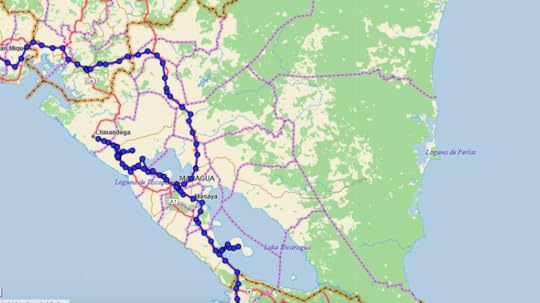 If you look at the map of Nicaragua, you’ll notice that it’s somewhat shaped like a triangle, and the whole north-eastern section of it is forest and mostly road-less, which is why we skipped that area. Though we heard the Caribbean coast was nice, getting there and back from the Pacific side would have been a challenge, not to mention time consuming (it doesn’t look far on the map, but poor road conditions make the journey long). So we stuck to the south-western half which is impressive by itself, dotted with volcanoes, craters, and lakes. We did not experience any of Nicaragua’s famous beaches since we knew we’d be getting plenty of beach time farther along our journey south, so we decided to visit Nicaragua’s distinctive cities, volcanoes, and lakes instead.
If you look at the map of Nicaragua, you’ll notice that it’s somewhat shaped like a triangle, and the whole north-eastern section of it is forest and mostly road-less, which is why we skipped that area. Though we heard the Caribbean coast was nice, getting there and back from the Pacific side would have been a challenge, not to mention time consuming (it doesn’t look far on the map, but poor road conditions make the journey long). So we stuck to the south-western half which is impressive by itself, dotted with volcanoes, craters, and lakes. We did not experience any of Nicaragua’s famous beaches since we knew we’d be getting plenty of beach time farther along our journey south, so we decided to visit Nicaragua’s distinctive cities, volcanoes, and lakes instead.
These days, many travelers are touting Nicaragua as “the new Costa Rica.” My personal opinion after having visited both countries is that Nicaragua is really unlike Costa Rica, and one should not go to Nicaragua thinking it’s simply the cheaper version of Costa Rica (which I originally had thought). First of all, they are climatically very different, which makes the wildlife and vegetation of Costa Rica more rainforest-like, whereas Nicaragua has a larger variety of volcanoes and lakes to explore. Also, because of Nicaragua’s recent popularity, Tim and I did not find it to be that much cheaper than Costa Rica (nor did we find Costa Rica to be as expensive as everyone said). But when people call it “the new Costa Rica,” if they mean that Nicaragua is the new tourist hot-spot of Central America, then that could very well be true.
While in Nicaragua, Tim and I visited archeological sites (Viejo León), boarded down a volcano (Cerro Negro), and hung out on the lakeside beaches of Ometepe Island. Overall, we had an incredible time with almost no bad experiences (heat and mosquitoes excluded).
So if you want to visit Nicaragua, which you definitely should, then here are my top three suggestions on what to do based on our own travels: My Top 3 Suggestions of What to Do in Nicaragua: 3) Visit the Colonial Cities of Granada and Leon Though we only passed through the colorful and quaint town of Granada, we stayed a week in Leon, and can say that if you like historic churches, inviting plazas, brightly painted buildings with terracotta-tiled rooftops, and a laid-back attitude where everyone takes siestas, then these old Spanish colonial towns perfectly fit the bill.
Leon and Granada are not near each other, so if you are visiting Nicaragua and need to pick one of the two, I would say Granada is the more famous of the two and is cleaner, well-restored, and has nicer hotels and restaurants. It even has a whole fleet of horse-drawn carriages to take you around town instead of taxis. Plus, it’s near to the views and fresh breezes of Lake Cocibulca (a.k.a. Lake Nicaragua, where Ometepe Island is). Unfortunately, all these wonderful things mean Granada is expensive. And touristy. Leon, on the other hand, is cheaper, less touristy, and is a backpacker favorite since it’s the jumping-off point to lots of Nicaragua’s famous volcanoes and hikes. Leon boasts plenty of hostels, a pumping night scene, and gorgeous churches. It’s dirtier than Granada (don’t even look at its river, there’s so much trash in it you’ll want to cry), and it’s insanely hot there. It was the hottest place we stayed in Nicaragua, and that says a lot. But if you want to volcano board or check out other amazing volcano hikes, then you’ll probably be stopping by Leon.
During our stay in Leon, it was so full of mosquitoes, that we actually had to set up our tent inside our room to sleep in. And it was sweltering inside that tent, so we placed a fan to face inside, and it was still hot. True, it was the height of the dry season and the hottest part of the year (March), but it was almost unbearable for us. But don’t worry, if you visit, you don’t have to suffer like we did. Simply find a place with AC and you’ll be just fine. 2) Volcanoes! Nicaragua has an astounding 28 volcanoes, 19 of which are active! Some of the world’s most picturesque and impressive volcanoes are in Nicaragua, such as Momotombo (1,258m/4,127ft) on the shores of Lago Xolotlán (a.k.a. Lake Managua), San Cristóbal (1,745m/5,725ft) near the town of Chinandega, and Concepción Volcano (1,610m/5,282ft) which makes up the western side of Ometepe Island. We stood at the foot of all three of these massive smoking megaliths and can say that they are each stunning, heart-pounding, and truly memorable sights to behold. The only volcano that we climbed to the top of was called Cerro Negro (and you guessed it, it’s black in color because of all the volcanic ash). Cerro Negro is active, and you could see and feel it smoking beneath your feet at the top which was a very eerie experience. It is not the most picturesque of Nicaragua’s volcanoes from the ground, but the reason why people scale it is because you can actually ride a wooden board down one side of it, a one-of-a-kind activity called volcano boarding (check out our video Nicaragua Part I to see us in action). It was about an hour hike up and then just a minute boarding down, but it was so much fun, and is certainly the only place in the world where you can do such a bizarre thing. One word of warning if you ever find yourself volcano boarding: keep your speed under control in the beginning or you may quickly get out of control like Tim did. He even flew off at the end, but was mostly unharmed (only had a sore right leg for a few days). In order to go volcano boarding, you must join a tour group, and we joined Quetzaltrekkers which we would highly recommend. Not only are they wonderful and fun people, and you receive a t-shirt at the end, but they give a portion of your money to local children’s education.
Unlike Cerro Negro, Momotombo, and San Cristóbal, Nicaragua also features many dormant volcanoes and ancient volcano-made craters. We hiked up one of these near Managua called Apoyeque, and even though the hike was so hot I just about thought I was going to die, once reaching the edge of the crater, we were greeted with pristine views and refreshing breezes from this crystal lake inside what had once been a massive bowl-like volcano. There was nobody else there, and no houses or any other structures in sight. Even though we were a short day trip from Nicaragua’s capital city, I felt like I could have stepped through a portal in time and might have been standing somewhere in the Jurassic period with Pterodactyls flying overhead. But of all the volcanoes we visited in Nicaragua, I have to say that one of the most unique was Masaya. Not even a half-hour drive from the commercial bustle of Managua, Masaya is a highly-active smoking crater that you can stand on the edge of, look down into, listen to the deep rumbling of the volcano, and you can do this all without any sort of hiking. That’s right, there is a parking lot at the edge of this volcano that you drive right up to! This means that the volcano edge is wheel-chair accessible, which delighted me to think that all types of people can experience this natural wonder which is usually only considered to be accessible to the most fit of hikers.
 Masaya Volcano, Nicaragua.
Masaya Volcano, Nicaragua.  Marisa at Masaya Volcano, Nicaragua. So if you’ve never set foot on a volcano and you want to, Nicaragua is definitely the place to go for all your volcano adventures. 1) Ometepe Island
Marisa at Masaya Volcano, Nicaragua. So if you’ve never set foot on a volcano and you want to, Nicaragua is definitely the place to go for all your volcano adventures. 1) Ometepe Island  Ometepe, Nicaragua For Tim and I, this hourglass-shaped island in a lake was the biggest draw in Nicaragua for us. We had heard about it back in Guatemala, and had been thirsting to see it ever since. Picture this: a tropical island in a giant freshwater lake, the island is made up of two perfectly conical volcanoes and there is a little road that goes all the way around it in a figure eight. Plus, it’s an island that you can easily ferry your motorcycle across to! We were excited, and the place did not disappoint.
Ometepe, Nicaragua For Tim and I, this hourglass-shaped island in a lake was the biggest draw in Nicaragua for us. We had heard about it back in Guatemala, and had been thirsting to see it ever since. Picture this: a tropical island in a giant freshwater lake, the island is made up of two perfectly conical volcanoes and there is a little road that goes all the way around it in a figure eight. Plus, it’s an island that you can easily ferry your motorcycle across to! We were excited, and the place did not disappoint.
Pictures just don’t do it justice, because once you’re there, you’ll realize what a perfect piece of paradise the island of Ometepe is. There are white-face monkeys that swing from the trees, black sand beaches lined with colorful hammocks, heavenly fresh-water swimming holes such as Ojo de Agua, and there are even wild horses roaming the island and beaches! And because it’s an island in a lake and not the ocean, the horses just live out on the beaches eating the grass and drinking the water, they swim and then find shade in the palm trees to escape the heat of the day, much like the people of Ometepe. Pure divinity! I will say, Ometepe is hot, really hot. So if you’re one of the many people who want to climb one or both of the volcanoes while there, just remember that it’s going to be a sweltering trek. But if you’re the type of person who just wants to relax by the water like we did (Ojo de Agua or Santo Domingo Beach), you will definitely be in the right place for that.
The worst part of Ometepe for us was the ferry over. Not that there was anything wrong with it: it was reasonably priced, and it left on time (more or less). But it’s just that whenever we put our bike on a floating craft of some sort, it’s always a bit nerve-wracking. And it was hot on the ferry and people were fighting for seats, but it was all worth it because the destination was so great.
 Squeezing our bike onto ferries is not our idea of fun. Ometepe, Nicaragua There are a couple of little towns on Ometepe Island with lots of places to eat, drink, and stay. We opted to camp on a lakeside farmstead that was walking distance to a local’s organic restaurant. Restaurants and amenities are expensive on the island, but that’s expected since if it’s not bananas, then it’s probably being shipped there.
Squeezing our bike onto ferries is not our idea of fun. Ometepe, Nicaragua There are a couple of little towns on Ometepe Island with lots of places to eat, drink, and stay. We opted to camp on a lakeside farmstead that was walking distance to a local’s organic restaurant. Restaurants and amenities are expensive on the island, but that’s expected since if it’s not bananas, then it’s probably being shipped there.
 Our heavenly campsite on Ometepe, Nicaragua. So if you want volcanoes, beaches, tropical wildlife, and a taste of the local Nicaraguan culture all in one place, Ometepe has it all and should not be missed!
Our heavenly campsite on Ometepe, Nicaragua. So if you want volcanoes, beaches, tropical wildlife, and a taste of the local Nicaraguan culture all in one place, Ometepe has it all and should not be missed!
A few things I found interesting or surprising about Nicaragua: Horses are Everywhere! Even in the middle of Managua, the capital city of Nicaragua, horses were pulling carts and wagons. Horses are still used in Nicaragua for daily life by many people, such as cowboys herding their cattle, or merchants selling their fruits and vegetables from a horse cart. They are even used for transporting people and tourists around town. But most surprising to me was that there seemed to be wild horses all around Nicaragua as well. Not just Ometepe Island had wild horses, there were herds just roaming the sides of country roads all over the place. It’s dry: For some reason, I thought Nicaragua was going to be a humid rainy jungle, and it really wasn’t at all. Well, it does supposedly get much wetter in the rainy season (we came in the dry season), but besides the monkeys in the trees of Ometepe Island, we did not really encounter anything that would remotely be called rainforest. Nicaragua was mostly farmland, dry fields with scraggily trees adding a bit of green. Nicaragua is considered to be a dry tropical climate, not desert, but not rainforest either, and it more resembled its northern neighbors of Honduras and El Salvador than its rainy southern neighbors of Costa Rica and Panama.
It’s dry: For some reason, I thought Nicaragua was going to be a humid rainy jungle, and it really wasn’t at all. Well, it does supposedly get much wetter in the rainy season (we came in the dry season), but besides the monkeys in the trees of Ometepe Island, we did not really encounter anything that would remotely be called rainforest. Nicaragua was mostly farmland, dry fields with scraggily trees adding a bit of green. Nicaragua is considered to be a dry tropical climate, not desert, but not rainforest either, and it more resembled its northern neighbors of Honduras and El Salvador than its rainy southern neighbors of Costa Rica and Panama.  No tortillas:
I don’t know what I was expecting with Nicaraguan food, but since I really had no idea what it could be, I just figured it would be like Mexican food. Of course it wasn’t, though many of the same ingredients of corn, tomatoes, rice, and beans were used, they were prepared in different ways. Unlike Mexico or Guatemala, tortillas and refried beans were not normally served in Nicaragua. The typical Nicaraguan food that you find on the street consists of grilled and stewed meats alongside a rice and bean mixture called Gallo Pinto (colored rooster is what it’s called, which is strange since there’s definitely no chicken in it, though the black beans do give it a lovely purple color). Every meal nearly always comes with fried plantains (called maduros) and instead of tortilla chips, you often find plantain chips, which I just adored.
No tortillas:
I don’t know what I was expecting with Nicaraguan food, but since I really had no idea what it could be, I just figured it would be like Mexican food. Of course it wasn’t, though many of the same ingredients of corn, tomatoes, rice, and beans were used, they were prepared in different ways. Unlike Mexico or Guatemala, tortillas and refried beans were not normally served in Nicaragua. The typical Nicaraguan food that you find on the street consists of grilled and stewed meats alongside a rice and bean mixture called Gallo Pinto (colored rooster is what it’s called, which is strange since there’s definitely no chicken in it, though the black beans do give it a lovely purple color). Every meal nearly always comes with fried plantains (called maduros) and instead of tortilla chips, you often find plantain chips, which I just adored.
And finally, if you are thinking of one day visiting the country... A few of my tips of what to expect in Nicaragua: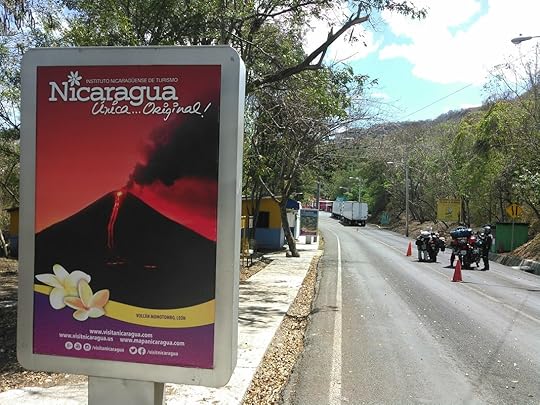 As far as cleanliness, litter, and road conditions go, I felt Nicaragua was somewhere in between the pervasive trash of Honduras, and the pristine highways of Costa Rica. It is definitely poor, and you are reminded of this fact on a daily basis by the burning garbage and developing infrastructure. But the people of Nicaragua are so friendly and happy, that sometimes it’s easy to forget the hardships they have had to face.
As far as cleanliness, litter, and road conditions go, I felt Nicaragua was somewhere in between the pervasive trash of Honduras, and the pristine highways of Costa Rica. It is definitely poor, and you are reminded of this fact on a daily basis by the burning garbage and developing infrastructure. But the people of Nicaragua are so friendly and happy, that sometimes it’s easy to forget the hardships they have had to face.
Nicaragua is hot (have I mentioned that yet?), and you can say goodbye to taking hot showers (but you won’t want them anyway). Most of the time our showers consisted of a water spout coming out of the wall, but that was fine with us, and we found ourselves sometimes taking showers three or four times a day just so our brains didn’t boil in our heads.
And lastly, in order to fully enjoy Nicaragua, you have to be alright with a bit of grime, crazy drivers, and unexpected road conditions. You have to come to the understanding that things will take a long time, nothing will run on a schedule, and plans may have to change. But if you can do that, you will have a great time in Nicaragua, (and this could probably be said for the whole of Central America). Overall, Nicaragua was unexpected in its austere beauty and the incredible hospitality of the people there (I’m looking at you Yesenia and Raul!). With all its smoking volcanoes, the country is full of opportunities for adventure, and with its massive lakes and long coastlines, there are also plenty of places to relax by the water. Laid-back, and coming into its own, Nicaragua is long over its old reputation, and it has now turned a new page to rightfully become the latest rage in Central American destinations.
Overall, Nicaragua was unexpected in its austere beauty and the incredible hospitality of the people there (I’m looking at you Yesenia and Raul!). With all its smoking volcanoes, the country is full of opportunities for adventure, and with its massive lakes and long coastlines, there are also plenty of places to relax by the water. Laid-back, and coming into its own, Nicaragua is long over its old reputation, and it has now turned a new page to rightfully become the latest rage in Central American destinations.
Of course, if I could go back in time and tell myself that not even a decade later I would be traversing this country by motorcycle for over a month, I probably wouldn’t have believed it. And Nicaragua turned out to be nothing like my imagined doomsday exaggerations. It is actually an incredible place full of friendly people, breathtaking views, and the most dangerous thing we encountered while there were its fire-breathing volcanoes.
 Me, the bike, and some wild horses in front of San Cristóbal Volcano, Chinandega, Nicaragua. Unlike what I used to think, Nicaragua has statistically become one of the safest Central American countries, and its popularity as a tourist destination has skyrocketed in recent years. That being said, soon after we left in March 2018, a string of violent riots over a new social security referendum may have changed the country’s overall safety record. The government has now repealed this unpopular referendum, and things have supposedly returned to normal, but even so, if you plan to visit, it’s a good idea to keep up to date with your news.
Me, the bike, and some wild horses in front of San Cristóbal Volcano, Chinandega, Nicaragua. Unlike what I used to think, Nicaragua has statistically become one of the safest Central American countries, and its popularity as a tourist destination has skyrocketed in recent years. That being said, soon after we left in March 2018, a string of violent riots over a new social security referendum may have changed the country’s overall safety record. The government has now repealed this unpopular referendum, and things have supposedly returned to normal, but even so, if you plan to visit, it’s a good idea to keep up to date with your news.  If you look at the map of Nicaragua, you’ll notice that it’s somewhat shaped like a triangle, and the whole north-eastern section of it is forest and mostly road-less, which is why we skipped that area. Though we heard the Caribbean coast was nice, getting there and back from the Pacific side would have been a challenge, not to mention time consuming (it doesn’t look far on the map, but poor road conditions make the journey long). So we stuck to the south-western half which is impressive by itself, dotted with volcanoes, craters, and lakes. We did not experience any of Nicaragua’s famous beaches since we knew we’d be getting plenty of beach time farther along our journey south, so we decided to visit Nicaragua’s distinctive cities, volcanoes, and lakes instead.
If you look at the map of Nicaragua, you’ll notice that it’s somewhat shaped like a triangle, and the whole north-eastern section of it is forest and mostly road-less, which is why we skipped that area. Though we heard the Caribbean coast was nice, getting there and back from the Pacific side would have been a challenge, not to mention time consuming (it doesn’t look far on the map, but poor road conditions make the journey long). So we stuck to the south-western half which is impressive by itself, dotted with volcanoes, craters, and lakes. We did not experience any of Nicaragua’s famous beaches since we knew we’d be getting plenty of beach time farther along our journey south, so we decided to visit Nicaragua’s distinctive cities, volcanoes, and lakes instead.These days, many travelers are touting Nicaragua as “the new Costa Rica.” My personal opinion after having visited both countries is that Nicaragua is really unlike Costa Rica, and one should not go to Nicaragua thinking it’s simply the cheaper version of Costa Rica (which I originally had thought). First of all, they are climatically very different, which makes the wildlife and vegetation of Costa Rica more rainforest-like, whereas Nicaragua has a larger variety of volcanoes and lakes to explore. Also, because of Nicaragua’s recent popularity, Tim and I did not find it to be that much cheaper than Costa Rica (nor did we find Costa Rica to be as expensive as everyone said). But when people call it “the new Costa Rica,” if they mean that Nicaragua is the new tourist hot-spot of Central America, then that could very well be true.
While in Nicaragua, Tim and I visited archeological sites (Viejo León), boarded down a volcano (Cerro Negro), and hung out on the lakeside beaches of Ometepe Island. Overall, we had an incredible time with almost no bad experiences (heat and mosquitoes excluded).
So if you want to visit Nicaragua, which you definitely should, then here are my top three suggestions on what to do based on our own travels: My Top 3 Suggestions of What to Do in Nicaragua: 3) Visit the Colonial Cities of Granada and Leon Though we only passed through the colorful and quaint town of Granada, we stayed a week in Leon, and can say that if you like historic churches, inviting plazas, brightly painted buildings with terracotta-tiled rooftops, and a laid-back attitude where everyone takes siestas, then these old Spanish colonial towns perfectly fit the bill.
Leon and Granada are not near each other, so if you are visiting Nicaragua and need to pick one of the two, I would say Granada is the more famous of the two and is cleaner, well-restored, and has nicer hotels and restaurants. It even has a whole fleet of horse-drawn carriages to take you around town instead of taxis. Plus, it’s near to the views and fresh breezes of Lake Cocibulca (a.k.a. Lake Nicaragua, where Ometepe Island is). Unfortunately, all these wonderful things mean Granada is expensive. And touristy. Leon, on the other hand, is cheaper, less touristy, and is a backpacker favorite since it’s the jumping-off point to lots of Nicaragua’s famous volcanoes and hikes. Leon boasts plenty of hostels, a pumping night scene, and gorgeous churches. It’s dirtier than Granada (don’t even look at its river, there’s so much trash in it you’ll want to cry), and it’s insanely hot there. It was the hottest place we stayed in Nicaragua, and that says a lot. But if you want to volcano board or check out other amazing volcano hikes, then you’ll probably be stopping by Leon.
During our stay in Leon, it was so full of mosquitoes, that we actually had to set up our tent inside our room to sleep in. And it was sweltering inside that tent, so we placed a fan to face inside, and it was still hot. True, it was the height of the dry season and the hottest part of the year (March), but it was almost unbearable for us. But don’t worry, if you visit, you don’t have to suffer like we did. Simply find a place with AC and you’ll be just fine. 2) Volcanoes! Nicaragua has an astounding 28 volcanoes, 19 of which are active! Some of the world’s most picturesque and impressive volcanoes are in Nicaragua, such as Momotombo (1,258m/4,127ft) on the shores of Lago Xolotlán (a.k.a. Lake Managua), San Cristóbal (1,745m/5,725ft) near the town of Chinandega, and Concepción Volcano (1,610m/5,282ft) which makes up the western side of Ometepe Island. We stood at the foot of all three of these massive smoking megaliths and can say that they are each stunning, heart-pounding, and truly memorable sights to behold. The only volcano that we climbed to the top of was called Cerro Negro (and you guessed it, it’s black in color because of all the volcanic ash). Cerro Negro is active, and you could see and feel it smoking beneath your feet at the top which was a very eerie experience. It is not the most picturesque of Nicaragua’s volcanoes from the ground, but the reason why people scale it is because you can actually ride a wooden board down one side of it, a one-of-a-kind activity called volcano boarding (check out our video Nicaragua Part I to see us in action). It was about an hour hike up and then just a minute boarding down, but it was so much fun, and is certainly the only place in the world where you can do such a bizarre thing. One word of warning if you ever find yourself volcano boarding: keep your speed under control in the beginning or you may quickly get out of control like Tim did. He even flew off at the end, but was mostly unharmed (only had a sore right leg for a few days). In order to go volcano boarding, you must join a tour group, and we joined Quetzaltrekkers which we would highly recommend. Not only are they wonderful and fun people, and you receive a t-shirt at the end, but they give a portion of your money to local children’s education.
Unlike Cerro Negro, Momotombo, and San Cristóbal, Nicaragua also features many dormant volcanoes and ancient volcano-made craters. We hiked up one of these near Managua called Apoyeque, and even though the hike was so hot I just about thought I was going to die, once reaching the edge of the crater, we were greeted with pristine views and refreshing breezes from this crystal lake inside what had once been a massive bowl-like volcano. There was nobody else there, and no houses or any other structures in sight. Even though we were a short day trip from Nicaragua’s capital city, I felt like I could have stepped through a portal in time and might have been standing somewhere in the Jurassic period with Pterodactyls flying overhead. But of all the volcanoes we visited in Nicaragua, I have to say that one of the most unique was Masaya. Not even a half-hour drive from the commercial bustle of Managua, Masaya is a highly-active smoking crater that you can stand on the edge of, look down into, listen to the deep rumbling of the volcano, and you can do this all without any sort of hiking. That’s right, there is a parking lot at the edge of this volcano that you drive right up to! This means that the volcano edge is wheel-chair accessible, which delighted me to think that all types of people can experience this natural wonder which is usually only considered to be accessible to the most fit of hikers.
 Masaya Volcano, Nicaragua.
Masaya Volcano, Nicaragua.  Marisa at Masaya Volcano, Nicaragua. So if you’ve never set foot on a volcano and you want to, Nicaragua is definitely the place to go for all your volcano adventures. 1) Ometepe Island
Marisa at Masaya Volcano, Nicaragua. So if you’ve never set foot on a volcano and you want to, Nicaragua is definitely the place to go for all your volcano adventures. 1) Ometepe Island  Ometepe, Nicaragua For Tim and I, this hourglass-shaped island in a lake was the biggest draw in Nicaragua for us. We had heard about it back in Guatemala, and had been thirsting to see it ever since. Picture this: a tropical island in a giant freshwater lake, the island is made up of two perfectly conical volcanoes and there is a little road that goes all the way around it in a figure eight. Plus, it’s an island that you can easily ferry your motorcycle across to! We were excited, and the place did not disappoint.
Ometepe, Nicaragua For Tim and I, this hourglass-shaped island in a lake was the biggest draw in Nicaragua for us. We had heard about it back in Guatemala, and had been thirsting to see it ever since. Picture this: a tropical island in a giant freshwater lake, the island is made up of two perfectly conical volcanoes and there is a little road that goes all the way around it in a figure eight. Plus, it’s an island that you can easily ferry your motorcycle across to! We were excited, and the place did not disappoint.Pictures just don’t do it justice, because once you’re there, you’ll realize what a perfect piece of paradise the island of Ometepe is. There are white-face monkeys that swing from the trees, black sand beaches lined with colorful hammocks, heavenly fresh-water swimming holes such as Ojo de Agua, and there are even wild horses roaming the island and beaches! And because it’s an island in a lake and not the ocean, the horses just live out on the beaches eating the grass and drinking the water, they swim and then find shade in the palm trees to escape the heat of the day, much like the people of Ometepe. Pure divinity! I will say, Ometepe is hot, really hot. So if you’re one of the many people who want to climb one or both of the volcanoes while there, just remember that it’s going to be a sweltering trek. But if you’re the type of person who just wants to relax by the water like we did (Ojo de Agua or Santo Domingo Beach), you will definitely be in the right place for that.
The worst part of Ometepe for us was the ferry over. Not that there was anything wrong with it: it was reasonably priced, and it left on time (more or less). But it’s just that whenever we put our bike on a floating craft of some sort, it’s always a bit nerve-wracking. And it was hot on the ferry and people were fighting for seats, but it was all worth it because the destination was so great.
 Squeezing our bike onto ferries is not our idea of fun. Ometepe, Nicaragua There are a couple of little towns on Ometepe Island with lots of places to eat, drink, and stay. We opted to camp on a lakeside farmstead that was walking distance to a local’s organic restaurant. Restaurants and amenities are expensive on the island, but that’s expected since if it’s not bananas, then it’s probably being shipped there.
Squeezing our bike onto ferries is not our idea of fun. Ometepe, Nicaragua There are a couple of little towns on Ometepe Island with lots of places to eat, drink, and stay. We opted to camp on a lakeside farmstead that was walking distance to a local’s organic restaurant. Restaurants and amenities are expensive on the island, but that’s expected since if it’s not bananas, then it’s probably being shipped there. Our heavenly campsite on Ometepe, Nicaragua. So if you want volcanoes, beaches, tropical wildlife, and a taste of the local Nicaraguan culture all in one place, Ometepe has it all and should not be missed!
Our heavenly campsite on Ometepe, Nicaragua. So if you want volcanoes, beaches, tropical wildlife, and a taste of the local Nicaraguan culture all in one place, Ometepe has it all and should not be missed!A few things I found interesting or surprising about Nicaragua: Horses are Everywhere! Even in the middle of Managua, the capital city of Nicaragua, horses were pulling carts and wagons. Horses are still used in Nicaragua for daily life by many people, such as cowboys herding their cattle, or merchants selling their fruits and vegetables from a horse cart. They are even used for transporting people and tourists around town. But most surprising to me was that there seemed to be wild horses all around Nicaragua as well. Not just Ometepe Island had wild horses, there were herds just roaming the sides of country roads all over the place.
 It’s dry: For some reason, I thought Nicaragua was going to be a humid rainy jungle, and it really wasn’t at all. Well, it does supposedly get much wetter in the rainy season (we came in the dry season), but besides the monkeys in the trees of Ometepe Island, we did not really encounter anything that would remotely be called rainforest. Nicaragua was mostly farmland, dry fields with scraggily trees adding a bit of green. Nicaragua is considered to be a dry tropical climate, not desert, but not rainforest either, and it more resembled its northern neighbors of Honduras and El Salvador than its rainy southern neighbors of Costa Rica and Panama.
It’s dry: For some reason, I thought Nicaragua was going to be a humid rainy jungle, and it really wasn’t at all. Well, it does supposedly get much wetter in the rainy season (we came in the dry season), but besides the monkeys in the trees of Ometepe Island, we did not really encounter anything that would remotely be called rainforest. Nicaragua was mostly farmland, dry fields with scraggily trees adding a bit of green. Nicaragua is considered to be a dry tropical climate, not desert, but not rainforest either, and it more resembled its northern neighbors of Honduras and El Salvador than its rainy southern neighbors of Costa Rica and Panama.  No tortillas:
I don’t know what I was expecting with Nicaraguan food, but since I really had no idea what it could be, I just figured it would be like Mexican food. Of course it wasn’t, though many of the same ingredients of corn, tomatoes, rice, and beans were used, they were prepared in different ways. Unlike Mexico or Guatemala, tortillas and refried beans were not normally served in Nicaragua. The typical Nicaraguan food that you find on the street consists of grilled and stewed meats alongside a rice and bean mixture called Gallo Pinto (colored rooster is what it’s called, which is strange since there’s definitely no chicken in it, though the black beans do give it a lovely purple color). Every meal nearly always comes with fried plantains (called maduros) and instead of tortilla chips, you often find plantain chips, which I just adored.
No tortillas:
I don’t know what I was expecting with Nicaraguan food, but since I really had no idea what it could be, I just figured it would be like Mexican food. Of course it wasn’t, though many of the same ingredients of corn, tomatoes, rice, and beans were used, they were prepared in different ways. Unlike Mexico or Guatemala, tortillas and refried beans were not normally served in Nicaragua. The typical Nicaraguan food that you find on the street consists of grilled and stewed meats alongside a rice and bean mixture called Gallo Pinto (colored rooster is what it’s called, which is strange since there’s definitely no chicken in it, though the black beans do give it a lovely purple color). Every meal nearly always comes with fried plantains (called maduros) and instead of tortilla chips, you often find plantain chips, which I just adored.And finally, if you are thinking of one day visiting the country... A few of my tips of what to expect in Nicaragua:
 As far as cleanliness, litter, and road conditions go, I felt Nicaragua was somewhere in between the pervasive trash of Honduras, and the pristine highways of Costa Rica. It is definitely poor, and you are reminded of this fact on a daily basis by the burning garbage and developing infrastructure. But the people of Nicaragua are so friendly and happy, that sometimes it’s easy to forget the hardships they have had to face.
As far as cleanliness, litter, and road conditions go, I felt Nicaragua was somewhere in between the pervasive trash of Honduras, and the pristine highways of Costa Rica. It is definitely poor, and you are reminded of this fact on a daily basis by the burning garbage and developing infrastructure. But the people of Nicaragua are so friendly and happy, that sometimes it’s easy to forget the hardships they have had to face.Nicaragua is hot (have I mentioned that yet?), and you can say goodbye to taking hot showers (but you won’t want them anyway). Most of the time our showers consisted of a water spout coming out of the wall, but that was fine with us, and we found ourselves sometimes taking showers three or four times a day just so our brains didn’t boil in our heads.
And lastly, in order to fully enjoy Nicaragua, you have to be alright with a bit of grime, crazy drivers, and unexpected road conditions. You have to come to the understanding that things will take a long time, nothing will run on a schedule, and plans may have to change. But if you can do that, you will have a great time in Nicaragua, (and this could probably be said for the whole of Central America).
 Overall, Nicaragua was unexpected in its austere beauty and the incredible hospitality of the people there (I’m looking at you Yesenia and Raul!). With all its smoking volcanoes, the country is full of opportunities for adventure, and with its massive lakes and long coastlines, there are also plenty of places to relax by the water. Laid-back, and coming into its own, Nicaragua is long over its old reputation, and it has now turned a new page to rightfully become the latest rage in Central American destinations.
Overall, Nicaragua was unexpected in its austere beauty and the incredible hospitality of the people there (I’m looking at you Yesenia and Raul!). With all its smoking volcanoes, the country is full of opportunities for adventure, and with its massive lakes and long coastlines, there are also plenty of places to relax by the water. Laid-back, and coming into its own, Nicaragua is long over its old reputation, and it has now turned a new page to rightfully become the latest rage in Central American destinations.
Published on May 13, 2018 12:11
April 18, 2018
The Savior and the Depths
By: Tim Notier  Our time in El Salvador and Honduras was short and brief, but we were able to absorb a taste of what it had to offer. Honestly, these two countries were on our “worry" list. Marisa had spent the last two years before our trip as an ESL (English as a second language) teacher, and many of her students were refugees from these countries. We have always tried to avoid the rhetoric that Mexico and (enter “dangerous" country here) is not safe, especially when it comes from people who have only heard about place, and who have never actually been. But, hearing first-hand accounts of how life can be in these countries from children who have witnessed unimaginable horrors, shines a light of actual perspective.
Our time in El Salvador and Honduras was short and brief, but we were able to absorb a taste of what it had to offer. Honestly, these two countries were on our “worry" list. Marisa had spent the last two years before our trip as an ESL (English as a second language) teacher, and many of her students were refugees from these countries. We have always tried to avoid the rhetoric that Mexico and (enter “dangerous" country here) is not safe, especially when it comes from people who have only heard about place, and who have never actually been. But, hearing first-hand accounts of how life can be in these countries from children who have witnessed unimaginable horrors, shines a light of actual perspective.
Some of Marisa's old students asked her, “Why would you go to the country I fled?"
These kids’ lives have been put through so much terror and abuse that they made a long journey to escape the inhumanity of their homeland, and hoped for a better future in... Arkansas(?). Marisa was able to bond with them, and play an important role in their lives when they sometimes had no family in the States to turn to for support or attention, and she took their stories to heart. El Salvador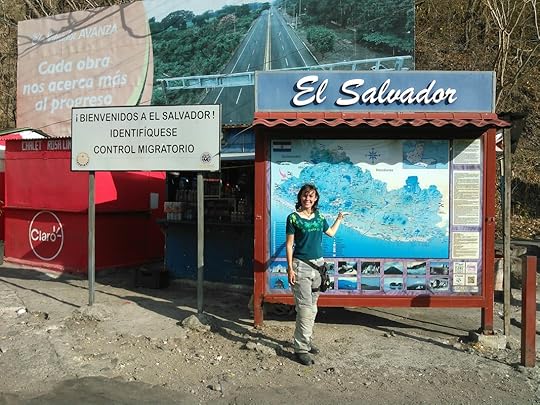 Marisa at the border between Guatemala and El Salvador. - On a lighter note, fun fact: Salvador means “Savior" and is a popular last name in many romance languages. My old direct boss's name was David Salvatori (Italian) and his boss, the VP of sales, was Doug Lord. I was the “acting" manager, I say acting, because that was precisely what I was doing. I had eleven employees under my management, and I would constantly remind them that we work for D. Lord and D. Savior, and that one day, one of the twelve of us would betray them. (Spoiler alert, it was me!) My employees respected my dark humor the day I told them I had put in my two-week notice.
Marisa at the border between Guatemala and El Salvador. - On a lighter note, fun fact: Salvador means “Savior" and is a popular last name in many romance languages. My old direct boss's name was David Salvatori (Italian) and his boss, the VP of sales, was Doug Lord. I was the “acting" manager, I say acting, because that was precisely what I was doing. I had eleven employees under my management, and I would constantly remind them that we work for D. Lord and D. Savior, and that one day, one of the twelve of us would betray them. (Spoiler alert, it was me!) My employees respected my dark humor the day I told them I had put in my two-week notice.
Back to El Salvador: Our first attraction on our list were the ruins of Tazumal, a Mayan archeological site. Marisa and I like our ruins, so we knew we would be visiting them even if they were not as grand as some of the structures we have seen in our travels so far. The site was not large, and only took ten minutes to completely navigate, and sadly it represented more of a concrete shell that was poured over the original structure, but it was a nice visit none-the-less. 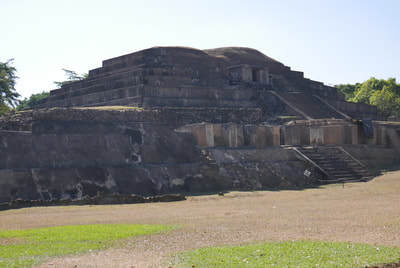
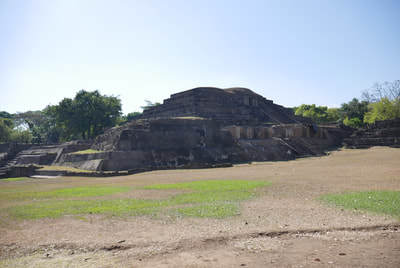
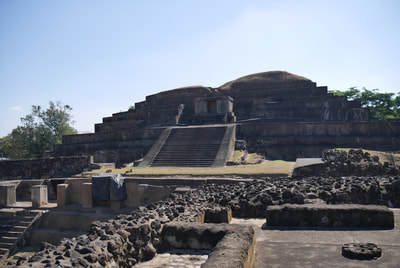
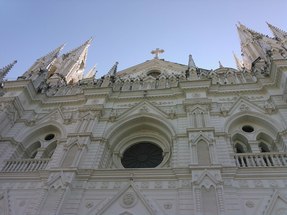 Santa Ana Cathedral After our Mayan visit, we spent the next couple days pretty low-key. We climbed the spiral staircase of a church tower to view the city of Santa Ana with a most spectacular view. Santa Ana is a Spanish colonial city that still holds much of its former charm. Former charm is the key phrase, as it's quite run-down now, and currently feels more like a post-apocalyptic version of Antigua, Guatemala which has had lots of tourist money flowing into its restoration. From Santa Ana, we zipped through the rest of El Salvador fairly quickly.
Santa Ana Cathedral After our Mayan visit, we spent the next couple days pretty low-key. We climbed the spiral staircase of a church tower to view the city of Santa Ana with a most spectacular view. Santa Ana is a Spanish colonial city that still holds much of its former charm. Former charm is the key phrase, as it's quite run-down now, and currently feels more like a post-apocalyptic version of Antigua, Guatemala which has had lots of tourist money flowing into its restoration. From Santa Ana, we zipped through the rest of El Salvador fairly quickly.  View from the Cathedral of Santa Ana, El Salvador.
View from the Cathedral of Santa Ana, El Salvador. 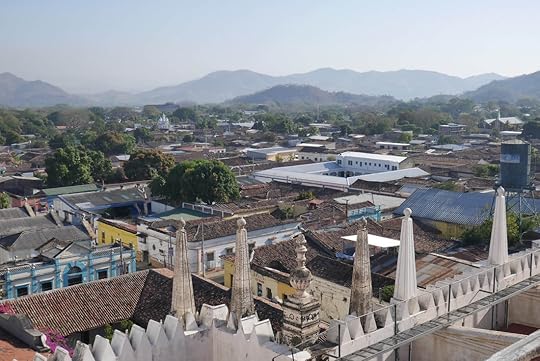 One of the things we thoroughly enjoyed about the country was that the food was great (pupusas!) and cheap ($4 steaks). Plus El Salvador uses US dollars as their currency, which made life easy for us.
One of the things we thoroughly enjoyed about the country was that the food was great (pupusas!) and cheap ($4 steaks). Plus El Salvador uses US dollars as their currency, which made life easy for us.
While in the capital, San Salvador, we stayed in a cheap hotel and were treated like kings. If you used your imagination, you could see how grand the small hotel was in its heyday, but that was far in the past. Out of the twelve or so rooms they had available, we were their only guests for the two days we spent relaxing in the pool.
You could see that this was a country trying to find its place in the modern world. We by no means rode very far into the back roads, and we did not visit any beaches or volcanoes (what El Salvador is famous for). So though we cannot give a proper full report on the country as a whole, it was pleasant, and a mandatory pass through destination. Honduras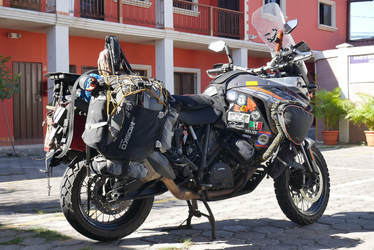 Honduras had a similar vibe, and because we skimmed through the southern Pacific tip, our stay there was extremely short and uneventful. We heard incredible things about Honduras, especially about the northern coastline and Mayan ruins, but at the time we were there, road blocks and protests were reported across the country due to the contested elections. So we skipped the distant sights and spent only two days rushing through Honduras to get to Nicaragua.
Honduras had a similar vibe, and because we skimmed through the southern Pacific tip, our stay there was extremely short and uneventful. We heard incredible things about Honduras, especially about the northern coastline and Mayan ruins, but at the time we were there, road blocks and protests were reported across the country due to the contested elections. So we skipped the distant sights and spent only two days rushing through Honduras to get to Nicaragua.
It's strange because in Guatemala the locals would warn us about El Salvador, we would inevitably survive, then be warned by the El Salvadorans about Honduras. This chain of “warnings" started way back in the United States, and has not stopped as of yet. The reality of it all is unfortunately tainted by people’s fears and lack of actual experience in any given place. But we would continue fearlessly, mostly because there was no other option, and sometimes with a little fear.
Honduras translates to “depths" and sadly, we did not ride into the honduras of Honduras. We kept to the main roads and made our way to the boarder of Nicaragua in a speedy fashion. The promise of a safer environment, nature, and sloths was calling me to enter and explore.
Both El Salvador and Honduras were not as scary as we assumed, and as an afterthought, I am slightly upset that we did not explore more into some of their offerings.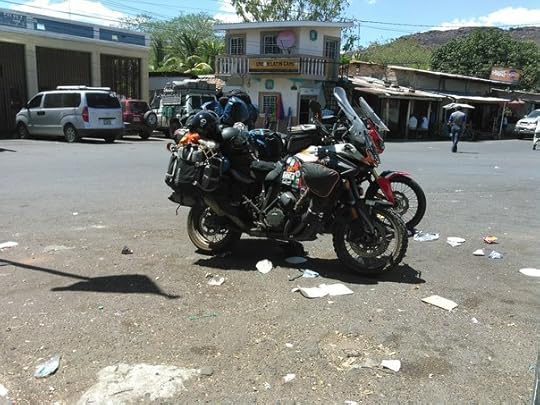 Our bikes at the Honduras/El Salvador border. Unfortunately, there was a lot of trash.
Our bikes at the Honduras/El Salvador border. Unfortunately, there was a lot of trash.
 Our time in El Salvador and Honduras was short and brief, but we were able to absorb a taste of what it had to offer. Honestly, these two countries were on our “worry" list. Marisa had spent the last two years before our trip as an ESL (English as a second language) teacher, and many of her students were refugees from these countries. We have always tried to avoid the rhetoric that Mexico and (enter “dangerous" country here) is not safe, especially when it comes from people who have only heard about place, and who have never actually been. But, hearing first-hand accounts of how life can be in these countries from children who have witnessed unimaginable horrors, shines a light of actual perspective.
Our time in El Salvador and Honduras was short and brief, but we were able to absorb a taste of what it had to offer. Honestly, these two countries were on our “worry" list. Marisa had spent the last two years before our trip as an ESL (English as a second language) teacher, and many of her students were refugees from these countries. We have always tried to avoid the rhetoric that Mexico and (enter “dangerous" country here) is not safe, especially when it comes from people who have only heard about place, and who have never actually been. But, hearing first-hand accounts of how life can be in these countries from children who have witnessed unimaginable horrors, shines a light of actual perspective.Some of Marisa's old students asked her, “Why would you go to the country I fled?"
These kids’ lives have been put through so much terror and abuse that they made a long journey to escape the inhumanity of their homeland, and hoped for a better future in... Arkansas(?). Marisa was able to bond with them, and play an important role in their lives when they sometimes had no family in the States to turn to for support or attention, and she took their stories to heart. El Salvador
 Marisa at the border between Guatemala and El Salvador. - On a lighter note, fun fact: Salvador means “Savior" and is a popular last name in many romance languages. My old direct boss's name was David Salvatori (Italian) and his boss, the VP of sales, was Doug Lord. I was the “acting" manager, I say acting, because that was precisely what I was doing. I had eleven employees under my management, and I would constantly remind them that we work for D. Lord and D. Savior, and that one day, one of the twelve of us would betray them. (Spoiler alert, it was me!) My employees respected my dark humor the day I told them I had put in my two-week notice.
Marisa at the border between Guatemala and El Salvador. - On a lighter note, fun fact: Salvador means “Savior" and is a popular last name in many romance languages. My old direct boss's name was David Salvatori (Italian) and his boss, the VP of sales, was Doug Lord. I was the “acting" manager, I say acting, because that was precisely what I was doing. I had eleven employees under my management, and I would constantly remind them that we work for D. Lord and D. Savior, and that one day, one of the twelve of us would betray them. (Spoiler alert, it was me!) My employees respected my dark humor the day I told them I had put in my two-week notice.Back to El Salvador: Our first attraction on our list were the ruins of Tazumal, a Mayan archeological site. Marisa and I like our ruins, so we knew we would be visiting them even if they were not as grand as some of the structures we have seen in our travels so far. The site was not large, and only took ten minutes to completely navigate, and sadly it represented more of a concrete shell that was poured over the original structure, but it was a nice visit none-the-less.



 Santa Ana Cathedral After our Mayan visit, we spent the next couple days pretty low-key. We climbed the spiral staircase of a church tower to view the city of Santa Ana with a most spectacular view. Santa Ana is a Spanish colonial city that still holds much of its former charm. Former charm is the key phrase, as it's quite run-down now, and currently feels more like a post-apocalyptic version of Antigua, Guatemala which has had lots of tourist money flowing into its restoration. From Santa Ana, we zipped through the rest of El Salvador fairly quickly.
Santa Ana Cathedral After our Mayan visit, we spent the next couple days pretty low-key. We climbed the spiral staircase of a church tower to view the city of Santa Ana with a most spectacular view. Santa Ana is a Spanish colonial city that still holds much of its former charm. Former charm is the key phrase, as it's quite run-down now, and currently feels more like a post-apocalyptic version of Antigua, Guatemala which has had lots of tourist money flowing into its restoration. From Santa Ana, we zipped through the rest of El Salvador fairly quickly.  View from the Cathedral of Santa Ana, El Salvador.
View from the Cathedral of Santa Ana, El Salvador.  One of the things we thoroughly enjoyed about the country was that the food was great (pupusas!) and cheap ($4 steaks). Plus El Salvador uses US dollars as their currency, which made life easy for us.
One of the things we thoroughly enjoyed about the country was that the food was great (pupusas!) and cheap ($4 steaks). Plus El Salvador uses US dollars as their currency, which made life easy for us.While in the capital, San Salvador, we stayed in a cheap hotel and were treated like kings. If you used your imagination, you could see how grand the small hotel was in its heyday, but that was far in the past. Out of the twelve or so rooms they had available, we were their only guests for the two days we spent relaxing in the pool.
You could see that this was a country trying to find its place in the modern world. We by no means rode very far into the back roads, and we did not visit any beaches or volcanoes (what El Salvador is famous for). So though we cannot give a proper full report on the country as a whole, it was pleasant, and a mandatory pass through destination. Honduras
 Honduras had a similar vibe, and because we skimmed through the southern Pacific tip, our stay there was extremely short and uneventful. We heard incredible things about Honduras, especially about the northern coastline and Mayan ruins, but at the time we were there, road blocks and protests were reported across the country due to the contested elections. So we skipped the distant sights and spent only two days rushing through Honduras to get to Nicaragua.
Honduras had a similar vibe, and because we skimmed through the southern Pacific tip, our stay there was extremely short and uneventful. We heard incredible things about Honduras, especially about the northern coastline and Mayan ruins, but at the time we were there, road blocks and protests were reported across the country due to the contested elections. So we skipped the distant sights and spent only two days rushing through Honduras to get to Nicaragua.It's strange because in Guatemala the locals would warn us about El Salvador, we would inevitably survive, then be warned by the El Salvadorans about Honduras. This chain of “warnings" started way back in the United States, and has not stopped as of yet. The reality of it all is unfortunately tainted by people’s fears and lack of actual experience in any given place. But we would continue fearlessly, mostly because there was no other option, and sometimes with a little fear.
Honduras translates to “depths" and sadly, we did not ride into the honduras of Honduras. We kept to the main roads and made our way to the boarder of Nicaragua in a speedy fashion. The promise of a safer environment, nature, and sloths was calling me to enter and explore.
Both El Salvador and Honduras were not as scary as we assumed, and as an afterthought, I am slightly upset that we did not explore more into some of their offerings.
 Our bikes at the Honduras/El Salvador border. Unfortunately, there was a lot of trash.
Our bikes at the Honduras/El Salvador border. Unfortunately, there was a lot of trash.
Published on April 18, 2018 08:16
March 23, 2018
Good Times in Guatemala
By Marisa 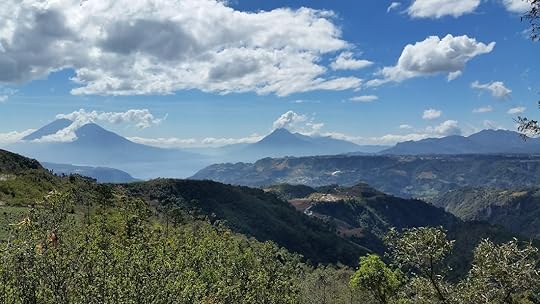 Three volcanoes surrounding Lake Atitlán in southern Guatemala. Guatemala: a land of fire and water, of jungle and mountains, of colorful textiles that match the colorful fruit and parrots decorating the trees. It's an ancient land still steeped in its traditions, and a place where sometimes it feels as if time has stopped.
Three volcanoes surrounding Lake Atitlán in southern Guatemala. Guatemala: a land of fire and water, of jungle and mountains, of colorful textiles that match the colorful fruit and parrots decorating the trees. It's an ancient land still steeped in its traditions, and a place where sometimes it feels as if time has stopped.
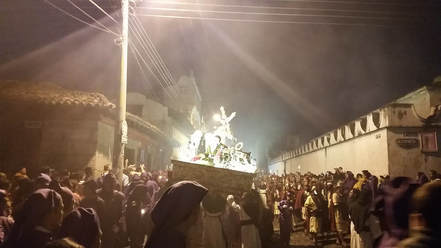 A religious parade in Antigua, Guatemala If I had to sum up Guatemala in one word, it would be indigenous. As much as 60% of the population of Guatemala are considered to be indigenous peoples, more than any other Central American country. Most of these communities still speak Pre-Columbian languages, they often wear traditional clothing, and many still perform some of their centuries-old religious practices, albeit under a Christian pretext.
A religious parade in Antigua, Guatemala If I had to sum up Guatemala in one word, it would be indigenous. As much as 60% of the population of Guatemala are considered to be indigenous peoples, more than any other Central American country. Most of these communities still speak Pre-Columbian languages, they often wear traditional clothing, and many still perform some of their centuries-old religious practices, albeit under a Christian pretext.
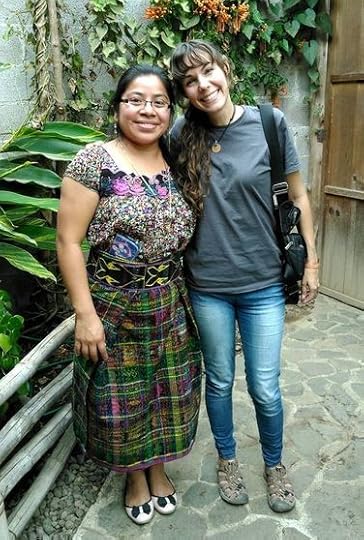 This is my Spanish teacher, Juanita, and I. Juanita is wearing her traditional Tz'utujil clothing which includes a corte (skirt), faja (belt), and güipil (blouse) while I am wearing my boring western clothes. During our two months in Guatemala, Tim and I were fortunate enough to encounter some of the 24 different ethnic groups such as the Q'eqchi in Central Guatemala, K'iche' in the Highlands, and Tz'utujil around Lake Atitlán.
This is my Spanish teacher, Juanita, and I. Juanita is wearing her traditional Tz'utujil clothing which includes a corte (skirt), faja (belt), and güipil (blouse) while I am wearing my boring western clothes. During our two months in Guatemala, Tim and I were fortunate enough to encounter some of the 24 different ethnic groups such as the Q'eqchi in Central Guatemala, K'iche' in the Highlands, and Tz'utujil around Lake Atitlán.
Many of these people are the direct descendants of the Maya, and it surprises me to think that I once believed the Mayans to be gone. It's true their cities were abandoned, many for unknown reasons, but in Guatemala you can actually come face to face with the modern-day Maya.
Though most of their 23 Amerindian languages are related, each community is distinct, and can be recognized by their style of clothing and weaving patterns. Many women can be seen wearing their colorful skirts and blouses, though most men wear western clothes. As the story goes, this is said to be because during the Spanish colonial years, a law had been put into place stating that people could not travel outside of their local districts. And since the men were the ones to usually travel, they wore Spanish clothes so they couldn't be recognized by their region of residence. I can't express how grateful I am to have had the chance to become immersed in some of these communities, and learn about their customs that reach back through the centuries. Tim and I even had our Mayan horoscopes read to us in Coban, which was a real treat. To no surprise, Tim has ALL thirteen energies associated with the Mayan calendar.
The following are a few other great reasons to visit Guatemala: Tikal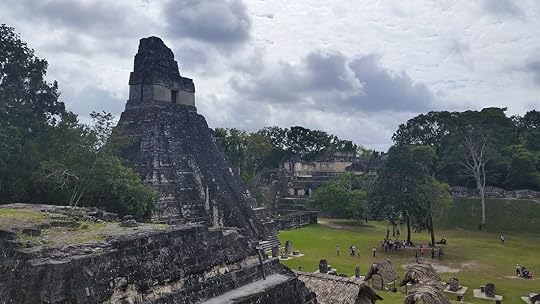 Temple I - The Great Jaguar Temple in the plaza of Tikal, Guatemala The lost city of Tikal was the capital of one of the most powerful kingdoms of the ancient Maya. At one point, Tikal's population may have been as high as 90,000, and it was a city of prominence between 200-900 AD.
Temple I - The Great Jaguar Temple in the plaza of Tikal, Guatemala The lost city of Tikal was the capital of one of the most powerful kingdoms of the ancient Maya. At one point, Tikal's population may have been as high as 90,000, and it was a city of prominence between 200-900 AD.
You can sense Tikal's grandeur the moment you step foot into its Great Plaza. Besides its numerous temples, the tallest of which is 230 ft. high (70 meters), Tikal has palaces, administrative buildings, ball courts, smaller groups of pyramids, residential areas, and what researchers believe to have been a jail. And that is only the excavated portion. New structures are continuously being found as more sites are unearthed. While we were visiting Tikal, some ground-breaking news shocked the world as a team of researchers using laser technology revealed that 60,000 or more Mayan structures still lie unexcavated under the dense forest surrounding Tikal. These include homes, palaces, tombs, even highways. Some historians are now comparing the ancient Mayan civilization to that of the ancient Greeks and Chinese. This is a huge breakthrough for the indigenous Mesoamerican people to finally show the historical importance and advancement of their ancestors.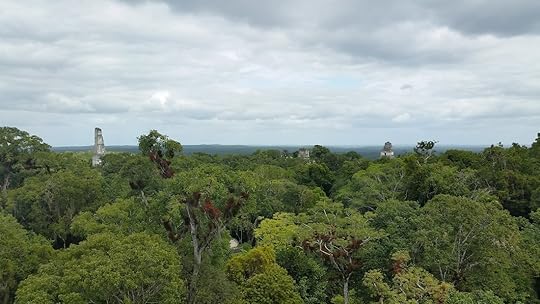 By the way, this is the same view used in Star Wars: The Return of the Jedi for the moon of Endor.
By the way, this is the same view used in Star Wars: The Return of the Jedi for the moon of Endor.
 All of Tikal's structures are limestone, which means that they are slowly being eroded away by the rain. If you would like to visit Tikal, keep in mind that despite being situated in the remote jungles of northern Guatemala, it's a major tourist attraction, and busloads of people arrive daily to visit it. So plan ahead, and give yourself enough time to enjoy it because to truly explore all of its treasures, you won't be able to see it all in one day.
All of Tikal's structures are limestone, which means that they are slowly being eroded away by the rain. If you would like to visit Tikal, keep in mind that despite being situated in the remote jungles of northern Guatemala, it's a major tourist attraction, and busloads of people arrive daily to visit it. So plan ahead, and give yourself enough time to enjoy it because to truly explore all of its treasures, you won't be able to see it all in one day.
We had the unique experience of camping just outside the main park's gates. The mosquitos came out at dusk, and were vicious little creatures, but then the fireflies came out like fairies dancing across the field in front of us. Once we settled down for the night, howler monkey began to chant their "special" calls. It was a soundbite straight out of any horror movie. We went to sleep scratching at fresh mosquito bites, and to a nightmarish lullaby of nature, it was amazing!
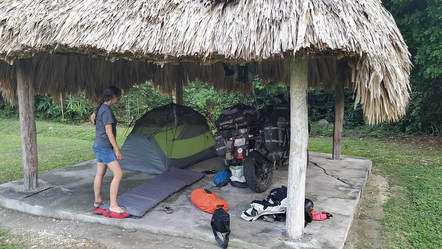 Our campsite at Tikal Park, Guatemala. Tikal is one of the last places in the world where hidden temples are still out there in the jungle just waiting to be found. So if you have a little Indiana Jones in you, then you should definitely come to Tikal. And if I had to pick my favorite out of all the Mayan ruins that we visited in Central America, Tikal would be it. The Jungle of the Peten
Our campsite at Tikal Park, Guatemala. Tikal is one of the last places in the world where hidden temples are still out there in the jungle just waiting to be found. So if you have a little Indiana Jones in you, then you should definitely come to Tikal. And if I had to pick my favorite out of all the Mayan ruins that we visited in Central America, Tikal would be it. The Jungle of the Peten
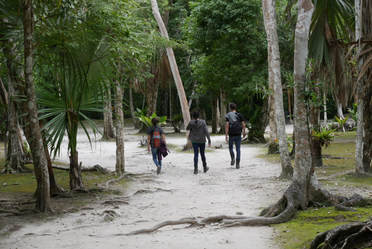 Marisa, Sapna, and Phil walking through Tikal, Guatemala Tikal is in the jungle of Guatemala's norther region called El Petén. It's remote, it's wild, and it's teeming with incredible animals such as spider monkeys, howler monkeys, scarlet macaws, toucans, anteaters, coatimundis (what's that you ask? check out the pictures above), and even jaguars, though you're sadly not likely to see one.
Marisa, Sapna, and Phil walking through Tikal, Guatemala Tikal is in the jungle of Guatemala's norther region called El Petén. It's remote, it's wild, and it's teeming with incredible animals such as spider monkeys, howler monkeys, scarlet macaws, toucans, anteaters, coatimundis (what's that you ask? check out the pictures above), and even jaguars, though you're sadly not likely to see one.
Tikal is at the heart of the Maya Biosphere Reserve, which represents the second-largest tract of forest on the American continent after the Amazon Rainforest in Brazil. This is truly the greatest piece of rainforest that North America has to offer, and it does not disappoint, as most people who visit Tikal see families of monkeys and many exotic birds.
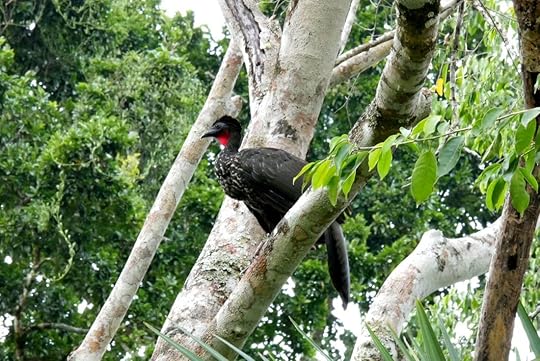 What is this? I don't know, but they were everywhere near the campground in Tikal.
What is this? I don't know, but they were everywhere near the campground in Tikal. 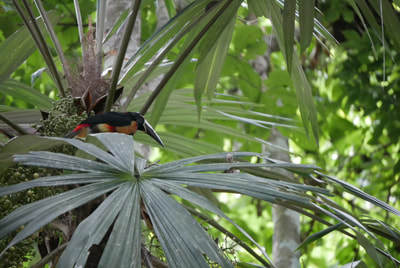 Fiery-Billed Toucan
Fiery-Billed Toucan 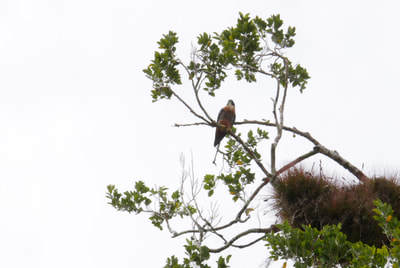 A very rare red hawk
A very rare red hawk 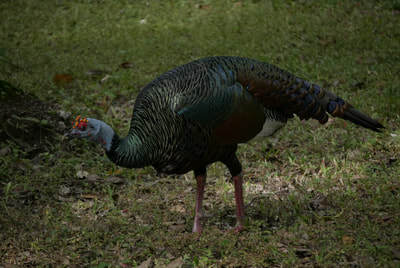 Ocellated Turkey Birds are what Guatemala is famous for. Guatemala's currency is actually named after a bird (the Quetzal), though it lives in the cooler cloud forests, not the Petén, and is extremely endangered. But green parrots, yellow-billed toucans, and scarlet macaws all call this place home, not to mention the most beautiful wild turkeys you will ever see. We even caught sight of a rare hawk, some herons, and a group of big birds in a tree we have no idea what they are.
Ocellated Turkey Birds are what Guatemala is famous for. Guatemala's currency is actually named after a bird (the Quetzal), though it lives in the cooler cloud forests, not the Petén, and is extremely endangered. But green parrots, yellow-billed toucans, and scarlet macaws all call this place home, not to mention the most beautiful wild turkeys you will ever see. We even caught sight of a rare hawk, some herons, and a group of big birds in a tree we have no idea what they are.
So if you like wildlife and are interested in coming face to face with some of the world's most exotic species, then come to the remote forests of the Petén. Caves and Waterfalls of Alta Verapaz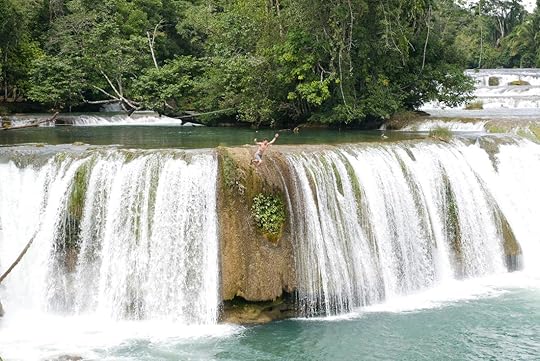 Tim jumping off Las Conchas waterfalls in Chahal, Alta Verapaz, Guatemala.
Tim jumping off Las Conchas waterfalls in Chahal, Alta Verapaz, Guatemala.
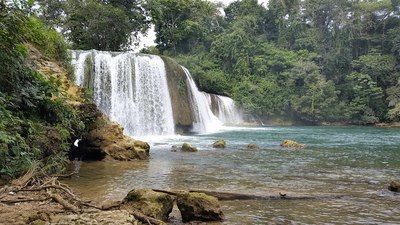
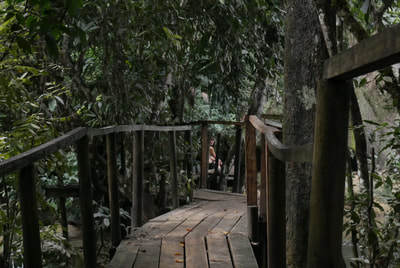
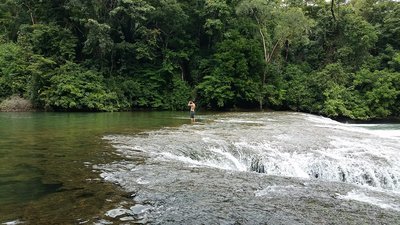 Most tourists who go to Guatemala will hear about a set of picturesque waterfalls in Alta Verapaz called Samuc Champey. Lots of people visit them, and that's wonderful, but we were advised to first check out a different set of waterfalls called Las Conchas. And it turned out to be so incredible and private, that we never felt the need to go to Samuc Champey afterwards.
Most tourists who go to Guatemala will hear about a set of picturesque waterfalls in Alta Verapaz called Samuc Champey. Lots of people visit them, and that's wonderful, but we were advised to first check out a different set of waterfalls called Las Conchas. And it turned out to be so incredible and private, that we never felt the need to go to Samuc Champey afterwards.
Unlike what we heard about Samuc Champey, which has a high amount of tourists visiting it every day, we were literally the only people at Las Conchas. It was our own private paradise. The largest of the waterfalls is about ten meters high (30 ft.) and you can jump off it! Tim, who was braver than I, did so a few times, as you can see in our video of Guatemala - The Green North. Tim wants me to insist that if you make fun of his bald spot in the video, he will unfriend you on Facebook. Las Conchas turned out to be such a secret gem that we urge you to visit it to feel the same sense of paradise that we did.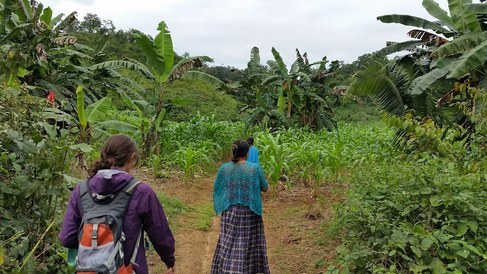 Me being led to the caves through forested farmlands by two Q'eqchi women. Near Las Conchas were the caves of Se'tzol, which were also recommended to us by a local, or else we would have never known about them, and certainly would have never found them. In fact, we had to be escorted to a farmer's private land. This involved us riding two up down a narrow path full of trenches and ruts with barbed wire fences on either side of us, a truly nerve-wrecking ride. We were then led by some women through their fields to a man who knew the cave system. And even though we didn't have enough time to do so, you can also go swimming and tubing in the caves! When we came out of the caves on the other side, we found ourselves surrounded by some local women and children who had come by horse to bathe in the river. Once again, we were the only tourists there.
Me being led to the caves through forested farmlands by two Q'eqchi women. Near Las Conchas were the caves of Se'tzol, which were also recommended to us by a local, or else we would have never known about them, and certainly would have never found them. In fact, we had to be escorted to a farmer's private land. This involved us riding two up down a narrow path full of trenches and ruts with barbed wire fences on either side of us, a truly nerve-wrecking ride. We were then led by some women through their fields to a man who knew the cave system. And even though we didn't have enough time to do so, you can also go swimming and tubing in the caves! When we came out of the caves on the other side, we found ourselves surrounded by some local women and children who had come by horse to bathe in the river. Once again, we were the only tourists there.
So if you want a truly authentic and personal experience in Guatemala, then come to Chahal in Alta Verapaz where you can visit these waterfalls and caves.
Lake Atitlan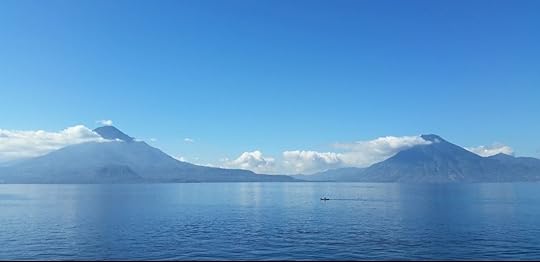 An incredible view from Panajachel at Lake Atitlán, Guatemala. We decided to stay at this gorgeous lake for an entire month, and it's not hard to see why. Surrounded by three volcanoes, Lake Atitlán is considered by many to be one of the most beautiful lakes in the world. There are also numerous villages on the lake's shores that are famous for their cultural festivals, colorful textiles, and other indigenous arts and crafts. All of these reasons also make Lake Atitlán an extremely touristy place, but in an earthy hippy type of way which can sometimes be a bit overboard. Some of the people looked like characters from the Fifth Element, who would happily read your future or rate your karma for the price of a couple cigarets, we avoided them as much as we could.
An incredible view from Panajachel at Lake Atitlán, Guatemala. We decided to stay at this gorgeous lake for an entire month, and it's not hard to see why. Surrounded by three volcanoes, Lake Atitlán is considered by many to be one of the most beautiful lakes in the world. There are also numerous villages on the lake's shores that are famous for their cultural festivals, colorful textiles, and other indigenous arts and crafts. All of these reasons also make Lake Atitlán an extremely touristy place, but in an earthy hippy type of way which can sometimes be a bit overboard. Some of the people looked like characters from the Fifth Element, who would happily read your future or rate your karma for the price of a couple cigarets, we avoided them as much as we could.
We actually made a bit of a snafu at the beginning of our visit to the lake. The problem was we booked our guesthouse room for a month in a town called San Pedro la Laguna, and then only afterwards we looked up the best route to our accommodations. The roads to San Pedro were not in the best shape, and have been known to be a common place for robberies. We learned that everyone usually gathers at Panajachel across the lake, then take small boats to all of the different towns surrounding the lake, including San Pedro.
So, the day before we were to arrive, it dawned on us that we were motorcycle travelers who were supposed to be staying someplace for a month that was fairly difficult to get to with a motorcycle. Great.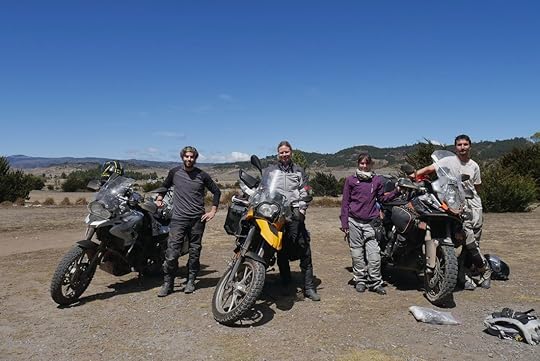 Greg on the right with his BMW 700, Jess in the middle with her BMW 650, and us on the right with our KTM Adventure.
Greg on the right with his BMW 700, Jess in the middle with her BMW 650, and us on the right with our KTM Adventure.
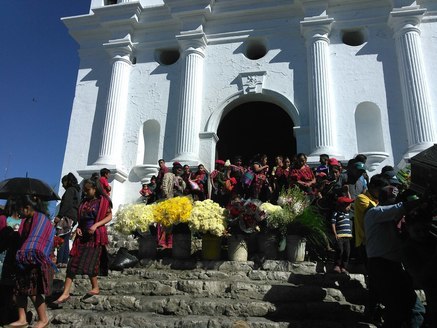 A traditional funeral we witnessed on our trip to Chichicastenango, Guatemala. And then we met Jess and Greg, fellow motorcycle travelers, who came to the rescue. This Canadian/American couple had been living in Panajachel off Lake Atitlán for the past year, and kindly offered to let us keep our bike at their place while we took the boat to San Pedro. It turned out that not only did they save us from our dumb predicament, but they quickly became great friends and fantastic local guides. We spent every weekend exploring the region on our bikes with them.
A traditional funeral we witnessed on our trip to Chichicastenango, Guatemala. And then we met Jess and Greg, fellow motorcycle travelers, who came to the rescue. This Canadian/American couple had been living in Panajachel off Lake Atitlán for the past year, and kindly offered to let us keep our bike at their place while we took the boat to San Pedro. It turned out that not only did they save us from our dumb predicament, but they quickly became great friends and fantastic local guides. We spent every weekend exploring the region on our bikes with them.
During the weekdays, both Tim and I enrolled in a Spanish course for a week, and planned on continuing if progress was made. But Tim spent several nights a week playing poker (with 20 Quetzales buy-ins, around $3 dollars, no great loss of money). And when he wasn't playing poker, he was petting one of the eight cats that lived in the courtyard. He actually got pretty good at poker by the end, and petting cats. If only he had dedicated as much time to his Spanish homework, he'd be fluent by now. Antigua There is always a view of Volcán de Agua in Antigua, Guatemala. Antigua is an old Spanish colonial city, and similar to Lake Atitlán, it's surrounded by three volcanoes. The closest is Volcán de Agua pictured above, but the most active is aptly named Volcán de Fuego (Volcano of Fire). At night, if you gaze at it, you can often see the faint fiery glow of lava running down from its peak. With its restored baroque charm and quaint gardened plazas, Antigua is gorgeous. It has a lively vibe and a close-nit community feel, but it is the epitome of touristy. You will hear more languages spoken from around the world in Antigua than Spanish, which is actually kind of cool that so many people from across the globe come there. Antigua is also a mecca for Spanish language learners, and has more Spanish language schools than I can count.
There is always a view of Volcán de Agua in Antigua, Guatemala. Antigua is an old Spanish colonial city, and similar to Lake Atitlán, it's surrounded by three volcanoes. The closest is Volcán de Agua pictured above, but the most active is aptly named Volcán de Fuego (Volcano of Fire). At night, if you gaze at it, you can often see the faint fiery glow of lava running down from its peak. With its restored baroque charm and quaint gardened plazas, Antigua is gorgeous. It has a lively vibe and a close-nit community feel, but it is the epitome of touristy. You will hear more languages spoken from around the world in Antigua than Spanish, which is actually kind of cool that so many people from across the globe come there. Antigua is also a mecca for Spanish language learners, and has more Spanish language schools than I can count.
So if you come to visit Antigua, as nearly all tourists in Guatemala do, bring your camera and your wallet, and then just keep in mind that you won't be the only foreigner there, ha! Things I didn't like about Guatemala Even though we had such a wonderful time in Guatemala, no place is perfect. The following is a list of my not-so-favorite aspects about the country: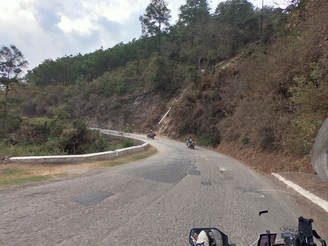 Road Conditions
- I don't just mean all the potholes and speed bumps (which are called túmulos in Guatemala). And I don't just mean that the pavement comes to an abrupt end out of nowhere and turns into gravel, or worse, sand. I mean like the time we suddenly found that we were in the middle of a giant corn field. Or the other time we wanted to go south on the secondary road to the main highway, and that turned into a cliffside mud pit, forcing us to turn around. Basically, if you want to actually get somewhere in Guatemala without going through some enduro off-road adventure, then you have no other choice than to take the singular main highway, which is full of potholes and speed bumps, but that's better than the alternative.
Diesel Trucks
- As far as I could tell, there are no roads outside of Guatemala City that have more than one lane for each side of traffic. So when you get stuck behind a truck, and you're on some mountainous hairpin curvy road (which is most of Guatemala), then you're going to be stuck behind him for quite some time. And the fumes you'll be breathing will take years off your life. We have actually debated purchasing some sort of gas mask to prevent fainting while being behind these polluting monstrosities.
Road Conditions
- I don't just mean all the potholes and speed bumps (which are called túmulos in Guatemala). And I don't just mean that the pavement comes to an abrupt end out of nowhere and turns into gravel, or worse, sand. I mean like the time we suddenly found that we were in the middle of a giant corn field. Or the other time we wanted to go south on the secondary road to the main highway, and that turned into a cliffside mud pit, forcing us to turn around. Basically, if you want to actually get somewhere in Guatemala without going through some enduro off-road adventure, then you have no other choice than to take the singular main highway, which is full of potholes and speed bumps, but that's better than the alternative.
Diesel Trucks
- As far as I could tell, there are no roads outside of Guatemala City that have more than one lane for each side of traffic. So when you get stuck behind a truck, and you're on some mountainous hairpin curvy road (which is most of Guatemala), then you're going to be stuck behind him for quite some time. And the fumes you'll be breathing will take years off your life. We have actually debated purchasing some sort of gas mask to prevent fainting while being behind these polluting monstrosities.  It's pretty, but getting there is the hard part.
It's pretty, but getting there is the hard part. 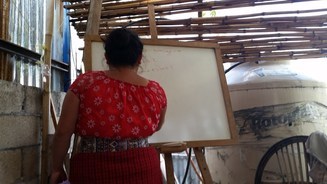 Spanish Schools
- But wait, everybody knows that Guatemala is famous for its wonderful and affordable Spanish schools! Yes, but that's precisely the problem. Antigua and Lake Atitlán have become such havens for travelers wishing to take some Spanish classes, that they have employed nearly the entire local populations to teach Spanish. So not only are these people not qualified to teach, but many have not even finished high school. Plus, at least at Lake Atitlán, Spanish is probably not their first language! My Spanish teacher was decent, but Tim's was just awful. She was teaching him completely incorrect verb conjugations and was clearly illiterate in Spanish. So if you want to learn Spanish in Guatemala, pay the extra price for a real teacher, and look into the company's certification policies.
Drugs
- I don't think we necessarily fit the exact description of someone desperately in search of drugs, but none-the-less, we were solicited for cocaine, pot, and ecstasy at nearly every turn. Giving our surroundings at some of the locations, I'm sure that business was good, but the constant request to push coke on Tim got a little annoying and uncomfortable when politely refusing dealers.
Spanish Schools
- But wait, everybody knows that Guatemala is famous for its wonderful and affordable Spanish schools! Yes, but that's precisely the problem. Antigua and Lake Atitlán have become such havens for travelers wishing to take some Spanish classes, that they have employed nearly the entire local populations to teach Spanish. So not only are these people not qualified to teach, but many have not even finished high school. Plus, at least at Lake Atitlán, Spanish is probably not their first language! My Spanish teacher was decent, but Tim's was just awful. She was teaching him completely incorrect verb conjugations and was clearly illiterate in Spanish. So if you want to learn Spanish in Guatemala, pay the extra price for a real teacher, and look into the company's certification policies.
Drugs
- I don't think we necessarily fit the exact description of someone desperately in search of drugs, but none-the-less, we were solicited for cocaine, pot, and ecstasy at nearly every turn. Giving our surroundings at some of the locations, I'm sure that business was good, but the constant request to push coke on Tim got a little annoying and uncomfortable when politely refusing dealers.  Can you see the fires burning in the distance? Check out our video Guatemala - The Volcanic South for our up-close encounter.
Can you see the fires burning in the distance? Check out our video Guatemala - The Volcanic South for our up-close encounter.
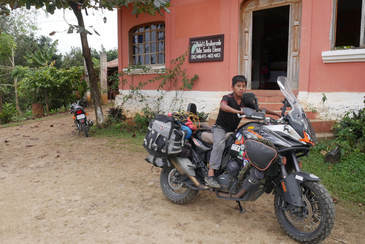 A local boy of Chahal dreaming big on our bike.
Poverty
- Guatemala is very poor, and this can become an inconvenience for the traveler who is harassed by vendors and beggars. But more importantly, this is a real problem for the people of this gorgeous country who are trying to find their footing in the modern world economy. And yet, because of their close family ties and positive outlooks, Guatemalans are a joyful people who are always laughing and finding peace and comfort through the company of one another. And this, more than anything, gives me hope for this remarkable nation.
A local boy of Chahal dreaming big on our bike.
Poverty
- Guatemala is very poor, and this can become an inconvenience for the traveler who is harassed by vendors and beggars. But more importantly, this is a real problem for the people of this gorgeous country who are trying to find their footing in the modern world economy. And yet, because of their close family ties and positive outlooks, Guatemalans are a joyful people who are always laughing and finding peace and comfort through the company of one another. And this, more than anything, gives me hope for this remarkable nation.
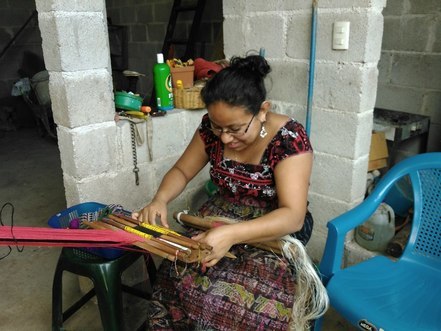 A local Tz'utujil woman making a faja, or belt, in San Pedro la Laguna, Gautemala.
Discrimination
- More precisely, I mean discrimination against the indigenous people. We did not directly see any conflicts, but heard enough stories to know it's prevalent and a major issue. Even my Spanish teacher said she didn't feel comfortable wearing her traditional dress when traveling to Guatemala City. For a country that is so rich in its indigenous culture and roots, it's sad to see its own citizens prejudiced against what I believe to be one of Guatemala's greatest treasures. In fact, the indigenous cultures are the very reason why many foreigners come to Guatemala in the first place, and are what sets the country apart from its neighbors.
A local Tz'utujil woman making a faja, or belt, in San Pedro la Laguna, Gautemala.
Discrimination
- More precisely, I mean discrimination against the indigenous people. We did not directly see any conflicts, but heard enough stories to know it's prevalent and a major issue. Even my Spanish teacher said she didn't feel comfortable wearing her traditional dress when traveling to Guatemala City. For a country that is so rich in its indigenous culture and roots, it's sad to see its own citizens prejudiced against what I believe to be one of Guatemala's greatest treasures. In fact, the indigenous cultures are the very reason why many foreigners come to Guatemala in the first place, and are what sets the country apart from its neighbors. 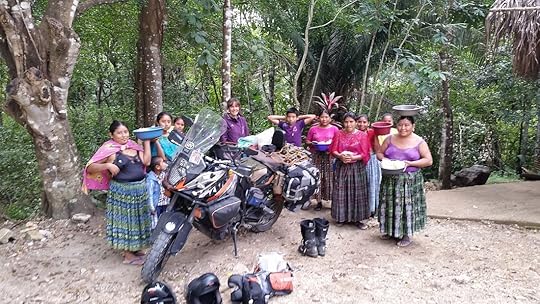 The local women and children around Las Conchas waterfalls selling cut fruits and homemade chocolate. This has been a long blog, but there are so many incredible experiences to be had in Guatemala, I felt the need to share my thoughts. Its incredible people, its long history, and its indigenous cultures all make this country stand alone amongst the Central American nations. And like the gorgeous textiles that it's known for, Guatemala weaves together the individual backgrounds of all its people into colorful patterns that reflect the natural beauty of their surroundings.
The local women and children around Las Conchas waterfalls selling cut fruits and homemade chocolate. This has been a long blog, but there are so many incredible experiences to be had in Guatemala, I felt the need to share my thoughts. Its incredible people, its long history, and its indigenous cultures all make this country stand alone amongst the Central American nations. And like the gorgeous textiles that it's known for, Guatemala weaves together the individual backgrounds of all its people into colorful patterns that reflect the natural beauty of their surroundings.
I hope I have inspired someone to consider visiting Guatemala, because I know if you do, it will hold a special place in your heart as it does in mine.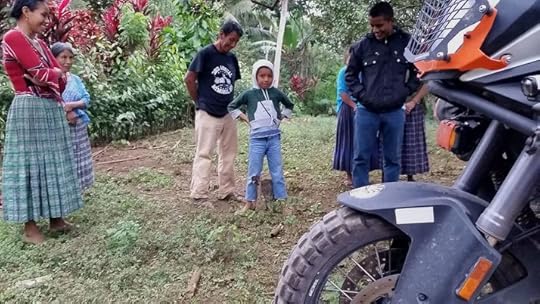 A local Q'eqchi family of Chahal, Alta Verapaz, Guatemala.
A local Q'eqchi family of Chahal, Alta Verapaz, Guatemala.
 Three volcanoes surrounding Lake Atitlán in southern Guatemala. Guatemala: a land of fire and water, of jungle and mountains, of colorful textiles that match the colorful fruit and parrots decorating the trees. It's an ancient land still steeped in its traditions, and a place where sometimes it feels as if time has stopped.
Three volcanoes surrounding Lake Atitlán in southern Guatemala. Guatemala: a land of fire and water, of jungle and mountains, of colorful textiles that match the colorful fruit and parrots decorating the trees. It's an ancient land still steeped in its traditions, and a place where sometimes it feels as if time has stopped.
 A religious parade in Antigua, Guatemala If I had to sum up Guatemala in one word, it would be indigenous. As much as 60% of the population of Guatemala are considered to be indigenous peoples, more than any other Central American country. Most of these communities still speak Pre-Columbian languages, they often wear traditional clothing, and many still perform some of their centuries-old religious practices, albeit under a Christian pretext.
A religious parade in Antigua, Guatemala If I had to sum up Guatemala in one word, it would be indigenous. As much as 60% of the population of Guatemala are considered to be indigenous peoples, more than any other Central American country. Most of these communities still speak Pre-Columbian languages, they often wear traditional clothing, and many still perform some of their centuries-old religious practices, albeit under a Christian pretext.
 This is my Spanish teacher, Juanita, and I. Juanita is wearing her traditional Tz'utujil clothing which includes a corte (skirt), faja (belt), and güipil (blouse) while I am wearing my boring western clothes. During our two months in Guatemala, Tim and I were fortunate enough to encounter some of the 24 different ethnic groups such as the Q'eqchi in Central Guatemala, K'iche' in the Highlands, and Tz'utujil around Lake Atitlán.
This is my Spanish teacher, Juanita, and I. Juanita is wearing her traditional Tz'utujil clothing which includes a corte (skirt), faja (belt), and güipil (blouse) while I am wearing my boring western clothes. During our two months in Guatemala, Tim and I were fortunate enough to encounter some of the 24 different ethnic groups such as the Q'eqchi in Central Guatemala, K'iche' in the Highlands, and Tz'utujil around Lake Atitlán.Many of these people are the direct descendants of the Maya, and it surprises me to think that I once believed the Mayans to be gone. It's true their cities were abandoned, many for unknown reasons, but in Guatemala you can actually come face to face with the modern-day Maya.
Though most of their 23 Amerindian languages are related, each community is distinct, and can be recognized by their style of clothing and weaving patterns. Many women can be seen wearing their colorful skirts and blouses, though most men wear western clothes. As the story goes, this is said to be because during the Spanish colonial years, a law had been put into place stating that people could not travel outside of their local districts. And since the men were the ones to usually travel, they wore Spanish clothes so they couldn't be recognized by their region of residence. I can't express how grateful I am to have had the chance to become immersed in some of these communities, and learn about their customs that reach back through the centuries. Tim and I even had our Mayan horoscopes read to us in Coban, which was a real treat. To no surprise, Tim has ALL thirteen energies associated with the Mayan calendar.
The following are a few other great reasons to visit Guatemala: Tikal
 Temple I - The Great Jaguar Temple in the plaza of Tikal, Guatemala The lost city of Tikal was the capital of one of the most powerful kingdoms of the ancient Maya. At one point, Tikal's population may have been as high as 90,000, and it was a city of prominence between 200-900 AD.
Temple I - The Great Jaguar Temple in the plaza of Tikal, Guatemala The lost city of Tikal was the capital of one of the most powerful kingdoms of the ancient Maya. At one point, Tikal's population may have been as high as 90,000, and it was a city of prominence between 200-900 AD. You can sense Tikal's grandeur the moment you step foot into its Great Plaza. Besides its numerous temples, the tallest of which is 230 ft. high (70 meters), Tikal has palaces, administrative buildings, ball courts, smaller groups of pyramids, residential areas, and what researchers believe to have been a jail. And that is only the excavated portion. New structures are continuously being found as more sites are unearthed. While we were visiting Tikal, some ground-breaking news shocked the world as a team of researchers using laser technology revealed that 60,000 or more Mayan structures still lie unexcavated under the dense forest surrounding Tikal. These include homes, palaces, tombs, even highways. Some historians are now comparing the ancient Mayan civilization to that of the ancient Greeks and Chinese. This is a huge breakthrough for the indigenous Mesoamerican people to finally show the historical importance and advancement of their ancestors.
 By the way, this is the same view used in Star Wars: The Return of the Jedi for the moon of Endor.
By the way, this is the same view used in Star Wars: The Return of the Jedi for the moon of Endor.
 All of Tikal's structures are limestone, which means that they are slowly being eroded away by the rain. If you would like to visit Tikal, keep in mind that despite being situated in the remote jungles of northern Guatemala, it's a major tourist attraction, and busloads of people arrive daily to visit it. So plan ahead, and give yourself enough time to enjoy it because to truly explore all of its treasures, you won't be able to see it all in one day.
All of Tikal's structures are limestone, which means that they are slowly being eroded away by the rain. If you would like to visit Tikal, keep in mind that despite being situated in the remote jungles of northern Guatemala, it's a major tourist attraction, and busloads of people arrive daily to visit it. So plan ahead, and give yourself enough time to enjoy it because to truly explore all of its treasures, you won't be able to see it all in one day.We had the unique experience of camping just outside the main park's gates. The mosquitos came out at dusk, and were vicious little creatures, but then the fireflies came out like fairies dancing across the field in front of us. Once we settled down for the night, howler monkey began to chant their "special" calls. It was a soundbite straight out of any horror movie. We went to sleep scratching at fresh mosquito bites, and to a nightmarish lullaby of nature, it was amazing!
 Our campsite at Tikal Park, Guatemala. Tikal is one of the last places in the world where hidden temples are still out there in the jungle just waiting to be found. So if you have a little Indiana Jones in you, then you should definitely come to Tikal. And if I had to pick my favorite out of all the Mayan ruins that we visited in Central America, Tikal would be it. The Jungle of the Peten
Our campsite at Tikal Park, Guatemala. Tikal is one of the last places in the world where hidden temples are still out there in the jungle just waiting to be found. So if you have a little Indiana Jones in you, then you should definitely come to Tikal. And if I had to pick my favorite out of all the Mayan ruins that we visited in Central America, Tikal would be it. The Jungle of the Peten
 Marisa, Sapna, and Phil walking through Tikal, Guatemala Tikal is in the jungle of Guatemala's norther region called El Petén. It's remote, it's wild, and it's teeming with incredible animals such as spider monkeys, howler monkeys, scarlet macaws, toucans, anteaters, coatimundis (what's that you ask? check out the pictures above), and even jaguars, though you're sadly not likely to see one.
Marisa, Sapna, and Phil walking through Tikal, Guatemala Tikal is in the jungle of Guatemala's norther region called El Petén. It's remote, it's wild, and it's teeming with incredible animals such as spider monkeys, howler monkeys, scarlet macaws, toucans, anteaters, coatimundis (what's that you ask? check out the pictures above), and even jaguars, though you're sadly not likely to see one. Tikal is at the heart of the Maya Biosphere Reserve, which represents the second-largest tract of forest on the American continent after the Amazon Rainforest in Brazil. This is truly the greatest piece of rainforest that North America has to offer, and it does not disappoint, as most people who visit Tikal see families of monkeys and many exotic birds.
 What is this? I don't know, but they were everywhere near the campground in Tikal.
What is this? I don't know, but they were everywhere near the campground in Tikal.  Fiery-Billed Toucan
Fiery-Billed Toucan  A very rare red hawk
A very rare red hawk  Ocellated Turkey Birds are what Guatemala is famous for. Guatemala's currency is actually named after a bird (the Quetzal), though it lives in the cooler cloud forests, not the Petén, and is extremely endangered. But green parrots, yellow-billed toucans, and scarlet macaws all call this place home, not to mention the most beautiful wild turkeys you will ever see. We even caught sight of a rare hawk, some herons, and a group of big birds in a tree we have no idea what they are.
Ocellated Turkey Birds are what Guatemala is famous for. Guatemala's currency is actually named after a bird (the Quetzal), though it lives in the cooler cloud forests, not the Petén, and is extremely endangered. But green parrots, yellow-billed toucans, and scarlet macaws all call this place home, not to mention the most beautiful wild turkeys you will ever see. We even caught sight of a rare hawk, some herons, and a group of big birds in a tree we have no idea what they are.So if you like wildlife and are interested in coming face to face with some of the world's most exotic species, then come to the remote forests of the Petén. Caves and Waterfalls of Alta Verapaz
 Tim jumping off Las Conchas waterfalls in Chahal, Alta Verapaz, Guatemala.
Tim jumping off Las Conchas waterfalls in Chahal, Alta Verapaz, Guatemala.


 Most tourists who go to Guatemala will hear about a set of picturesque waterfalls in Alta Verapaz called Samuc Champey. Lots of people visit them, and that's wonderful, but we were advised to first check out a different set of waterfalls called Las Conchas. And it turned out to be so incredible and private, that we never felt the need to go to Samuc Champey afterwards.
Most tourists who go to Guatemala will hear about a set of picturesque waterfalls in Alta Verapaz called Samuc Champey. Lots of people visit them, and that's wonderful, but we were advised to first check out a different set of waterfalls called Las Conchas. And it turned out to be so incredible and private, that we never felt the need to go to Samuc Champey afterwards. Unlike what we heard about Samuc Champey, which has a high amount of tourists visiting it every day, we were literally the only people at Las Conchas. It was our own private paradise. The largest of the waterfalls is about ten meters high (30 ft.) and you can jump off it! Tim, who was braver than I, did so a few times, as you can see in our video of Guatemala - The Green North. Tim wants me to insist that if you make fun of his bald spot in the video, he will unfriend you on Facebook. Las Conchas turned out to be such a secret gem that we urge you to visit it to feel the same sense of paradise that we did.
 Me being led to the caves through forested farmlands by two Q'eqchi women. Near Las Conchas were the caves of Se'tzol, which were also recommended to us by a local, or else we would have never known about them, and certainly would have never found them. In fact, we had to be escorted to a farmer's private land. This involved us riding two up down a narrow path full of trenches and ruts with barbed wire fences on either side of us, a truly nerve-wrecking ride. We were then led by some women through their fields to a man who knew the cave system. And even though we didn't have enough time to do so, you can also go swimming and tubing in the caves! When we came out of the caves on the other side, we found ourselves surrounded by some local women and children who had come by horse to bathe in the river. Once again, we were the only tourists there.
Me being led to the caves through forested farmlands by two Q'eqchi women. Near Las Conchas were the caves of Se'tzol, which were also recommended to us by a local, or else we would have never known about them, and certainly would have never found them. In fact, we had to be escorted to a farmer's private land. This involved us riding two up down a narrow path full of trenches and ruts with barbed wire fences on either side of us, a truly nerve-wrecking ride. We were then led by some women through their fields to a man who knew the cave system. And even though we didn't have enough time to do so, you can also go swimming and tubing in the caves! When we came out of the caves on the other side, we found ourselves surrounded by some local women and children who had come by horse to bathe in the river. Once again, we were the only tourists there.So if you want a truly authentic and personal experience in Guatemala, then come to Chahal in Alta Verapaz where you can visit these waterfalls and caves.
Lake Atitlan
 An incredible view from Panajachel at Lake Atitlán, Guatemala. We decided to stay at this gorgeous lake for an entire month, and it's not hard to see why. Surrounded by three volcanoes, Lake Atitlán is considered by many to be one of the most beautiful lakes in the world. There are also numerous villages on the lake's shores that are famous for their cultural festivals, colorful textiles, and other indigenous arts and crafts. All of these reasons also make Lake Atitlán an extremely touristy place, but in an earthy hippy type of way which can sometimes be a bit overboard. Some of the people looked like characters from the Fifth Element, who would happily read your future or rate your karma for the price of a couple cigarets, we avoided them as much as we could.
An incredible view from Panajachel at Lake Atitlán, Guatemala. We decided to stay at this gorgeous lake for an entire month, and it's not hard to see why. Surrounded by three volcanoes, Lake Atitlán is considered by many to be one of the most beautiful lakes in the world. There are also numerous villages on the lake's shores that are famous for their cultural festivals, colorful textiles, and other indigenous arts and crafts. All of these reasons also make Lake Atitlán an extremely touristy place, but in an earthy hippy type of way which can sometimes be a bit overboard. Some of the people looked like characters from the Fifth Element, who would happily read your future or rate your karma for the price of a couple cigarets, we avoided them as much as we could.We actually made a bit of a snafu at the beginning of our visit to the lake. The problem was we booked our guesthouse room for a month in a town called San Pedro la Laguna, and then only afterwards we looked up the best route to our accommodations. The roads to San Pedro were not in the best shape, and have been known to be a common place for robberies. We learned that everyone usually gathers at Panajachel across the lake, then take small boats to all of the different towns surrounding the lake, including San Pedro.
So, the day before we were to arrive, it dawned on us that we were motorcycle travelers who were supposed to be staying someplace for a month that was fairly difficult to get to with a motorcycle. Great.
 Greg on the right with his BMW 700, Jess in the middle with her BMW 650, and us on the right with our KTM Adventure.
Greg on the right with his BMW 700, Jess in the middle with her BMW 650, and us on the right with our KTM Adventure.
 A traditional funeral we witnessed on our trip to Chichicastenango, Guatemala. And then we met Jess and Greg, fellow motorcycle travelers, who came to the rescue. This Canadian/American couple had been living in Panajachel off Lake Atitlán for the past year, and kindly offered to let us keep our bike at their place while we took the boat to San Pedro. It turned out that not only did they save us from our dumb predicament, but they quickly became great friends and fantastic local guides. We spent every weekend exploring the region on our bikes with them.
A traditional funeral we witnessed on our trip to Chichicastenango, Guatemala. And then we met Jess and Greg, fellow motorcycle travelers, who came to the rescue. This Canadian/American couple had been living in Panajachel off Lake Atitlán for the past year, and kindly offered to let us keep our bike at their place while we took the boat to San Pedro. It turned out that not only did they save us from our dumb predicament, but they quickly became great friends and fantastic local guides. We spent every weekend exploring the region on our bikes with them.During the weekdays, both Tim and I enrolled in a Spanish course for a week, and planned on continuing if progress was made. But Tim spent several nights a week playing poker (with 20 Quetzales buy-ins, around $3 dollars, no great loss of money). And when he wasn't playing poker, he was petting one of the eight cats that lived in the courtyard. He actually got pretty good at poker by the end, and petting cats. If only he had dedicated as much time to his Spanish homework, he'd be fluent by now. Antigua
 There is always a view of Volcán de Agua in Antigua, Guatemala. Antigua is an old Spanish colonial city, and similar to Lake Atitlán, it's surrounded by three volcanoes. The closest is Volcán de Agua pictured above, but the most active is aptly named Volcán de Fuego (Volcano of Fire). At night, if you gaze at it, you can often see the faint fiery glow of lava running down from its peak. With its restored baroque charm and quaint gardened plazas, Antigua is gorgeous. It has a lively vibe and a close-nit community feel, but it is the epitome of touristy. You will hear more languages spoken from around the world in Antigua than Spanish, which is actually kind of cool that so many people from across the globe come there. Antigua is also a mecca for Spanish language learners, and has more Spanish language schools than I can count.
There is always a view of Volcán de Agua in Antigua, Guatemala. Antigua is an old Spanish colonial city, and similar to Lake Atitlán, it's surrounded by three volcanoes. The closest is Volcán de Agua pictured above, but the most active is aptly named Volcán de Fuego (Volcano of Fire). At night, if you gaze at it, you can often see the faint fiery glow of lava running down from its peak. With its restored baroque charm and quaint gardened plazas, Antigua is gorgeous. It has a lively vibe and a close-nit community feel, but it is the epitome of touristy. You will hear more languages spoken from around the world in Antigua than Spanish, which is actually kind of cool that so many people from across the globe come there. Antigua is also a mecca for Spanish language learners, and has more Spanish language schools than I can count.So if you come to visit Antigua, as nearly all tourists in Guatemala do, bring your camera and your wallet, and then just keep in mind that you won't be the only foreigner there, ha! Things I didn't like about Guatemala Even though we had such a wonderful time in Guatemala, no place is perfect. The following is a list of my not-so-favorite aspects about the country:
 Road Conditions
- I don't just mean all the potholes and speed bumps (which are called túmulos in Guatemala). And I don't just mean that the pavement comes to an abrupt end out of nowhere and turns into gravel, or worse, sand. I mean like the time we suddenly found that we were in the middle of a giant corn field. Or the other time we wanted to go south on the secondary road to the main highway, and that turned into a cliffside mud pit, forcing us to turn around. Basically, if you want to actually get somewhere in Guatemala without going through some enduro off-road adventure, then you have no other choice than to take the singular main highway, which is full of potholes and speed bumps, but that's better than the alternative.
Diesel Trucks
- As far as I could tell, there are no roads outside of Guatemala City that have more than one lane for each side of traffic. So when you get stuck behind a truck, and you're on some mountainous hairpin curvy road (which is most of Guatemala), then you're going to be stuck behind him for quite some time. And the fumes you'll be breathing will take years off your life. We have actually debated purchasing some sort of gas mask to prevent fainting while being behind these polluting monstrosities.
Road Conditions
- I don't just mean all the potholes and speed bumps (which are called túmulos in Guatemala). And I don't just mean that the pavement comes to an abrupt end out of nowhere and turns into gravel, or worse, sand. I mean like the time we suddenly found that we were in the middle of a giant corn field. Or the other time we wanted to go south on the secondary road to the main highway, and that turned into a cliffside mud pit, forcing us to turn around. Basically, if you want to actually get somewhere in Guatemala without going through some enduro off-road adventure, then you have no other choice than to take the singular main highway, which is full of potholes and speed bumps, but that's better than the alternative.
Diesel Trucks
- As far as I could tell, there are no roads outside of Guatemala City that have more than one lane for each side of traffic. So when you get stuck behind a truck, and you're on some mountainous hairpin curvy road (which is most of Guatemala), then you're going to be stuck behind him for quite some time. And the fumes you'll be breathing will take years off your life. We have actually debated purchasing some sort of gas mask to prevent fainting while being behind these polluting monstrosities.  It's pretty, but getting there is the hard part.
It's pretty, but getting there is the hard part.  Spanish Schools
- But wait, everybody knows that Guatemala is famous for its wonderful and affordable Spanish schools! Yes, but that's precisely the problem. Antigua and Lake Atitlán have become such havens for travelers wishing to take some Spanish classes, that they have employed nearly the entire local populations to teach Spanish. So not only are these people not qualified to teach, but many have not even finished high school. Plus, at least at Lake Atitlán, Spanish is probably not their first language! My Spanish teacher was decent, but Tim's was just awful. She was teaching him completely incorrect verb conjugations and was clearly illiterate in Spanish. So if you want to learn Spanish in Guatemala, pay the extra price for a real teacher, and look into the company's certification policies.
Drugs
- I don't think we necessarily fit the exact description of someone desperately in search of drugs, but none-the-less, we were solicited for cocaine, pot, and ecstasy at nearly every turn. Giving our surroundings at some of the locations, I'm sure that business was good, but the constant request to push coke on Tim got a little annoying and uncomfortable when politely refusing dealers.
Spanish Schools
- But wait, everybody knows that Guatemala is famous for its wonderful and affordable Spanish schools! Yes, but that's precisely the problem. Antigua and Lake Atitlán have become such havens for travelers wishing to take some Spanish classes, that they have employed nearly the entire local populations to teach Spanish. So not only are these people not qualified to teach, but many have not even finished high school. Plus, at least at Lake Atitlán, Spanish is probably not their first language! My Spanish teacher was decent, but Tim's was just awful. She was teaching him completely incorrect verb conjugations and was clearly illiterate in Spanish. So if you want to learn Spanish in Guatemala, pay the extra price for a real teacher, and look into the company's certification policies.
Drugs
- I don't think we necessarily fit the exact description of someone desperately in search of drugs, but none-the-less, we were solicited for cocaine, pot, and ecstasy at nearly every turn. Giving our surroundings at some of the locations, I'm sure that business was good, but the constant request to push coke on Tim got a little annoying and uncomfortable when politely refusing dealers.  Can you see the fires burning in the distance? Check out our video Guatemala - The Volcanic South for our up-close encounter.
Can you see the fires burning in the distance? Check out our video Guatemala - The Volcanic South for our up-close encounter.
 A local boy of Chahal dreaming big on our bike.
Poverty
- Guatemala is very poor, and this can become an inconvenience for the traveler who is harassed by vendors and beggars. But more importantly, this is a real problem for the people of this gorgeous country who are trying to find their footing in the modern world economy. And yet, because of their close family ties and positive outlooks, Guatemalans are a joyful people who are always laughing and finding peace and comfort through the company of one another. And this, more than anything, gives me hope for this remarkable nation.
A local boy of Chahal dreaming big on our bike.
Poverty
- Guatemala is very poor, and this can become an inconvenience for the traveler who is harassed by vendors and beggars. But more importantly, this is a real problem for the people of this gorgeous country who are trying to find their footing in the modern world economy. And yet, because of their close family ties and positive outlooks, Guatemalans are a joyful people who are always laughing and finding peace and comfort through the company of one another. And this, more than anything, gives me hope for this remarkable nation.
 A local Tz'utujil woman making a faja, or belt, in San Pedro la Laguna, Gautemala.
Discrimination
- More precisely, I mean discrimination against the indigenous people. We did not directly see any conflicts, but heard enough stories to know it's prevalent and a major issue. Even my Spanish teacher said she didn't feel comfortable wearing her traditional dress when traveling to Guatemala City. For a country that is so rich in its indigenous culture and roots, it's sad to see its own citizens prejudiced against what I believe to be one of Guatemala's greatest treasures. In fact, the indigenous cultures are the very reason why many foreigners come to Guatemala in the first place, and are what sets the country apart from its neighbors.
A local Tz'utujil woman making a faja, or belt, in San Pedro la Laguna, Gautemala.
Discrimination
- More precisely, I mean discrimination against the indigenous people. We did not directly see any conflicts, but heard enough stories to know it's prevalent and a major issue. Even my Spanish teacher said she didn't feel comfortable wearing her traditional dress when traveling to Guatemala City. For a country that is so rich in its indigenous culture and roots, it's sad to see its own citizens prejudiced against what I believe to be one of Guatemala's greatest treasures. In fact, the indigenous cultures are the very reason why many foreigners come to Guatemala in the first place, and are what sets the country apart from its neighbors.  The local women and children around Las Conchas waterfalls selling cut fruits and homemade chocolate. This has been a long blog, but there are so many incredible experiences to be had in Guatemala, I felt the need to share my thoughts. Its incredible people, its long history, and its indigenous cultures all make this country stand alone amongst the Central American nations. And like the gorgeous textiles that it's known for, Guatemala weaves together the individual backgrounds of all its people into colorful patterns that reflect the natural beauty of their surroundings.
The local women and children around Las Conchas waterfalls selling cut fruits and homemade chocolate. This has been a long blog, but there are so many incredible experiences to be had in Guatemala, I felt the need to share my thoughts. Its incredible people, its long history, and its indigenous cultures all make this country stand alone amongst the Central American nations. And like the gorgeous textiles that it's known for, Guatemala weaves together the individual backgrounds of all its people into colorful patterns that reflect the natural beauty of their surroundings. I hope I have inspired someone to consider visiting Guatemala, because I know if you do, it will hold a special place in your heart as it does in mine.
 A local Q'eqchi family of Chahal, Alta Verapaz, Guatemala.
A local Q'eqchi family of Chahal, Alta Verapaz, Guatemala.
Published on March 23, 2018 06:37
February 21, 2018
Beautiful Belize
By Marisa Having previously never thought too much about this tiny Central American country, I didn't quite know what to expect when I entered Belize. But as it turns out, Belize felt completely different from Mexico and its neighbors, and it surprised me in many ways.
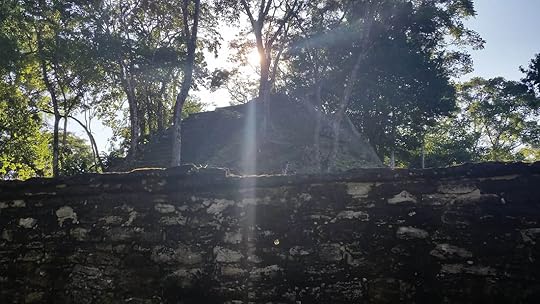
 First of all, as you can tell from the map of our stay in Belize, there's a ton we didn't see of Belize, especially the coastline. Belize is most famous for its barrier reef, islands, atolls, and beaches, none of which Tim and I visited.
First of all, as you can tell from the map of our stay in Belize, there's a ton we didn't see of Belize, especially the coastline. Belize is most famous for its barrier reef, islands, atolls, and beaches, none of which Tim and I visited.
This may sound awful, but at the time, we were a little jaded of touristy and pricy beach spots, having just come from the Yucatan. Instead, we were interested in getting to know the heart, culture, and history of Belize. And so, during our brief stay, we remained inland. My top 5 favorite things about Belize 5) A melting pot of cultures To me, Belize felt more Caribbean than Latin American in many regards. That's because it's a blend of peoples from around the world, including a very prominent Garífuna community (people who emigrated from West Africa), Mennonites from Germany (similar to the Amish), there are people of Mayan descent, Spanish descent, and a mixture of the two, British colonists, and even Asians and Arabs have now joined in the mix.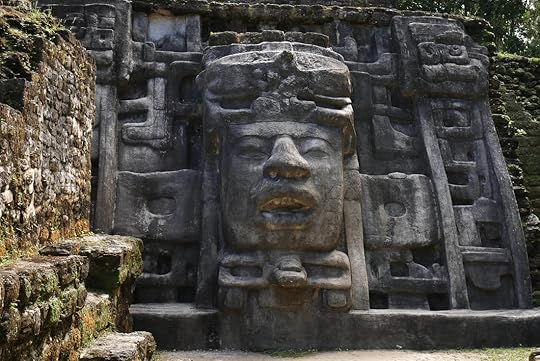 Mask Temple, Lamanai, Belize 4) English!
Mask Temple, Lamanai, Belize 4) English!
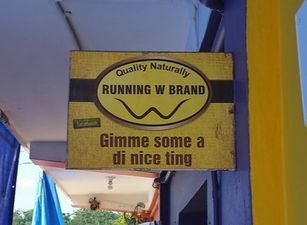 English, but is it really English? Unlike the rest of Central America, English is the official language of Belize and is taught in all public schools. This is because it's a Commonwealth country to the UK, and the Queen of England is proudly displayed on their money. But that doesn't mean I could understand everyone since they often spoke a form of creole to each other, or other languages. Tim and I would joke that since we were leaving Mexico and entering Belize, we were leaving a country where only I could understand the people (I speak Spanish) to go to a country where neither of us could understand the people. Truthfully, I'm sure if we spent more time there, we would get used to it very quickly, and I happened to have really enjoy their beautiful accent. 3) Delicious Food After a few months in Mexico eating like the locals, it was nice to change up the refried beans and tortillas for some traditional Belizean foods I'd never had before: like Johnny Cakes or Fry Jacks, mmmm. Also, we discovered that Chinese restaurants were extremely popular, so popular in fact, sometimes it was hard to find anything else. Plus, if you're in the mood for tacos and other Latin American favorites, they were readily available too. If I had to sum up Belizean cuisine in one word, it would be variety. 2) Welcome to the Jungle
English, but is it really English? Unlike the rest of Central America, English is the official language of Belize and is taught in all public schools. This is because it's a Commonwealth country to the UK, and the Queen of England is proudly displayed on their money. But that doesn't mean I could understand everyone since they often spoke a form of creole to each other, or other languages. Tim and I would joke that since we were leaving Mexico and entering Belize, we were leaving a country where only I could understand the people (I speak Spanish) to go to a country where neither of us could understand the people. Truthfully, I'm sure if we spent more time there, we would get used to it very quickly, and I happened to have really enjoy their beautiful accent. 3) Delicious Food After a few months in Mexico eating like the locals, it was nice to change up the refried beans and tortillas for some traditional Belizean foods I'd never had before: like Johnny Cakes or Fry Jacks, mmmm. Also, we discovered that Chinese restaurants were extremely popular, so popular in fact, sometimes it was hard to find anything else. Plus, if you're in the mood for tacos and other Latin American favorites, they were readily available too. If I had to sum up Belizean cuisine in one word, it would be variety. 2) Welcome to the Jungle 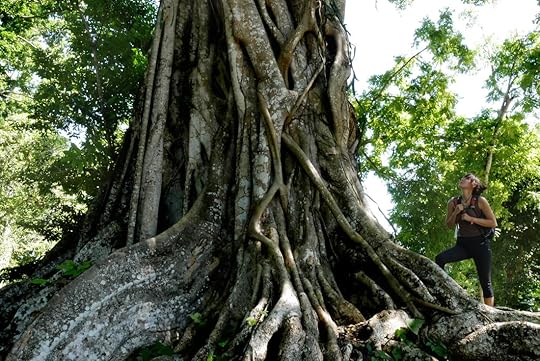
 Belize was our first real experience with the Central American rainforest and all the diverse plants and animals that come with it. As amazing as it was, Tim did not have good luck when it came to the animals. He got swarmed by stinging red ants when he stepped on a nest, he got pooped on by a bird at the border, and again defecated on by a gecko while in a restaurant. Though we heard the eerie cries of the howler monkeys for the first time in Belize, luckily none decided to use us as bathrooms. 1) Incredible Mayan Ruins Some of the most impressive Mayan ruins out there are in Belize, so if you like climbing temples or simply standing in awe at the sheer scope and brilliance of these local artisans and engineers, then Belize is perfect. It's not as swarmed with tourists as the Yucatan, and some sites are actually quite remote, which really makes you feel like Indiana Jones when you arrive and you're one of the few people there. We were even able to have lunch on top of a huge temple all by ourselves. Some you can't climb up, but many you can, and the views are breathtaking. Plus, the sites are extremely well-maintained and preserved. They often have museums, gardened walking paths through the jungle, and even labels on what types of trees and plants you're seeing. If you come to Belize, don't just hang out on the beaches, but take a journey into the jungle and see some of the greatest historic sites Central America has to offer. Some of my not-so-favorite things in Belize were:It did not feel safe to walk around at night, and we were told to be careful once the sun set. Of course, some places seemed safer than others, and I'm sure some parts of Belize are perfectly fine, but in our experience, we did not want to stay out too late at night.It was hot, hotter than I had experienced for the majority of my time in Mexico. Hot and humid, and I think part of this is because unlike Mexico, much of Belize is flat, near the coast, and low in altitude.The roads of Belize were not very developed. We rode on one of Belize's main highways and it was nothing more than a one lane paved road, oftentimes with no paint, signs, or markers. And yes, just like Mexico, there were lots of speed bumps that just came out of nowhere. Luckily though, there didn't seem to be too much traffic in inland Belize, and sometimes I felt like we were the only people on these major highways. Lastly, Belize is expensive. We didn't even go to the coast which is supposedly much worse, and even so, the country can definitely put a dent into your wallet.
Belize was our first real experience with the Central American rainforest and all the diverse plants and animals that come with it. As amazing as it was, Tim did not have good luck when it came to the animals. He got swarmed by stinging red ants when he stepped on a nest, he got pooped on by a bird at the border, and again defecated on by a gecko while in a restaurant. Though we heard the eerie cries of the howler monkeys for the first time in Belize, luckily none decided to use us as bathrooms. 1) Incredible Mayan Ruins Some of the most impressive Mayan ruins out there are in Belize, so if you like climbing temples or simply standing in awe at the sheer scope and brilliance of these local artisans and engineers, then Belize is perfect. It's not as swarmed with tourists as the Yucatan, and some sites are actually quite remote, which really makes you feel like Indiana Jones when you arrive and you're one of the few people there. We were even able to have lunch on top of a huge temple all by ourselves. Some you can't climb up, but many you can, and the views are breathtaking. Plus, the sites are extremely well-maintained and preserved. They often have museums, gardened walking paths through the jungle, and even labels on what types of trees and plants you're seeing. If you come to Belize, don't just hang out on the beaches, but take a journey into the jungle and see some of the greatest historic sites Central America has to offer. Some of my not-so-favorite things in Belize were:It did not feel safe to walk around at night, and we were told to be careful once the sun set. Of course, some places seemed safer than others, and I'm sure some parts of Belize are perfectly fine, but in our experience, we did not want to stay out too late at night.It was hot, hotter than I had experienced for the majority of my time in Mexico. Hot and humid, and I think part of this is because unlike Mexico, much of Belize is flat, near the coast, and low in altitude.The roads of Belize were not very developed. We rode on one of Belize's main highways and it was nothing more than a one lane paved road, oftentimes with no paint, signs, or markers. And yes, just like Mexico, there were lots of speed bumps that just came out of nowhere. Luckily though, there didn't seem to be too much traffic in inland Belize, and sometimes I felt like we were the only people on these major highways. Lastly, Belize is expensive. We didn't even go to the coast which is supposedly much worse, and even so, the country can definitely put a dent into your wallet. 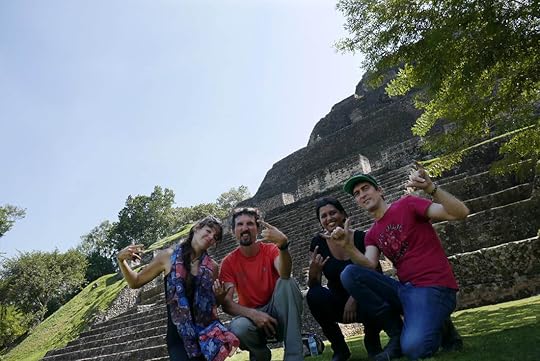 Xunantunich, with our friends Phil and Sapna. All in all, despite its tiny size, Belize is a country that packs a lot of culture, history, and beauty into its borders. It felt like it was its own island, separated from the rest of Central America by language and identity. It was unique, diverse, and proud, and it was always a surprise around every turn.
Xunantunich, with our friends Phil and Sapna. All in all, despite its tiny size, Belize is a country that packs a lot of culture, history, and beauty into its borders. It felt like it was its own island, separated from the rest of Central America by language and identity. It was unique, diverse, and proud, and it was always a surprise around every turn.
Though we could have easily gone straight from Mexico into Guatemala without ever stepping foot in Belize, I am thoroughly grateful that we took the time to explore this dynamic country, and I would recommend it to anyone looking for something special, relaxed, refreshing, and beautiful.

 First of all, as you can tell from the map of our stay in Belize, there's a ton we didn't see of Belize, especially the coastline. Belize is most famous for its barrier reef, islands, atolls, and beaches, none of which Tim and I visited.
First of all, as you can tell from the map of our stay in Belize, there's a ton we didn't see of Belize, especially the coastline. Belize is most famous for its barrier reef, islands, atolls, and beaches, none of which Tim and I visited.This may sound awful, but at the time, we were a little jaded of touristy and pricy beach spots, having just come from the Yucatan. Instead, we were interested in getting to know the heart, culture, and history of Belize. And so, during our brief stay, we remained inland. My top 5 favorite things about Belize 5) A melting pot of cultures To me, Belize felt more Caribbean than Latin American in many regards. That's because it's a blend of peoples from around the world, including a very prominent Garífuna community (people who emigrated from West Africa), Mennonites from Germany (similar to the Amish), there are people of Mayan descent, Spanish descent, and a mixture of the two, British colonists, and even Asians and Arabs have now joined in the mix.
 Mask Temple, Lamanai, Belize 4) English!
Mask Temple, Lamanai, Belize 4) English!
 English, but is it really English? Unlike the rest of Central America, English is the official language of Belize and is taught in all public schools. This is because it's a Commonwealth country to the UK, and the Queen of England is proudly displayed on their money. But that doesn't mean I could understand everyone since they often spoke a form of creole to each other, or other languages. Tim and I would joke that since we were leaving Mexico and entering Belize, we were leaving a country where only I could understand the people (I speak Spanish) to go to a country where neither of us could understand the people. Truthfully, I'm sure if we spent more time there, we would get used to it very quickly, and I happened to have really enjoy their beautiful accent. 3) Delicious Food After a few months in Mexico eating like the locals, it was nice to change up the refried beans and tortillas for some traditional Belizean foods I'd never had before: like Johnny Cakes or Fry Jacks, mmmm. Also, we discovered that Chinese restaurants were extremely popular, so popular in fact, sometimes it was hard to find anything else. Plus, if you're in the mood for tacos and other Latin American favorites, they were readily available too. If I had to sum up Belizean cuisine in one word, it would be variety. 2) Welcome to the Jungle
English, but is it really English? Unlike the rest of Central America, English is the official language of Belize and is taught in all public schools. This is because it's a Commonwealth country to the UK, and the Queen of England is proudly displayed on their money. But that doesn't mean I could understand everyone since they often spoke a form of creole to each other, or other languages. Tim and I would joke that since we were leaving Mexico and entering Belize, we were leaving a country where only I could understand the people (I speak Spanish) to go to a country where neither of us could understand the people. Truthfully, I'm sure if we spent more time there, we would get used to it very quickly, and I happened to have really enjoy their beautiful accent. 3) Delicious Food After a few months in Mexico eating like the locals, it was nice to change up the refried beans and tortillas for some traditional Belizean foods I'd never had before: like Johnny Cakes or Fry Jacks, mmmm. Also, we discovered that Chinese restaurants were extremely popular, so popular in fact, sometimes it was hard to find anything else. Plus, if you're in the mood for tacos and other Latin American favorites, they were readily available too. If I had to sum up Belizean cuisine in one word, it would be variety. 2) Welcome to the Jungle 
 Belize was our first real experience with the Central American rainforest and all the diverse plants and animals that come with it. As amazing as it was, Tim did not have good luck when it came to the animals. He got swarmed by stinging red ants when he stepped on a nest, he got pooped on by a bird at the border, and again defecated on by a gecko while in a restaurant. Though we heard the eerie cries of the howler monkeys for the first time in Belize, luckily none decided to use us as bathrooms. 1) Incredible Mayan Ruins Some of the most impressive Mayan ruins out there are in Belize, so if you like climbing temples or simply standing in awe at the sheer scope and brilliance of these local artisans and engineers, then Belize is perfect. It's not as swarmed with tourists as the Yucatan, and some sites are actually quite remote, which really makes you feel like Indiana Jones when you arrive and you're one of the few people there. We were even able to have lunch on top of a huge temple all by ourselves. Some you can't climb up, but many you can, and the views are breathtaking. Plus, the sites are extremely well-maintained and preserved. They often have museums, gardened walking paths through the jungle, and even labels on what types of trees and plants you're seeing. If you come to Belize, don't just hang out on the beaches, but take a journey into the jungle and see some of the greatest historic sites Central America has to offer. Some of my not-so-favorite things in Belize were:It did not feel safe to walk around at night, and we were told to be careful once the sun set. Of course, some places seemed safer than others, and I'm sure some parts of Belize are perfectly fine, but in our experience, we did not want to stay out too late at night.It was hot, hotter than I had experienced for the majority of my time in Mexico. Hot and humid, and I think part of this is because unlike Mexico, much of Belize is flat, near the coast, and low in altitude.The roads of Belize were not very developed. We rode on one of Belize's main highways and it was nothing more than a one lane paved road, oftentimes with no paint, signs, or markers. And yes, just like Mexico, there were lots of speed bumps that just came out of nowhere. Luckily though, there didn't seem to be too much traffic in inland Belize, and sometimes I felt like we were the only people on these major highways. Lastly, Belize is expensive. We didn't even go to the coast which is supposedly much worse, and even so, the country can definitely put a dent into your wallet.
Belize was our first real experience with the Central American rainforest and all the diverse plants and animals that come with it. As amazing as it was, Tim did not have good luck when it came to the animals. He got swarmed by stinging red ants when he stepped on a nest, he got pooped on by a bird at the border, and again defecated on by a gecko while in a restaurant. Though we heard the eerie cries of the howler monkeys for the first time in Belize, luckily none decided to use us as bathrooms. 1) Incredible Mayan Ruins Some of the most impressive Mayan ruins out there are in Belize, so if you like climbing temples or simply standing in awe at the sheer scope and brilliance of these local artisans and engineers, then Belize is perfect. It's not as swarmed with tourists as the Yucatan, and some sites are actually quite remote, which really makes you feel like Indiana Jones when you arrive and you're one of the few people there. We were even able to have lunch on top of a huge temple all by ourselves. Some you can't climb up, but many you can, and the views are breathtaking. Plus, the sites are extremely well-maintained and preserved. They often have museums, gardened walking paths through the jungle, and even labels on what types of trees and plants you're seeing. If you come to Belize, don't just hang out on the beaches, but take a journey into the jungle and see some of the greatest historic sites Central America has to offer. Some of my not-so-favorite things in Belize were:It did not feel safe to walk around at night, and we were told to be careful once the sun set. Of course, some places seemed safer than others, and I'm sure some parts of Belize are perfectly fine, but in our experience, we did not want to stay out too late at night.It was hot, hotter than I had experienced for the majority of my time in Mexico. Hot and humid, and I think part of this is because unlike Mexico, much of Belize is flat, near the coast, and low in altitude.The roads of Belize were not very developed. We rode on one of Belize's main highways and it was nothing more than a one lane paved road, oftentimes with no paint, signs, or markers. And yes, just like Mexico, there were lots of speed bumps that just came out of nowhere. Luckily though, there didn't seem to be too much traffic in inland Belize, and sometimes I felt like we were the only people on these major highways. Lastly, Belize is expensive. We didn't even go to the coast which is supposedly much worse, and even so, the country can definitely put a dent into your wallet.  Xunantunich, with our friends Phil and Sapna. All in all, despite its tiny size, Belize is a country that packs a lot of culture, history, and beauty into its borders. It felt like it was its own island, separated from the rest of Central America by language and identity. It was unique, diverse, and proud, and it was always a surprise around every turn.
Xunantunich, with our friends Phil and Sapna. All in all, despite its tiny size, Belize is a country that packs a lot of culture, history, and beauty into its borders. It felt like it was its own island, separated from the rest of Central America by language and identity. It was unique, diverse, and proud, and it was always a surprise around every turn.Though we could have easily gone straight from Mexico into Guatemala without ever stepping foot in Belize, I am thoroughly grateful that we took the time to explore this dynamic country, and I would recommend it to anyone looking for something special, relaxed, refreshing, and beautiful.
Published on February 21, 2018 15:05
February 3, 2018
Mexico Magico
By Marisa As our time in Mexico has come to a close, we've reflected on both the magic and the misfortune that we've encountered during our two and half months there (mostly it was magical).
Highlights (and a few not-so-nice adventures) in chronological order -
San Felipe, Baja CaliforniaWaking up every morning to incredible sunrises over the Sea of Cortez while camping on the beach.Tim flying in a motorized hang-gliding thingy.Walking down the beach every day to eat shrimp tacos in San Felipe (for me this was great anyway, Tim doesn’t like seafood, his loss).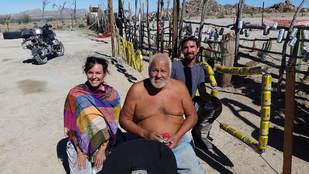 Coco’s Corner, Baja CaliforniaHaving a cold drink with the infamous Coco.Taking a rutted dirt and gravel road to get to Coco’s Corner.
Coco’s Corner, Baja CaliforniaHaving a cold drink with the infamous Coco.Taking a rutted dirt and gravel road to get to Coco’s Corner.
 Gonzaga Bay, Baja California* Being mystified by the floating rocks (they were pumice). Bahia de la Concepción (Conception Bay), Baja California
Gonzaga Bay, Baja California* Being mystified by the floating rocks (they were pumice). Bahia de la Concepción (Conception Bay), Baja California
Swimming at four in the morning in the bioluminescence.Getting up close and personal with a whale shark.Definite negative - having to share our palapa with at least three black widows while camping. San Lucas del Cabo, Baja CaliforniaBig negative - Me (Marisa) getting sick on Halloween night and having to go to the emergency room over night, but luckily, everything was alright and neither of us have experienced any poor health since.
San Lucas del Cabo, Baja CaliforniaBig negative - Me (Marisa) getting sick on Halloween night and having to go to the emergency room over night, but luckily, everything was alright and neither of us have experienced any poor health since.
 Barriles, Baja CaliforniaVisiting our friend Gunner and taking his boat out into the wind and waves. La Paz, Baja California to Los Mochis, SinaloaTaking the freight ferry over the Gulf of California with a bunch of Mexican truck drivers, and trying to sleep on the floor as the ship rocked and swayed all night.
Barriles, Baja CaliforniaVisiting our friend Gunner and taking his boat out into the wind and waves. La Paz, Baja California to Los Mochis, SinaloaTaking the freight ferry over the Gulf of California with a bunch of Mexican truck drivers, and trying to sleep on the floor as the ship rocked and swayed all night.
Barrancas del Cobre a.k.a. Copper Canyon, ChihuahuaTaking El Chepe train through Copper Canyon, a canyon larger than the Grand Canyon.Getting introduced to the traditions of the indigenous Tarahumara people of Creel.Seeing a giant waterfall and cave dwelling on the Tarahumara lands.Meeting a fellow motorcyclist, Chris, who was also going on the train with us to Copper Canyon. Mazatlán, SinaloaChecking out the different clubs of Mazatlán with Chris.
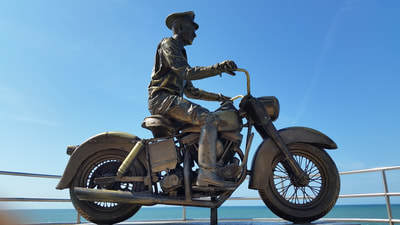

 Mazatlán, Mexico
Mazatlán, Mexico 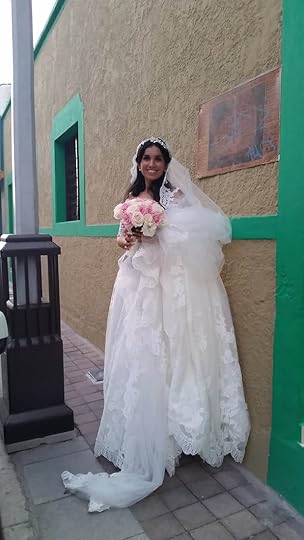 A beautiful bride in Mazatlán Zacatecas, ZacatecasExploring the gold and silver mine in Zacatecas.Being the only foreign tourists at the ruins of La Quemada (our first Mesoamerican ruins).
A beautiful bride in Mazatlán Zacatecas, ZacatecasExploring the gold and silver mine in Zacatecas.Being the only foreign tourists at the ruins of La Quemada (our first Mesoamerican ruins).



 Guadalajara, JaliscoMeeting up with our friend Nat Nagel and exchanging our passion for motorcycles.Making silk screen shirts for Notier’s FrontiersHaving one of the Nat’s boas around my neck, ahhh!
Guadalajara, JaliscoMeeting up with our friend Nat Nagel and exchanging our passion for motorcycles.Making silk screen shirts for Notier’s FrontiersHaving one of the Nat’s boas around my neck, ahhh!



 Comala, ColimaStaying with our family friends: the Nagels, and having a wonderful Thanksgiving and pre-Christmas celebration.Witnessing the nearby volcano puff out smoke on chilly mornings.Helping the local sixth grade class learn about starting their own businesses (business is fun when you can have a pizza party).Watching the horses and cowboys in the local parade (I have a slight obsession with horses).
Comala, ColimaStaying with our family friends: the Nagels, and having a wonderful Thanksgiving and pre-Christmas celebration.Witnessing the nearby volcano puff out smoke on chilly mornings.Helping the local sixth grade class learn about starting their own businesses (business is fun when you can have a pizza party).Watching the horses and cowboys in the local parade (I have a slight obsession with horses).
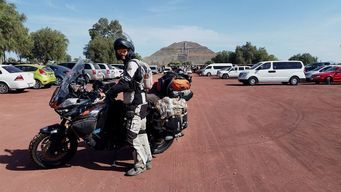 Teotihuacan, State of MexicoClimbing the Pyramid of the Sun at Teotihuacan.
Teotihuacan, State of MexicoClimbing the Pyramid of the Sun at Teotihuacan.
Puebla City, PueblaWaking up to a stunning view of the snowy peak of the volcano Popocatépetl named after the warrior of an old Aztec legend. Beside him lays his love, Iztaccíhuatl, whose body supposedly forms the nearby mountain range.Riding through the intense fog from Puebla into Veracruz. Uxmal, YucatanStanding in awe at the jaw dropping carvings found at our first distinctly Mayan ruins at Uxmal, Yucatan.
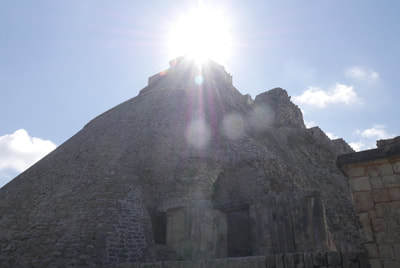
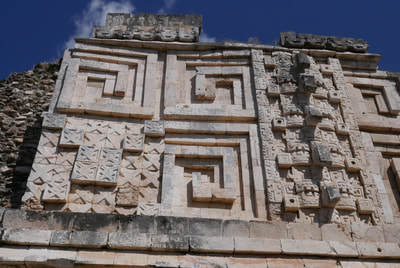
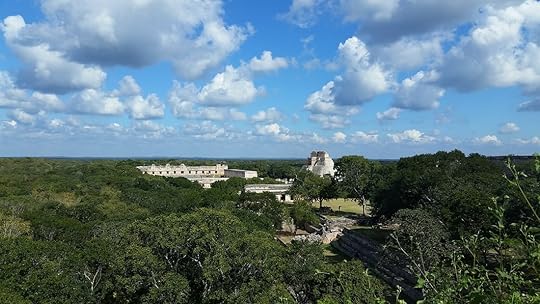 Uxmal, Yucatan, Mexico
Uxmal, Yucatan, Mexico
 Chichen Itza, YucatanBeating the ridiculously long line at Chichen Itza by joining a tour group with some fellow Arkansans. Mérida, YucatanListening to the fireworks go off for New Year’s.
Chichen Itza, YucatanBeating the ridiculously long line at Chichen Itza by joining a tour group with some fellow Arkansans. Mérida, YucatanListening to the fireworks go off for New Year’s.
Playa Del Carmen, Quintana RooMeeting up with Tim’s family and having lazy days on the beach.Touring the beachside Mayan ruins of Tulum and finding that since the Mayans may no longer live there, the iguanas have taken up residence.Getting to know two fellow motorcycle travelers, Phil and Sapna, and deciding to travel with them south and into Belize.

 Chacchoben, Quintana RooExploring the Mayan ruins of Chacchoben with Phil and Sapna (who happen to have an incredible blog), and discovering that the ruins are very impressive and yet unfrequented by tourists.
Chacchoben, Quintana RooExploring the Mayan ruins of Chacchoben with Phil and Sapna (who happen to have an incredible blog), and discovering that the ruins are very impressive and yet unfrequented by tourists.


 Some of the not so pleasant things about our time in Mexico:
Some of the not so pleasant things about our time in Mexico:
Topes! These are speed bumps, and Mexico is full of them. They have big ones, little ones, practically invisible ones, ones with no signage, and even ones that have signs for them but aren’t even there… very sneaky.Tolls, tolls, tolls, and they are not cheap and come about every half hour or so on the major toll roads. As we were crossing Mexico, we averaged about seven tolls a day adding up to about $10-$15 dollars total! And for many of them you have to wait in line - one toll took us more than a half hour to get through. Extremely frustrating!Loud music throughout the day and night and morning and any other moment you can think of. But we quickly learned that when in Mexico, just enjoy the pumping mariachi music as much as you can.Trash along every highway and popular spot, be it a forest, desert, gorgeous shoreline, or even the “Save the Environment” festival going on in San Felipe, which seemed to be just another excuse to throw plastic bags, styrofoam cups, and bottles into the ocean. Very sad. This is not just a problem that Mexico faces, and it could be due to a lack of education, or perhaps a lack of enforcing fines for littering, or a lack of garbage pickup services, or simply a sign of poverty. But I think Mexico’s government needs to rethink how to tackle the garbage that is polluting its natural beauty.Not being able to throw toilet paper into toilets anymore. Why has the rest of the world not figured this out yet?And finally, the worst of all things that we encountered in Mexico were the police who pull you over simply looking to extort money from you. I understand that they don’t get paid much and are doing a difficult job, but taking bribes through tricks and lies by abusing their power as police officers is unacceptable in my opinion, and it certainly does not give their country a good reputation to visitors. The horrors of going through these experiences where I am being threatened by the police for simply being foreign (because the locals often get away with breaking the laws) will be something I never forget about Mexico. I’m not saying that my country is any better in their treatment to Mexicans in the US, and it may be argued that we are much worse, but it isn’t right whoever is doing it. I believe that bribes and corruption and prejudiced enforcing of laws is always wrong. Was Zorro real? I'm not sure, but the town of El Fuerte seems to think he was.
Was Zorro real? I'm not sure, but the town of El Fuerte seems to think he was.  I'm not sure what this is supposed to be, but you've got to love Mexico! Things I learned about Mexico:It’s not as dangerous as many Americans will tell you it is. Take the fear mongering news and statistics with a grain of salt. And as always, travel smart, keep your adventures for the daytime, don’t be flashy with your wealth, learn a bit of Spanish, and listen to your intuition, and your stay in Mexico should be just as magical as ours was.The coast is hot and humid of course, but many parts of the country can get pretty cold in the winter time because of their high elevation. Guadalajara is practically at the same height as Denver (a mile high) and Mexico City lies much higher at 7,350 ft. (2,240 meters). Central Mexico can be quite mountainous and beautiful, not to be missed, but bring a jacket.Mexican cuisine is not just tacos and burritos. There is a great assortment of delicious food throughout the many diverse regions of Mexico. Some of our favorites included tortas (hot sandwiches in big, often freshly-baked bolillo bread), gorditas (thick corn tortillas stuffed with an assortment of items such as seasoned meats, beans, cheese, and potatoes), and birria (a meat stew eaten with tortillas that can be made with any meat). And then in Baja we came across mega burros (giant donkeys) such as the one pictured below. Yes, Tim and I ate it all. Let’s just say, Mexican food is amazing.
I'm not sure what this is supposed to be, but you've got to love Mexico! Things I learned about Mexico:It’s not as dangerous as many Americans will tell you it is. Take the fear mongering news and statistics with a grain of salt. And as always, travel smart, keep your adventures for the daytime, don’t be flashy with your wealth, learn a bit of Spanish, and listen to your intuition, and your stay in Mexico should be just as magical as ours was.The coast is hot and humid of course, but many parts of the country can get pretty cold in the winter time because of their high elevation. Guadalajara is practically at the same height as Denver (a mile high) and Mexico City lies much higher at 7,350 ft. (2,240 meters). Central Mexico can be quite mountainous and beautiful, not to be missed, but bring a jacket.Mexican cuisine is not just tacos and burritos. There is a great assortment of delicious food throughout the many diverse regions of Mexico. Some of our favorites included tortas (hot sandwiches in big, often freshly-baked bolillo bread), gorditas (thick corn tortillas stuffed with an assortment of items such as seasoned meats, beans, cheese, and potatoes), and birria (a meat stew eaten with tortillas that can be made with any meat). And then in Baja we came across mega burros (giant donkeys) such as the one pictured below. Yes, Tim and I ate it all. Let’s just say, Mexican food is amazing. 
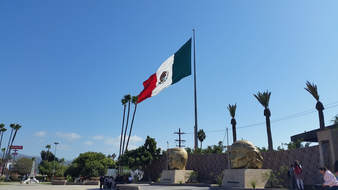 Overall, despite its few setbacks, Mexico was certainly a magical place that we enjoyed thoroughly. Anyone who is interested in visiting a country that is vibrant, spicy, and proud, historic and modern all at once, and whose people are friendly, welcoming, laid back, and love to have a good time, then Mexico is the place for you!
Overall, despite its few setbacks, Mexico was certainly a magical place that we enjoyed thoroughly. Anyone who is interested in visiting a country that is vibrant, spicy, and proud, historic and modern all at once, and whose people are friendly, welcoming, laid back, and love to have a good time, then Mexico is the place for you!
Our next adventures will be heading south through Belize and onto the rest of Central America. Stay tuned…
Highlights (and a few not-so-nice adventures) in chronological order -
San Felipe, Baja CaliforniaWaking up every morning to incredible sunrises over the Sea of Cortez while camping on the beach.Tim flying in a motorized hang-gliding thingy.Walking down the beach every day to eat shrimp tacos in San Felipe (for me this was great anyway, Tim doesn’t like seafood, his loss).
 Coco’s Corner, Baja CaliforniaHaving a cold drink with the infamous Coco.Taking a rutted dirt and gravel road to get to Coco’s Corner.
Coco’s Corner, Baja CaliforniaHaving a cold drink with the infamous Coco.Taking a rutted dirt and gravel road to get to Coco’s Corner.
 Gonzaga Bay, Baja California* Being mystified by the floating rocks (they were pumice). Bahia de la Concepción (Conception Bay), Baja California
Gonzaga Bay, Baja California* Being mystified by the floating rocks (they were pumice). Bahia de la Concepción (Conception Bay), Baja CaliforniaSwimming at four in the morning in the bioluminescence.Getting up close and personal with a whale shark.Definite negative - having to share our palapa with at least three black widows while camping.
 San Lucas del Cabo, Baja CaliforniaBig negative - Me (Marisa) getting sick on Halloween night and having to go to the emergency room over night, but luckily, everything was alright and neither of us have experienced any poor health since.
San Lucas del Cabo, Baja CaliforniaBig negative - Me (Marisa) getting sick on Halloween night and having to go to the emergency room over night, but luckily, everything was alright and neither of us have experienced any poor health since.
 Barriles, Baja CaliforniaVisiting our friend Gunner and taking his boat out into the wind and waves. La Paz, Baja California to Los Mochis, SinaloaTaking the freight ferry over the Gulf of California with a bunch of Mexican truck drivers, and trying to sleep on the floor as the ship rocked and swayed all night.
Barriles, Baja CaliforniaVisiting our friend Gunner and taking his boat out into the wind and waves. La Paz, Baja California to Los Mochis, SinaloaTaking the freight ferry over the Gulf of California with a bunch of Mexican truck drivers, and trying to sleep on the floor as the ship rocked and swayed all night. Barrancas del Cobre a.k.a. Copper Canyon, ChihuahuaTaking El Chepe train through Copper Canyon, a canyon larger than the Grand Canyon.Getting introduced to the traditions of the indigenous Tarahumara people of Creel.Seeing a giant waterfall and cave dwelling on the Tarahumara lands.Meeting a fellow motorcyclist, Chris, who was also going on the train with us to Copper Canyon. Mazatlán, SinaloaChecking out the different clubs of Mazatlán with Chris.



 Mazatlán, Mexico
Mazatlán, Mexico  A beautiful bride in Mazatlán Zacatecas, ZacatecasExploring the gold and silver mine in Zacatecas.Being the only foreign tourists at the ruins of La Quemada (our first Mesoamerican ruins).
A beautiful bride in Mazatlán Zacatecas, ZacatecasExploring the gold and silver mine in Zacatecas.Being the only foreign tourists at the ruins of La Quemada (our first Mesoamerican ruins).



 Guadalajara, JaliscoMeeting up with our friend Nat Nagel and exchanging our passion for motorcycles.Making silk screen shirts for Notier’s FrontiersHaving one of the Nat’s boas around my neck, ahhh!
Guadalajara, JaliscoMeeting up with our friend Nat Nagel and exchanging our passion for motorcycles.Making silk screen shirts for Notier’s FrontiersHaving one of the Nat’s boas around my neck, ahhh!



 Comala, ColimaStaying with our family friends: the Nagels, and having a wonderful Thanksgiving and pre-Christmas celebration.Witnessing the nearby volcano puff out smoke on chilly mornings.Helping the local sixth grade class learn about starting their own businesses (business is fun when you can have a pizza party).Watching the horses and cowboys in the local parade (I have a slight obsession with horses).
Comala, ColimaStaying with our family friends: the Nagels, and having a wonderful Thanksgiving and pre-Christmas celebration.Witnessing the nearby volcano puff out smoke on chilly mornings.Helping the local sixth grade class learn about starting their own businesses (business is fun when you can have a pizza party).Watching the horses and cowboys in the local parade (I have a slight obsession with horses).
 Teotihuacan, State of MexicoClimbing the Pyramid of the Sun at Teotihuacan.
Teotihuacan, State of MexicoClimbing the Pyramid of the Sun at Teotihuacan.Puebla City, PueblaWaking up to a stunning view of the snowy peak of the volcano Popocatépetl named after the warrior of an old Aztec legend. Beside him lays his love, Iztaccíhuatl, whose body supposedly forms the nearby mountain range.Riding through the intense fog from Puebla into Veracruz. Uxmal, YucatanStanding in awe at the jaw dropping carvings found at our first distinctly Mayan ruins at Uxmal, Yucatan.



 Uxmal, Yucatan, Mexico
Uxmal, Yucatan, Mexico
 Chichen Itza, YucatanBeating the ridiculously long line at Chichen Itza by joining a tour group with some fellow Arkansans. Mérida, YucatanListening to the fireworks go off for New Year’s.
Chichen Itza, YucatanBeating the ridiculously long line at Chichen Itza by joining a tour group with some fellow Arkansans. Mérida, YucatanListening to the fireworks go off for New Year’s. Playa Del Carmen, Quintana RooMeeting up with Tim’s family and having lazy days on the beach.Touring the beachside Mayan ruins of Tulum and finding that since the Mayans may no longer live there, the iguanas have taken up residence.Getting to know two fellow motorcycle travelers, Phil and Sapna, and deciding to travel with them south and into Belize.


 Chacchoben, Quintana RooExploring the Mayan ruins of Chacchoben with Phil and Sapna (who happen to have an incredible blog), and discovering that the ruins are very impressive and yet unfrequented by tourists.
Chacchoben, Quintana RooExploring the Mayan ruins of Chacchoben with Phil and Sapna (who happen to have an incredible blog), and discovering that the ruins are very impressive and yet unfrequented by tourists.


 Some of the not so pleasant things about our time in Mexico:
Some of the not so pleasant things about our time in Mexico:Topes! These are speed bumps, and Mexico is full of them. They have big ones, little ones, practically invisible ones, ones with no signage, and even ones that have signs for them but aren’t even there… very sneaky.Tolls, tolls, tolls, and they are not cheap and come about every half hour or so on the major toll roads. As we were crossing Mexico, we averaged about seven tolls a day adding up to about $10-$15 dollars total! And for many of them you have to wait in line - one toll took us more than a half hour to get through. Extremely frustrating!Loud music throughout the day and night and morning and any other moment you can think of. But we quickly learned that when in Mexico, just enjoy the pumping mariachi music as much as you can.Trash along every highway and popular spot, be it a forest, desert, gorgeous shoreline, or even the “Save the Environment” festival going on in San Felipe, which seemed to be just another excuse to throw plastic bags, styrofoam cups, and bottles into the ocean. Very sad. This is not just a problem that Mexico faces, and it could be due to a lack of education, or perhaps a lack of enforcing fines for littering, or a lack of garbage pickup services, or simply a sign of poverty. But I think Mexico’s government needs to rethink how to tackle the garbage that is polluting its natural beauty.Not being able to throw toilet paper into toilets anymore. Why has the rest of the world not figured this out yet?And finally, the worst of all things that we encountered in Mexico were the police who pull you over simply looking to extort money from you. I understand that they don’t get paid much and are doing a difficult job, but taking bribes through tricks and lies by abusing their power as police officers is unacceptable in my opinion, and it certainly does not give their country a good reputation to visitors. The horrors of going through these experiences where I am being threatened by the police for simply being foreign (because the locals often get away with breaking the laws) will be something I never forget about Mexico. I’m not saying that my country is any better in their treatment to Mexicans in the US, and it may be argued that we are much worse, but it isn’t right whoever is doing it. I believe that bribes and corruption and prejudiced enforcing of laws is always wrong.
 Was Zorro real? I'm not sure, but the town of El Fuerte seems to think he was.
Was Zorro real? I'm not sure, but the town of El Fuerte seems to think he was.  I'm not sure what this is supposed to be, but you've got to love Mexico! Things I learned about Mexico:It’s not as dangerous as many Americans will tell you it is. Take the fear mongering news and statistics with a grain of salt. And as always, travel smart, keep your adventures for the daytime, don’t be flashy with your wealth, learn a bit of Spanish, and listen to your intuition, and your stay in Mexico should be just as magical as ours was.The coast is hot and humid of course, but many parts of the country can get pretty cold in the winter time because of their high elevation. Guadalajara is practically at the same height as Denver (a mile high) and Mexico City lies much higher at 7,350 ft. (2,240 meters). Central Mexico can be quite mountainous and beautiful, not to be missed, but bring a jacket.Mexican cuisine is not just tacos and burritos. There is a great assortment of delicious food throughout the many diverse regions of Mexico. Some of our favorites included tortas (hot sandwiches in big, often freshly-baked bolillo bread), gorditas (thick corn tortillas stuffed with an assortment of items such as seasoned meats, beans, cheese, and potatoes), and birria (a meat stew eaten with tortillas that can be made with any meat). And then in Baja we came across mega burros (giant donkeys) such as the one pictured below. Yes, Tim and I ate it all. Let’s just say, Mexican food is amazing.
I'm not sure what this is supposed to be, but you've got to love Mexico! Things I learned about Mexico:It’s not as dangerous as many Americans will tell you it is. Take the fear mongering news and statistics with a grain of salt. And as always, travel smart, keep your adventures for the daytime, don’t be flashy with your wealth, learn a bit of Spanish, and listen to your intuition, and your stay in Mexico should be just as magical as ours was.The coast is hot and humid of course, but many parts of the country can get pretty cold in the winter time because of their high elevation. Guadalajara is practically at the same height as Denver (a mile high) and Mexico City lies much higher at 7,350 ft. (2,240 meters). Central Mexico can be quite mountainous and beautiful, not to be missed, but bring a jacket.Mexican cuisine is not just tacos and burritos. There is a great assortment of delicious food throughout the many diverse regions of Mexico. Some of our favorites included tortas (hot sandwiches in big, often freshly-baked bolillo bread), gorditas (thick corn tortillas stuffed with an assortment of items such as seasoned meats, beans, cheese, and potatoes), and birria (a meat stew eaten with tortillas that can be made with any meat). And then in Baja we came across mega burros (giant donkeys) such as the one pictured below. Yes, Tim and I ate it all. Let’s just say, Mexican food is amazing. 
 Overall, despite its few setbacks, Mexico was certainly a magical place that we enjoyed thoroughly. Anyone who is interested in visiting a country that is vibrant, spicy, and proud, historic and modern all at once, and whose people are friendly, welcoming, laid back, and love to have a good time, then Mexico is the place for you!
Overall, despite its few setbacks, Mexico was certainly a magical place that we enjoyed thoroughly. Anyone who is interested in visiting a country that is vibrant, spicy, and proud, historic and modern all at once, and whose people are friendly, welcoming, laid back, and love to have a good time, then Mexico is the place for you!Our next adventures will be heading south through Belize and onto the rest of Central America. Stay tuned…
Published on February 03, 2018 07:10
December 11, 2017
Comfort in Colima
By Tim Notier As I sit comfortably in a house we are staying at for a couple weeks, at no cost, I am able to reflect on the last 3 months of travel. Our trip has already piled on more memories than I could have hoped for.
We rode through some of the most beautiful states in the U.S. We were able to fix the bike when things went astray, and I survived a bad case of poison oak that spread to my unmentionables. Marisa and I successfully made it to a different country, only a small task to some people, but a huge accomplishment for my previously naked passport. While in this foreign land of Mexico, we T-Boned a whale shark in a kayak, swam in bioluminescence waters, and I flew around in a small engine hang-glider over San Felipe.
Once our fun in Baja was over, we caught a ferry to mainland Mexico, took a train through a canyon more vast than the Grand Canyon, and rode through scenery so flush with vegetation and forests it looked like we rode into Pandora. Marisa took the lead role of translator and organizer of everything from getting gas to hotel accommodations as my Spanish is still no bueno. (I just had to correct my spelling from ‘bueano’ to ‘bueno’, just to let you know where my Spanish level is at). I’m scrapping the bottom here, but I am able to buy my pack of cigarettes every other day.
I keep telling myself I will learn Spanish, and quit smoking, but I never take the effort of doing either. Now we find ourselves in a place of complete comfort, in Colima. I am able to relax and try to catch up on some writing, and promoting my book with a basic amount of effort (this isn’t a shameless plug, it’s just what I have been doing. Besides, if it was a shameless plug, I would have provided a link
here
).
Now we find ourselves in a place of complete comfort, in Colima. I am able to relax and try to catch up on some writing, and promoting my book with a basic amount of effort (this isn’t a shameless plug, it’s just what I have been doing. Besides, if it was a shameless plug, I would have provided a link
here
).
Marisa and I have traveled slowly, and I am glad for that. Traveling at a pace that lets us have a deeper look into our surroundings, as well as ourselves. We are working as a team, taking on different roles when the scenario calls for our individual skill set. I am still ecstatic without having any regrets for leaving our old life behind for this new adventure. Everyday there is something new to look at with awe. Today it happens to be an active volcano.
Life is good.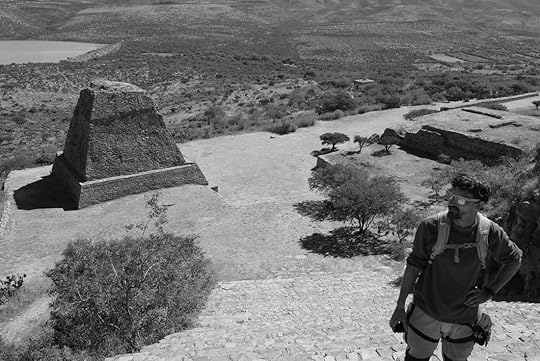
We rode through some of the most beautiful states in the U.S. We were able to fix the bike when things went astray, and I survived a bad case of poison oak that spread to my unmentionables. Marisa and I successfully made it to a different country, only a small task to some people, but a huge accomplishment for my previously naked passport. While in this foreign land of Mexico, we T-Boned a whale shark in a kayak, swam in bioluminescence waters, and I flew around in a small engine hang-glider over San Felipe.
Once our fun in Baja was over, we caught a ferry to mainland Mexico, took a train through a canyon more vast than the Grand Canyon, and rode through scenery so flush with vegetation and forests it looked like we rode into Pandora. Marisa took the lead role of translator and organizer of everything from getting gas to hotel accommodations as my Spanish is still no bueno. (I just had to correct my spelling from ‘bueano’ to ‘bueno’, just to let you know where my Spanish level is at). I’m scrapping the bottom here, but I am able to buy my pack of cigarettes every other day.
I keep telling myself I will learn Spanish, and quit smoking, but I never take the effort of doing either.
 Now we find ourselves in a place of complete comfort, in Colima. I am able to relax and try to catch up on some writing, and promoting my book with a basic amount of effort (this isn’t a shameless plug, it’s just what I have been doing. Besides, if it was a shameless plug, I would have provided a link
here
).
Now we find ourselves in a place of complete comfort, in Colima. I am able to relax and try to catch up on some writing, and promoting my book with a basic amount of effort (this isn’t a shameless plug, it’s just what I have been doing. Besides, if it was a shameless plug, I would have provided a link
here
).Marisa and I have traveled slowly, and I am glad for that. Traveling at a pace that lets us have a deeper look into our surroundings, as well as ourselves. We are working as a team, taking on different roles when the scenario calls for our individual skill set. I am still ecstatic without having any regrets for leaving our old life behind for this new adventure. Everyday there is something new to look at with awe. Today it happens to be an active volcano.
Life is good.

Published on December 11, 2017 15:43
November 2, 2017
Baja Bound
By Tim Notier The States had proved themselves to be as amazing and hospitable as we could have hoped. We met wonderful people, saw nature in all of its glory, and shook some excess bugs out of our gear, the bike’s load, and literally out of our jackets and helmets.
A big shout out to the people who assisted us and invited us into their homes along the way, Dana Dahl and her husband William (where we almost declared legal residency because we stayed for so long), Paul Sprague (who insisted on paying for our hotel room for a night), and Jim Piatt, along with his fellow riders of the Pokka Dots: Brian Small and Ron Hess. Jim provided us with a pair of passenger foot pegs that miraculously fit (with a little grinding). We have now dubbed the bike “Peg-asus” because now she has wings!
There are too many people to thank individually, but we are grateful to every individual who provided kindness and assistance, down to just good conversations.
But now we are in Mexico, having made it all the way to Cabo. Once past Tijuana, Baja opened its window to the wondrous views it has to offer. The nights were spent at a variety of playas, each seemingly more beautiful than the last. Eating at small family owned stands, constant swimming in the Sea of Cortez, and reading books while we lay in our hammock is how we spent the majority of our days. It was true relaxation mixed in with random bonus gifts, including our Texan neighbor, Captain Gunner, letting us use his kayak-a-maran in the Bay of Conception and having a whale shark swim directly underneath us. A truly once in a lifetime experience. In the same bay, bioluminescence sparkled in the water as we swam at 4am. Everything seemed magical. Almost magical, with a couple scratches to the flawless facade. The first of the mishaps was that my fork seal started to leak, it streamed down the fork with enough oil to splash onto my bash plate while riding. The wide collective knowledge of Facebook banded together on a post I listed, and confirmed how to easily remedy the problem at no cost. But I was premature in taking their advice, and sought out a shop to look at the seal. The shop that was “3 blocks away” turned out to no longer exist, and during my trek into the night in La Paz in search for the shop, we were pulled over for “speeding”. I paid off the bribe, as that was all that it was, and paid WAY too much money in the exchange for my license back. Lesson learned, I broke every rule I had created for myself: 1. No riding at night, 2. Don’t travel with excessive amounts of cash, 3. Wear all the gear all the time, and 4. Only give the International Driver’s License along with a photo copy of my real license to any “suspect” police officers. With the same leaking fork, we went back to the hotel with a lot less currency.
I fixed the oil leak the next day with the suggestions from fellow adventure motorcyclists. I cut a tool out of a plastic bottle, and then swept 360 degrees between the seal and the fork, removing the gunk that caused a gap letting a little oil leak. As of now, it worked.
The second scary moment was on Halloween; Marisa had been experiencing a massive amount of pain in her abdomen. She dealt with it as long as she could for days, taking pain pills but clearly in misery as she curled over on the bed moaning. Fearing the pain was greater than a UTI, we hailed a taxi to go to the nearest hospital.
The examination room consisted of a bed, covered in a used sheet that had mystery dried blood on it, and a grungy bathroom with a toilet that leaked when flushed. Someone else’s cloths were folded in the corner of the bathroom as Marisa had to change into the hospital gown.
Marisa was blinded by pain and wanted the suffering to just go away, so she did not notice her blood dripping down her arm where they were taking a sample, onto the sheet, then to the floor next to other splatters from pervious patents. But I was truly hoping that the talk about her appendix having possibly burst, and the surgery that would have to be performed if it did, was not the reason for her pain, because this was no place for a surgery. X-rays and blood tests would have to be performed, and I was told I could hug her, then to please wait outside.
As I sat outside and smoked half a pack of cigarettes over the next hour, the doctor finally waived me back inside. Marisa’s appendix had not burst, and she was feeling a lot better, possibly due to the drip of medication they were now feeding into her arm. To be sure she would remain comfortable, and to give her a second round of antibiotics, she was to stay overnight, and I was to take a taxi back to the hotel.
Once back at the hotel, I continued to text Marisa to get the play by play analysis. There would be a new doctor coming in for the night shift, and based on her condition, they would either let her come back to the hotel around 8pm, or keep her overnight. Eight P.M. came and went, then finally after 10pm, the good news was I could go pick her up!
For 2,500 pesos (which was about a hundred dollars, and much less than the bribe I paid) Marisa had multiple blood tests, an X-Ray, and had been treated with pain medication. A healthier version of Marisa was able to go back to the hotel with me.
Halloween had proven to be quit a scary day for us. #wsite-video-container-421734732193292761{ background: url(//www.weebly.comhttp://www.notiersfront... } #video-iframe-421734732193292761{ background: url(//cdn2.editmysite.com/images/util/video... } #wsite-video-container-421734732193292761, #video-iframe-421734732193292761{ background-repeat: no-repeat; background-position:center; } @media only screen and (-webkit-min-device-pixel-ratio: 2), only screen and ( min-device-pixel-ratio: 2), only screen and ( min-resolution: 192dpi), only screen and ( min-resolution: 2dppx) { #video-iframe-421734732193292761{ background: url(//cdn2.editmysite.com/images/util/video... background-repeat: no-repeat; background-position:center; background-size: 70px 70px; } }
A big shout out to the people who assisted us and invited us into their homes along the way, Dana Dahl and her husband William (where we almost declared legal residency because we stayed for so long), Paul Sprague (who insisted on paying for our hotel room for a night), and Jim Piatt, along with his fellow riders of the Pokka Dots: Brian Small and Ron Hess. Jim provided us with a pair of passenger foot pegs that miraculously fit (with a little grinding). We have now dubbed the bike “Peg-asus” because now she has wings!
There are too many people to thank individually, but we are grateful to every individual who provided kindness and assistance, down to just good conversations.
But now we are in Mexico, having made it all the way to Cabo. Once past Tijuana, Baja opened its window to the wondrous views it has to offer. The nights were spent at a variety of playas, each seemingly more beautiful than the last. Eating at small family owned stands, constant swimming in the Sea of Cortez, and reading books while we lay in our hammock is how we spent the majority of our days. It was true relaxation mixed in with random bonus gifts, including our Texan neighbor, Captain Gunner, letting us use his kayak-a-maran in the Bay of Conception and having a whale shark swim directly underneath us. A truly once in a lifetime experience. In the same bay, bioluminescence sparkled in the water as we swam at 4am. Everything seemed magical. Almost magical, with a couple scratches to the flawless facade. The first of the mishaps was that my fork seal started to leak, it streamed down the fork with enough oil to splash onto my bash plate while riding. The wide collective knowledge of Facebook banded together on a post I listed, and confirmed how to easily remedy the problem at no cost. But I was premature in taking their advice, and sought out a shop to look at the seal. The shop that was “3 blocks away” turned out to no longer exist, and during my trek into the night in La Paz in search for the shop, we were pulled over for “speeding”. I paid off the bribe, as that was all that it was, and paid WAY too much money in the exchange for my license back. Lesson learned, I broke every rule I had created for myself: 1. No riding at night, 2. Don’t travel with excessive amounts of cash, 3. Wear all the gear all the time, and 4. Only give the International Driver’s License along with a photo copy of my real license to any “suspect” police officers. With the same leaking fork, we went back to the hotel with a lot less currency.
I fixed the oil leak the next day with the suggestions from fellow adventure motorcyclists. I cut a tool out of a plastic bottle, and then swept 360 degrees between the seal and the fork, removing the gunk that caused a gap letting a little oil leak. As of now, it worked.
The second scary moment was on Halloween; Marisa had been experiencing a massive amount of pain in her abdomen. She dealt with it as long as she could for days, taking pain pills but clearly in misery as she curled over on the bed moaning. Fearing the pain was greater than a UTI, we hailed a taxi to go to the nearest hospital.
The examination room consisted of a bed, covered in a used sheet that had mystery dried blood on it, and a grungy bathroom with a toilet that leaked when flushed. Someone else’s cloths were folded in the corner of the bathroom as Marisa had to change into the hospital gown.
Marisa was blinded by pain and wanted the suffering to just go away, so she did not notice her blood dripping down her arm where they were taking a sample, onto the sheet, then to the floor next to other splatters from pervious patents. But I was truly hoping that the talk about her appendix having possibly burst, and the surgery that would have to be performed if it did, was not the reason for her pain, because this was no place for a surgery. X-rays and blood tests would have to be performed, and I was told I could hug her, then to please wait outside.
As I sat outside and smoked half a pack of cigarettes over the next hour, the doctor finally waived me back inside. Marisa’s appendix had not burst, and she was feeling a lot better, possibly due to the drip of medication they were now feeding into her arm. To be sure she would remain comfortable, and to give her a second round of antibiotics, she was to stay overnight, and I was to take a taxi back to the hotel.
Once back at the hotel, I continued to text Marisa to get the play by play analysis. There would be a new doctor coming in for the night shift, and based on her condition, they would either let her come back to the hotel around 8pm, or keep her overnight. Eight P.M. came and went, then finally after 10pm, the good news was I could go pick her up!
For 2,500 pesos (which was about a hundred dollars, and much less than the bribe I paid) Marisa had multiple blood tests, an X-Ray, and had been treated with pain medication. A healthier version of Marisa was able to go back to the hotel with me.
Halloween had proven to be quit a scary day for us. #wsite-video-container-421734732193292761{ background: url(//www.weebly.comhttp://www.notiersfront... } #video-iframe-421734732193292761{ background: url(//cdn2.editmysite.com/images/util/video... } #wsite-video-container-421734732193292761, #video-iframe-421734732193292761{ background-repeat: no-repeat; background-position:center; } @media only screen and (-webkit-min-device-pixel-ratio: 2), only screen and ( min-device-pixel-ratio: 2), only screen and ( min-resolution: 192dpi), only screen and ( min-resolution: 2dppx) { #video-iframe-421734732193292761{ background: url(//cdn2.editmysite.com/images/util/video... background-repeat: no-repeat; background-position:center; background-size: 70px 70px; } }
Published on November 02, 2017 13:52



